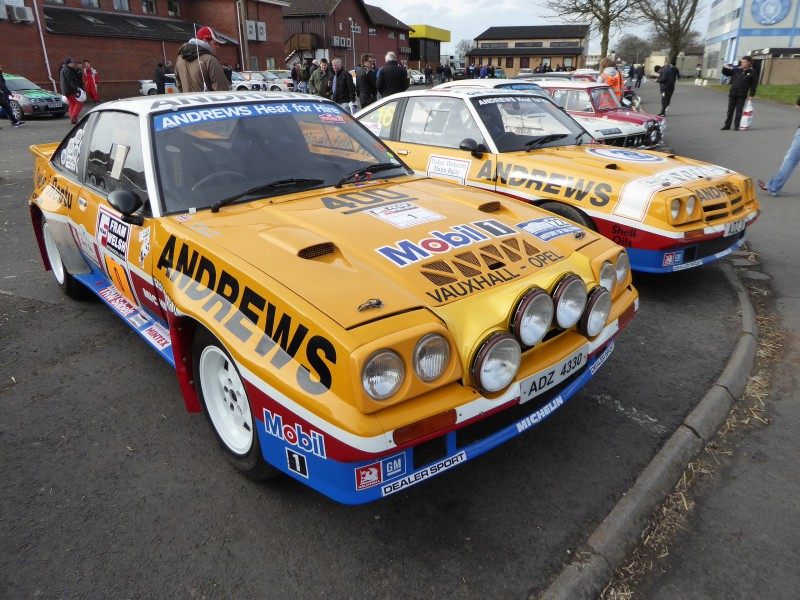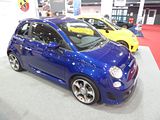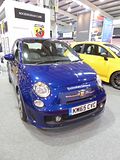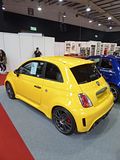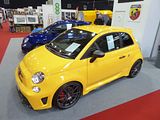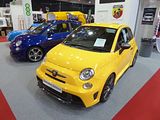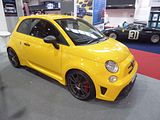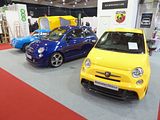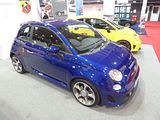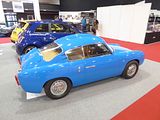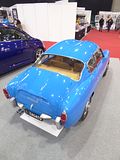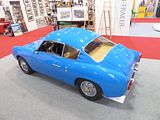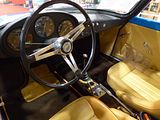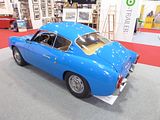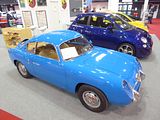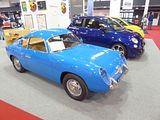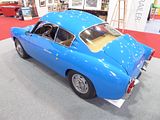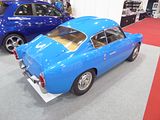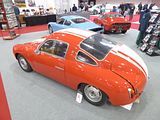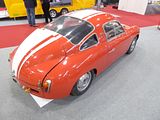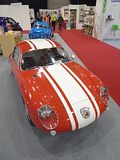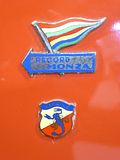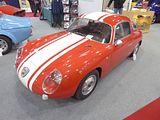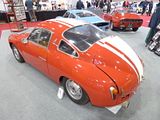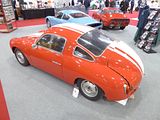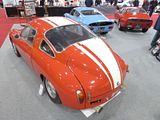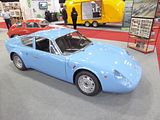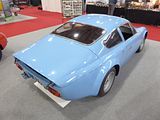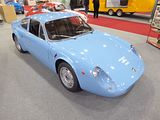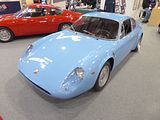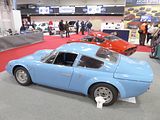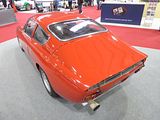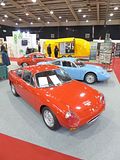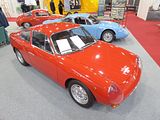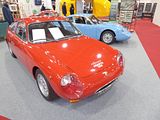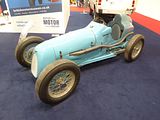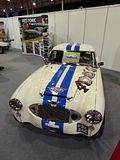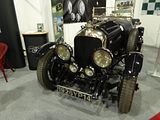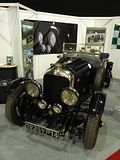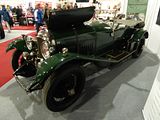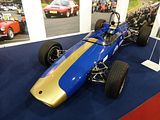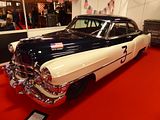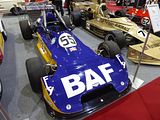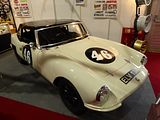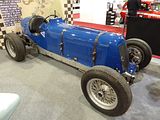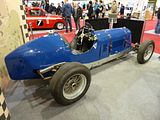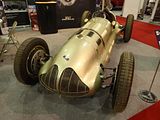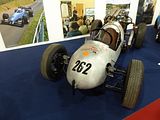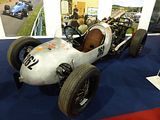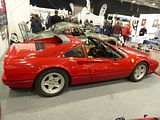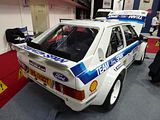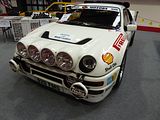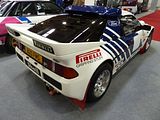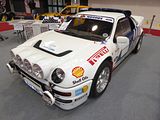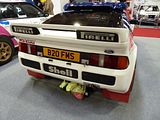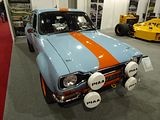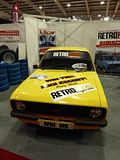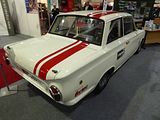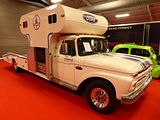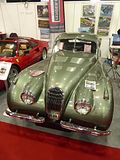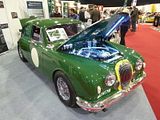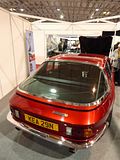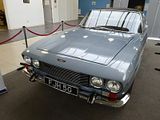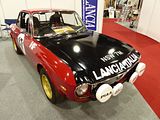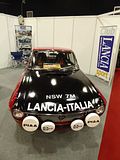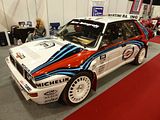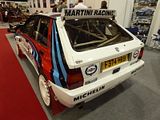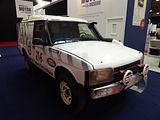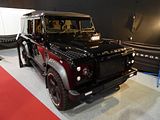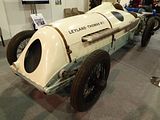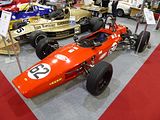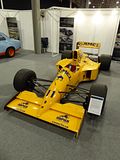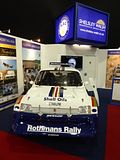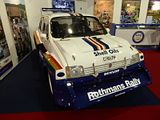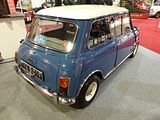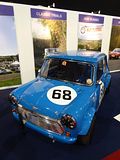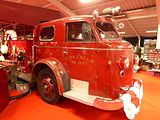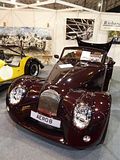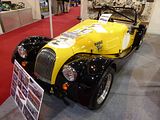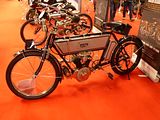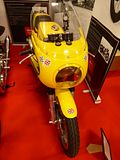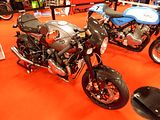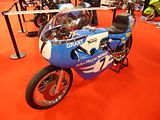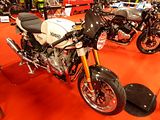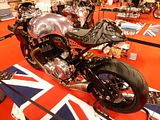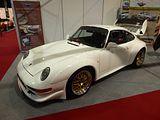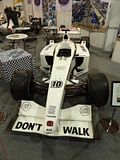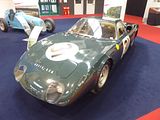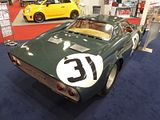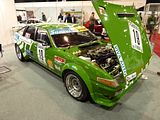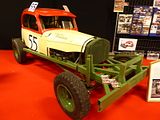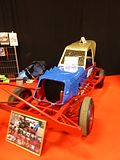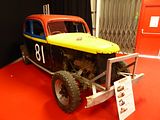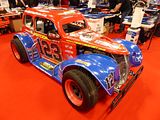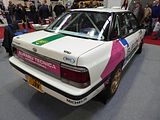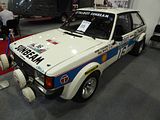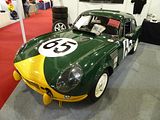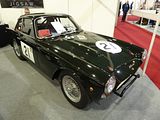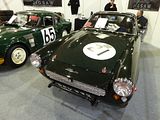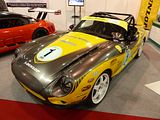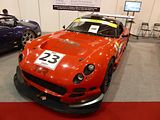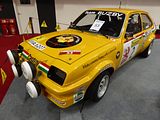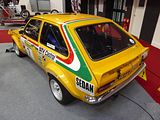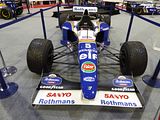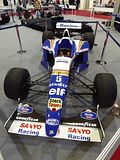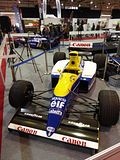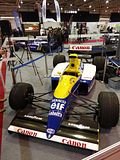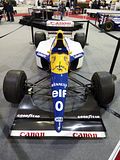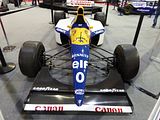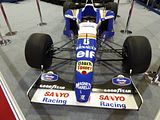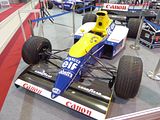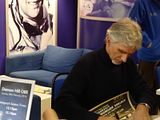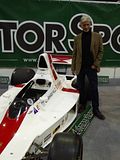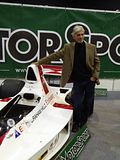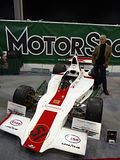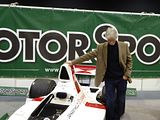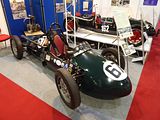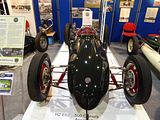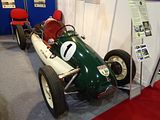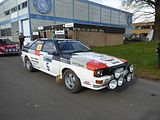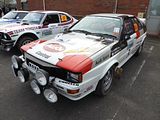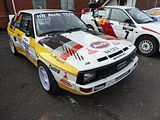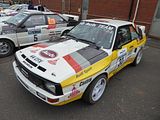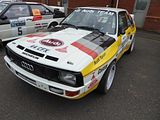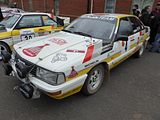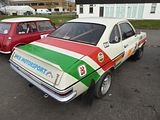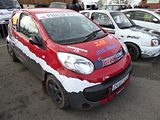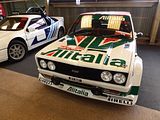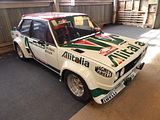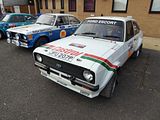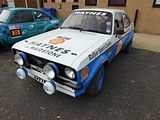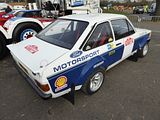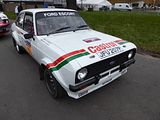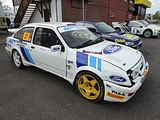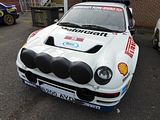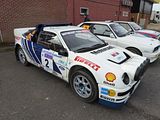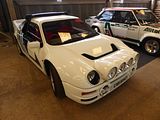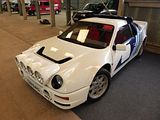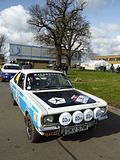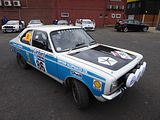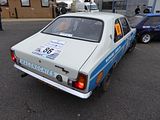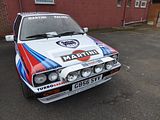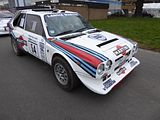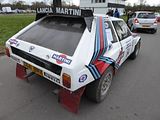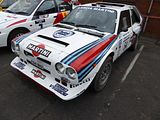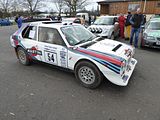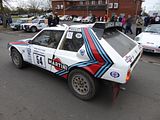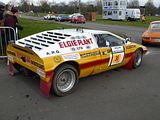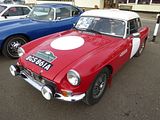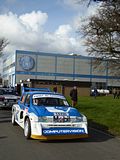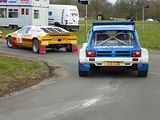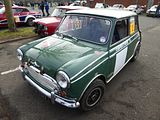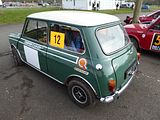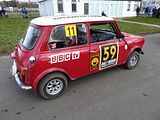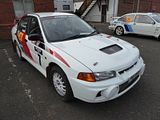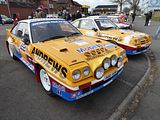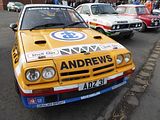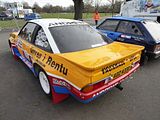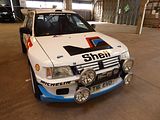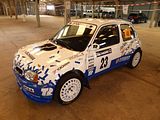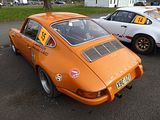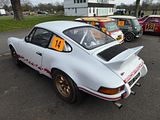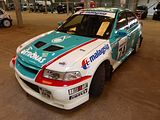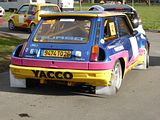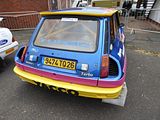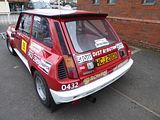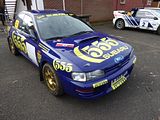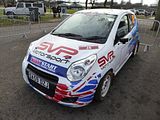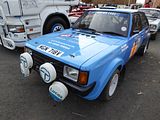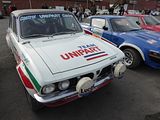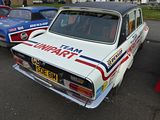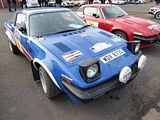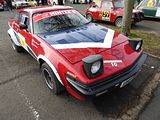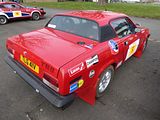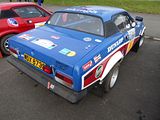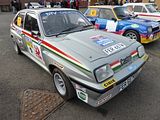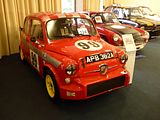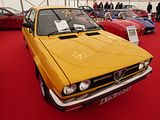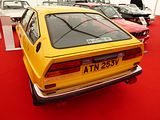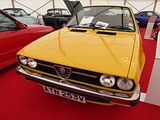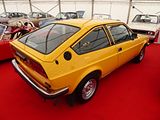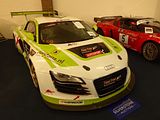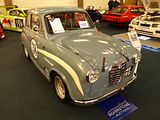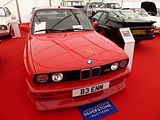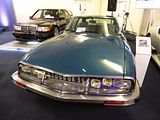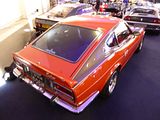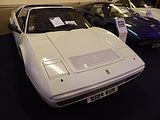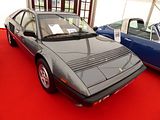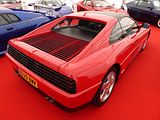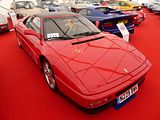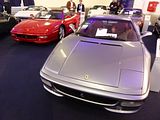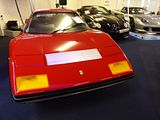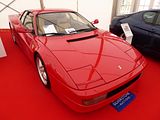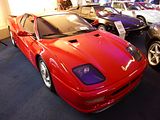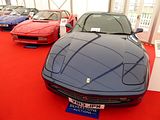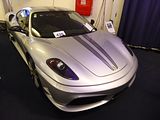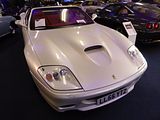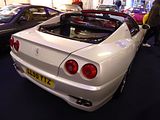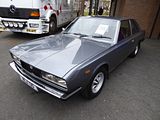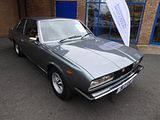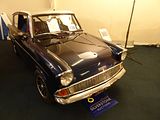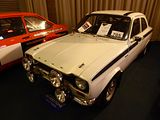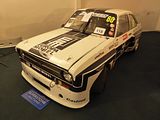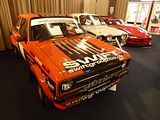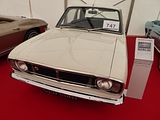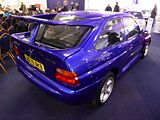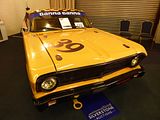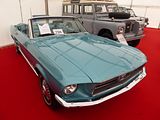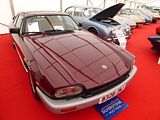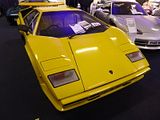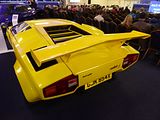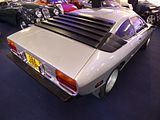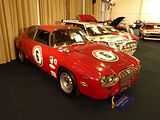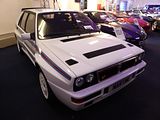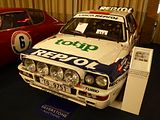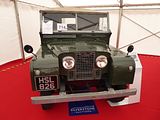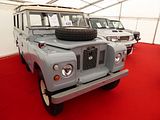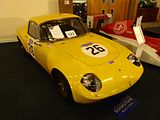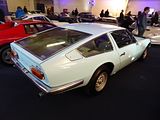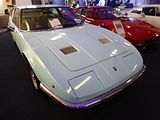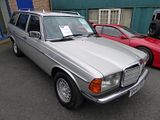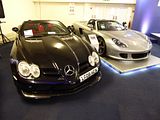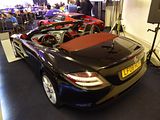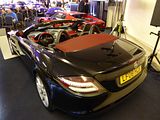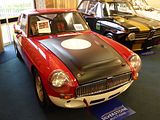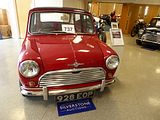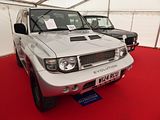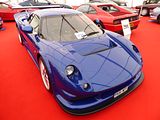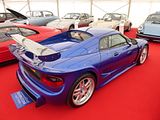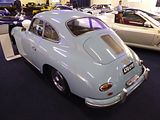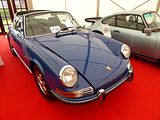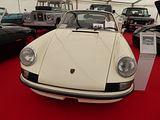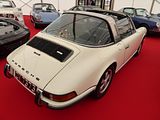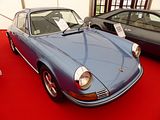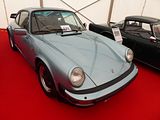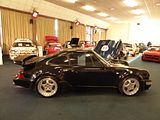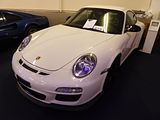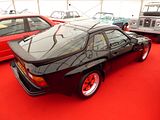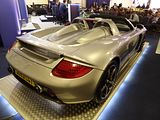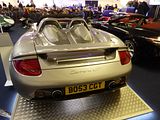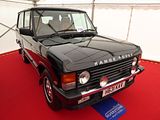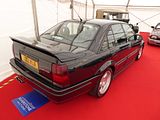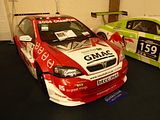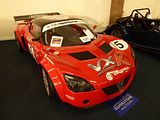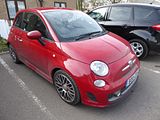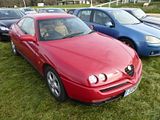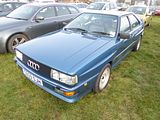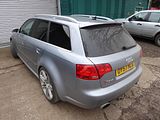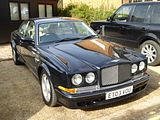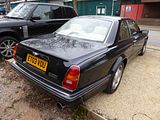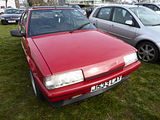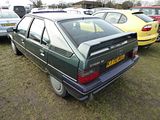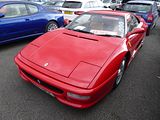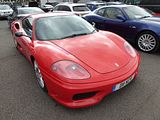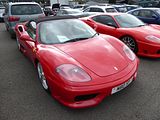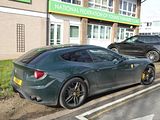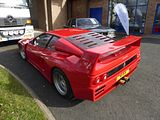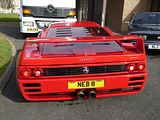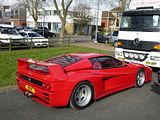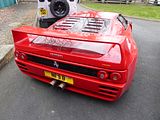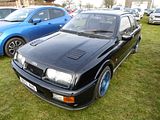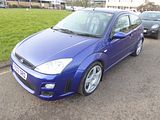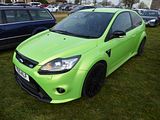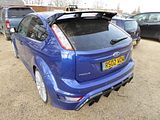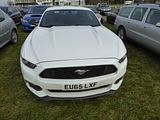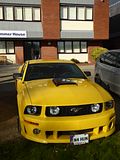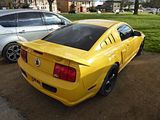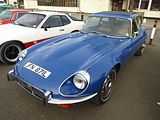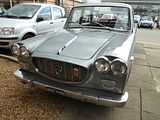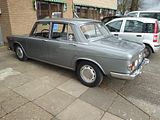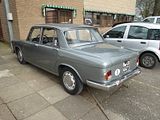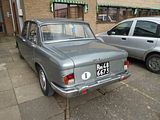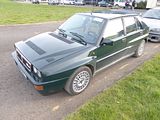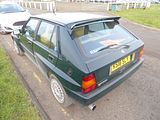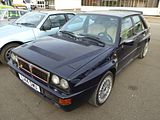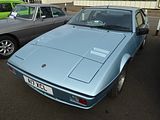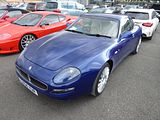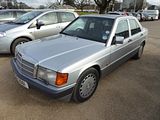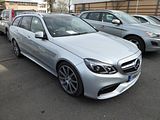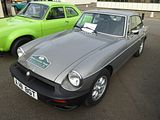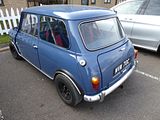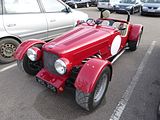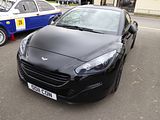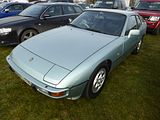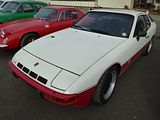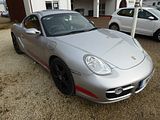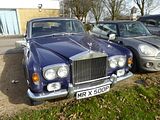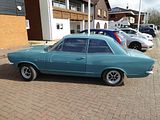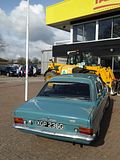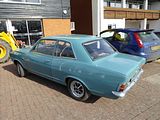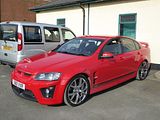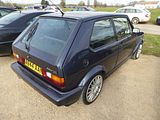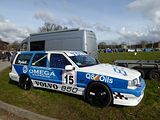2016 marks the 10th time that I have attended the Race Retro event that takes place at Stoneleigh Park every February. During that time, it has established itself firmly in the UK’s events calendar, attracting both a wide variety of exhibits, an array of personalities connected with motor sport and plenty of show go-ers who come to see the variety of cars, which range from the familiar to the less well-known, and the relatively recent to those which go back to the beginnings of people entering competitions that involve the motor vehicle. Couple the disparate genres, from rallying to Formula 1, Stock Cars to grass-roots motor sports, with a number of other displays including a few brand new cars, and action outside and you have all the ingredients required for an interesting day out. Having established a formula that works, the organisers have not changed much in recent years, though of course the displays tend to be different every year, so whilst I knew what to expect, the specifics were still a surprise as I wandered around the four indoor halls and venture outside. There was plenty to attract my camera, as this report will evidence. Enjoy!
ABARTH
One of the first stands I found, before the crowds did, this was a joint effort between Rockingham Cars of Corby and Middle Barton Garage, renowned specialists in Classic Abarths, so there was a nice mix of old and new to see here. The new cars were both 500-based, as that is all that Abarth is offering at present, in advance of the forthcoming 124 Spider. The Podium Blue car is a regular 595 Competizione, very similar to my own, whereas the Modena Yellow car is one of the recently announced 695 Biposto Record Edition.
Oldest of the classic models was this 1957 750 GT Zagato. It belongs to Australian Wes Price, who recently joined the Abarth Owners Club, tantalising us with pictures of his car, so it was nice to be able to see it in the metal. The first Abarth 750 GT appeared in early 1956, and was the first Abarth product to use standard Fiat bodywork, that of the little 600 saloon. Fiat delivered these cars incomplete, to make it easier and more cost effective for Abarth to carry out their performance modifications. Rather than the 633 cc original or Abarth’s own 710 cc model, the engine now displaced 747 cc thanks to a one millimetre wider bore and a stroke increased by four millimetres. Sharper cams, lighter flywheel, a bigger carburettor, and a myriad other traditional tuning tricks were employed; as a result power nearly doubled, up from 21.5 to 40 bhp. Claimed top speed was 80 mph. As well as the “standard” car, a special model was then built with a Zagato body, known as the Fiat Abarth 750 GT Zagato. It was launched at the 1955 Salon di Torino. The original model was also offered in a more luxurious variant for export (called “America”, as it was almost strictly meant for the United States) and a stripped down model with lower, uncovered headlamps and smaller taillights for the domestic Italian market. The “America” also has a different layout around the rear license plate. The all-aluminium bodywork has Zagato’s famous “double-bubble” design and Abarth’s tuned derivazione engine with 43 bhp. Aside from the floorpan, not much of the Fiat 600 remains in use for these cars. It had a top speed of around 90 mph and proved popular. Around 600 were sold. By the time of the appearance of the Abarth Zagato Record Monza 750 Bialbero, the bodywork had been unified into a separate model with a rather large hump on the engine lid, made necessary by the taller twin-cam motor. There were then three distinct models 750 “Double Bubble”, 750 Record Monza and 750 “Sestrieie”, this last having a single cam pushrod engine and the majority built with a steel body and a very small number of Alloy cars, just one of which is known to exist today. The 750 GT Bialbero model appeared at the 1958 Turin Show; along with various alterations to the bodywork, it had the new twin-cam engine with 57 bhp at 7000 rpm. The first series constituted 100 cars, enough to homologate the car for the Gran Turismo competition category. The “Record Monza” was the most successful racing Abarth in the USA under the Franklin D. Roosevelt Jr Racing team, (Abarth cars winning over 700 races worldwide), including both Sebring with the 750cc Bialbero engine and Daytona under 1000cc races in 1959 widely believed to have had the first 982cc Bialbero engine. The Sestriere had upright headlights and two very large air intakes on the engine lid much wider than a double bubble. The Sestriere was believed to be the last model produced for Abarth by Zagato, due to disagreements between Abarth and Zagato.
Next up was a 1000 Bialbero. Although this looks quite similar to the Zagato cars, look more closely and you will see that the body is different, with the Zagato signature “double bubble” roof flattened out. These cars were a development of the 750 GT Zagato with a twin cam engine, with the body evolved by Sibona and Basono into the Bialbero 700 and 1000 models. and were first seen in 1960. They are very rare these days.
Although Abarth is best known for its Fiat-based products in the late 1950s and early 1960s, there were collaborations with others as well, and of these. the Abarth-Simca is perhaps the best known. Abarth and Henri Pigozzi, the charismatic boss of Simca, reached agreement to collaborate in 1961, with the new Simca 1000 forming the basis for the new car. The result, using the Simca’s chassis, engine and gearbox, all heavily modified by Abarth, was first seen at the 1962 Geneva Show, with a body style that looked like no Simca product. The first cars had a 1300 engine, but, as these cars were intended for racing, it was not long before a more powerful model was released. The first upgrade was to a 1600cc, with these cars available from early 1963, but the 1600GT had a very short life, as the rules changed, with an announcement that the Gran Turismo 1600cc category would end in the summer of that year, hence the rapid development of the more potent 2 litre cars. The 2000GT was shown at the 1963 Geneva Show, but it was not until early 1964 before the first cars were delivered. The cars were entered for races through to the end of the 1968 season. The car seen here was a 1300GT model.
The red car looks very similar, but this is in fact even rarer, and is a Radbourne Abarth. These were produced in the UK, and as you might imagine, there is quite a complicated story around the project which created this car and a handful of others. The car is owned by Lincoln Small, who is the co-founder of Radbourne Racing. Like many of us, he grew up passionately interested in cars, and by the time he was about 15, he concluded that what he really lusted after were Italian cars. As soon as he was old enough, be bought a Fiat 600 from Jack Barclay in London, who, as well as being known for specialising in Rolls-Royce and Bentley had a Fiat concession. Not longer after, with his brother Geoff, and John Anstead, in September 1965, he formed Radbourne. Initially, it operated solely as a fiat dealership, in Isleworth, but the firm later moved to Holland Park, where they had a showroom and a workshop. They were also entering the British Saloon Car Championship at this time, and not getting a lot of attention. However, at the same time, they came across a character called Wally Pratt, who also had a Fiat 600, but this one had some Abarth bits on it, and he kept winning things, like the 850cc class at the Sevenoaks and District Sprint or the Woburn Park hillclimb, and they discovered that he was being showered with gifts from Abarth, just for winning. It would later emerge that Abarth had an agreement with Fiat that would pay a sum of Lira every time a Fiat-powered Abarth won a motor sport event. With the initial concession for Abarth in the UK which had been held by Tony Crook, of Bristol Cars fame, now dissolved following a disagreement, the Radbourne Racing guys decided that Abarth was perhaps worth pursuing, so they took a Fiat 2100 Estate and a trailer and headed over to Turin, to meet Carlo Abarth himself. The upshot was that they got the UK concession, and also an 1000 Berlina for Geoff and John to race. They also ran an 850TC and contested the 500km European Touring Car Championship at Snetterton, where they won their class. They would go on to race 595s and 695s as well in various championships. Abarth wanted them to sell sports racers, which were very expensive, though they did shift a few, and they bought some secondhand ones from Enzo Osella before he became a constructor in his own right. The racing cars did not make a profit, but they did bring in a lot of publicity, and in the end Radbourne reached an agreement that they could build Abarths under licence, which they did: 595s, 68s, 850TCs, 1000 OTs, all the well known cars that you see here from time to time. When on a factory visit, they noticed a small batch of incomplete Abarth-Simca models, and, seizing the opportunity, Lincoln Small negotiated a deal for 30 bodyshells. They decided to build them with a cheaper pushrod engine rather than the expensive twin-cam which was part of the original project, and they chose the unit from the Fiat 124 saloon. It took 15 months of engineering. For a start, the unit was now back to front compared to its original installation, so they needed a special bell-housing to mate it to a Fiat 850 gearbox, featuring a higher final drive ratio. The standard 1197cc engine was enlarged to 1280cc, and had a higher compression cylinder head, which raised power from 60 to 75 bhp. This car also has twin down-draught Weber carburettors on it and has gained a few other tweaks on the way, which means it now has a quoted 0 – 60 time of 7,5 seconds, as opposed to the 10,2 that was originally quoted. The prototype was completed in mid-1968. Technically, what they offered was a kit, for which they charged £1350, but this was little more than a ruse to avoid Purchase Tax, much as Lotus did with the Elan. Radbourne offered a completion service, and every customer took them up on it. Although there had been talk of building 125 cars a year, this was never likely, and the reality is that the project almost bankrupted the firm. They had to pull the plug on the venture, with the final 9 cars proving almost impossible to sell, one of them going for just £750 at auction, just so they could off-load it. Unused bodyshells were sold, and went all around the world. Radbourne did bounce back after this story, as they had the UK concession for Weber carburettors, as well as Cromodora and Borani, as well as being the UK importer of the Ferves Ranger, a Fiat 500-based off-roader. They produced a twin cam Fiat 124SS before Fiat did something similar with the 124 Special T, and then they made a business converting Fiat X1/9s to right hand, which gave them another opportunity to get back into racing, when they took on one of Gian Paolo Dallaro’s X1/9s,, in which they installed their own engine. By this time, their principal racing driver was one Steve Soper. Small acquired this car in 1984, the third that was built and it is apparently one of just 3 that are in the UK. It’s not for sale, but if you did want one (and who wouldn’t?), the estimated value now is around £130 – 150k
AUSTIN
This Austin Seven Special was on the British Motor Museum stand. The diminutive Seven was a perfect base for relatively affordable motor sport, and many Specials like this were produced, were the standard bodywork was cast aside, in favour of something much smaller, lighter and more aerodynamic. Many people also worked on extracting more power from the 747cc engines as well, by dint of all the usual sort of tricks.
AUSTIN HEALEY
These 100M and 3000 rally cars were on stands promoting classic car rallies.
BENTLEY
There were a couple of classic Bentleys from the glory days of the 1920s and 30s. The car with French plates on it dates from 1926 and is a 4.5 litre model. The other one is a 1929 car, also a 3 litre, with a Vanden Plas body.
BRABHAM
This 1968 Brabham BT21-B was one of three cars on the Shelsley Walsh stand.
CADILLAC
CHEVRON
This is a B34, dating from 1976. The B34 was designed in 1975 as a Formula Atlantic racing car, but when the Formula 3 European Championship was extended in 1976 with more races than 1975, it was decided in the winter of 1975/1976 to convert the B34 to Formula 3. First rides on a test car were successful and Derek Bennett consistently developed the racing car. Unlike the Formula Atlantic car, which was powered by a Hart engine, the Formula 3 car had one from Toyota. The factory supported the Italian trivellato team in the European Championship and Riccardo Patrese was victorious in Zandvoort, Enna, Monza and Kassel-Calden with the B34 in the Formula 3 European championship. In the British Formula 3 Championship, Rupert Keegan and Geoff Lee were able to celebrate runaway victories and the B34 became one of the best-selling Chevron racing cars ever.
ELVA
This Courier Mark IV, dating from 1964, was used when new as an FIA Race Car.
ERA
ERA was founded by Humphrey Cook, Raymond Mays, and Peter Berthon in November 1933 and established in Bourne, Lincolnshire, next to Eastgate House, the family home of Raymond Mays. Their ambition was to manufacture and campaign a team of single seater racing cars capable of upholding British prestige in Continental European racing. With the cost of competing in full Grand Prix racing prohibitive, ERA’s efforts were targeted at the smaller voiturette—1500cc supercharged—class of motor racing, the Formula 2 equivalent of the day. Humphrey Cook financed the operation—using the wealth from the family drapery business, Cook, Son & Co., of St Paul’s Churchyard, London. Peter Berthon was responsible for the overall design of the cars, while Raymond Mays became its principal driver, having already successfully raced several other makes including Vauxhall, Bugatti and Riley. A new chassis was conceived by British designer Reid Railton (who had also successfully designed the Bluebird land speed record cars for Malcolm Campbell) and was constructed by Thomson & Taylor at Brooklands. The engine was based on the well proven Riley 6-cylinder unit, albeit this was modified in a number of significant ways. A stronger forged crankshaft with a large centre Hyatt roller bearing was made and an entirely new aluminium cylinder head designed. The engine was supercharged using a bespoke supercharger designed by Murray Jamieson who had worked with Mays & Berthon on the White Riley. The ERA engine was designed around three capacities—a base 1500cc, an 1100cc and also was capable of being expanded up to 2000 cc. It ran on methanol and in its 1500cc form was capable of producing around 180–200bhp with in excess of 250–275bhp in 2000cc form. The panel-beating brothers George and Jack Gray hand-fashioned the new car’s single-seater bodywork, to a design credited to a Mr Piercy who had previously designed the bodywork for Malcolm Campbell’s ‘Bluebird’ record breaker. The unveiling of the first ERA—chassis R1A—to the press and public took place at Brooklands on 22 May 1934. After initial chassis handling problems, which required a number of modifications, soon ERA had a winning formula. By the end of the year ERAs had scored notable victories against many more established marques. In 1935, in a major race at the Nürburgring, ERAs took first, third, fourth and fifth places. Through the remainder of the decade, with drivers of the calibre of Dick Seaman in the team, ERA dominated voiturette racing. Every car that was built thereafter is different, so the cars are all referred to by their unique name. There were two of them here, on the VSCC stand. Older of the pair was R8C. I’ve seen this car at Shelsley and Prescott many times before. Like most cars of this era, it has had a chequered past. Originally, it was R8B, and was bought new by Earl Howe in 1936. After some successes with the car, he joined the works team in 1937. After a serious crash at Brooklands that year the car was upgraded to C specification and Earl Howe continued to enjoy success with it, now called R8C, until right to the end of his racing career at the outbreak of WWII. It was rebuilt in 1983 to the 1938/39 specification.
Also present was the more modern E-Type ERA. This car appeared just before the Second World War but was never fully developed as the Second World War brought a halt to motor racing in Europe, and the team’s Bourne site was sold to the Bus operator Delaine who occupied adjacent premises. The original building is still in use today by Delaine as an office block. By the time racing resumed in the late 1940s Berthon and Mays had moved on to the British Racing Motors (BRM) project.
FARLEY
Second car on the Shelsley stand was this, a 1947 Farley Jap Special, a “Shelsley Special”.
FERRARI
308 GTS
FORD
There were two Fords here neither of which achieved their full potential, one through no real fault of its own: the ill-fated Escort RS1700T which never really achieved anything and the fabulous RS200, the car Ford designed as its Group B competitor and which was ready just as the series was axed. Whilst the RS200 is a car that you do see at events like this, I was not sure I’d ever seen an RS1700T. Some research after the event turned up that it is literally unique. Rallied briefly in South Africa before disappearing off the grid, the current owner found it in a barn in Germany, and is in the process of restoring it to exactly how Ari Vatanen tested it, even having period accurate tyres made up and buying the correct fire extinguishers!
Far more successful were the other sporting Fords to be found in the exhibition halls: Mark 1 and 2 Escorts and a Mark 1 Lotus Cortina as well as a Mustang.
More unusual were a couple of American Pickups, an F100 from the 1950s and a 1960s F350 converted for carrying race cars or bikes.
JAGUAR
XK120 FHC
Mark 2
JENSEN
There were a couple of examples of the well-regarded Interceptor here, an enduring classic that has far more appeal now than when it was new (not an uncommon story). It was launched as a replacement for the rather gawky looking CV8 of the early 1960s. After a false start when a car with the same name was shown in 1965, which received a massive “thumbs down”, Jensen went to Italy to find a new stylist for another attempt. They ended up with Carozzeria Touring, who produced a stunning looking grand tourer which, although sharing some styling cues with other models that they had designed, had a style all of its own, and they then approached another, Vignale, to build the bodies before they would be shipped back to West Bromwich for final assembly. As with the CV8, motive power came from a large Chrysler V8 engine, which gave the car effortless performance, and a somewhat prodigious thirst. The original specification included electric windows, reclining front seats, a wood rimmed steering wheel, radio with twin speakers, reversing lights and an electric clock. Power steering was included as standard from September 1968. The Mark II was announced in October 1969, with slightly revised styling around the headlamps, front grille and bumper and revised rear lights. The interior was substantially revised in order to meet US regulations, and air conditioning was an option. The Mark III, introduced in 1971, revised the front grille, headlamp finishers and bumper treatment again. It had GKN alloy wheels and air conditioning as standard, and revised seats. It was divided into G-, H-, and J-series depending on the production year. The 6.3 litre engine was superseded by the 7.2 litre in 1971. A Convertible version was premiered in 1974,. but just 267 were built, and then in 1975 a Coupe model was shown, effectively a fixed roof version of the Convertible, just 60 of which were made as by this time, the company had fallen on hard times due to the then world-wide recession, and massive and costly reliability problems with its Jensen-Healey sports car. It was placed into receivership and the receivers allowed production to be wrapped up using the available cache of parts. Production of the Interceptor ended in 1976. Enthusiasm for the car remained, though, so in the late 1980s, a group of investors stepped in and re-launched production of the Interceptor, as the Series 4, back as a low-volume hand built and bespoke affair, marketed in a similar way to Bristol, with a price (£70,000 and more) to match. Though the body remained essentially the same as the last of the main production run of series 3; the engine was a much smaller Chrysler supplied 5.9 litre unit which used more modern controls to reduce emissions comparatively and still produce about 230 hp. In addition, the interior was slightly re-designed with the addition of modern “sports” front seats as opposed to the armchair style of the earlier models, as well as a revised dashboard and electronics. The then owner sold up in 1990 to an engineering company believed to be in a stronger position to manufacture the car which lasted until 1993 with approximately 36 cars built, and while work commenced on development of a Series 5 Interceptor, once again receivers were called in and the company was liquidated. Even that was not quite the end of the story, as the Jensen specialist based at Cropredy Bridge has made a business out of rebuilding original Interceptors using modern components, with a General Motors supplied 6.2 litre LS3 engine and transmission from a Chevrolet Corvette. In May 2010, Jensen International Automotive was set up, with the financial backing and know-how of Carphone Warehouse founder and chairman Charles Dunstone who joined its board of directors. A small number of Jensen Interceptor Ss, which had started production under a previous company, are being completed by Jensen International Automotive (JIA), in parallel with JIA’s own production of the new Jensen Interceptor R; deliveries of the latter started at the beginning of 2011. One of the cars seen here was an Interceptor S.
KIEFT
Kieft Cars, founded by Cyril Kieft, was a British car company that built Formula Three racing cars and some road going sports cars in a factory in Derry St, Wolverhampton. Cyril Kieft was born in Swansea and spent his early working life in the steel industry. After the second World war he started up his own company Cyril Kieft and Co Ltd in Bridgend, Glamorgan making forgings and pressings including components for the motor industry. He had an interest in motor racing and when the Marwyn company, who had built Formula Three cars, failed he bought the designs and used them as a base for his own 500cc car. Several of these were sold and some competition success resulted. Publicity was gained by successful attempts on a series of records at Autodrome de Montlhéry in France. One of the drivers was Stirling Moss who explained the shortcomings of the cars. As a result of this a new design was acquired, Moss and his manager Ken Gregory became directors, whilst the company moved to new premises at Reliance Works in Derry Street, Wolverhampton. A new design by Gordon Bedson, who had joined the company from the aircraft industry, was produced in time for the 1951 Whit Monday Meeting at Goodwood where it won the Formula Three event driven by Moss. Don Parker was employed as works driver and won the British Formula Three championships in 1952 and 1953. In 1954 Kieft started to make a two-seater sports car which could also be used as a road car. Using a Coventry Climax FWA engine, all independent suspension using transverse leaf springs at the rear and a lightweight glass fibre body the car was really a racing car and at £1560 it is doubtful if any were bought just as road cars. The company was losing money and at the end of 1954 Kieft sold the company to racing driver Berwyn Baxter. Kieft Cars left Wolverhampton in 1956 and moved to nearby Birmingham where they concentrated on preparing and tuning other makes of cars. There were plans for a return to making Kieft cars but these failed to materialise. The company was sold again in 1960 and changed its name to Burmans. Kieft Sports Car Co. Ltd. is now owned by Canadian Peter Schömer and based out of Chichester, West Sussex near Goodwood. There is a new Sports Racer in the works using a Coventry Climax FPF 2.5 litre twin cam engine called the Kieft-Climax.
LANCIA
Two icons from Lancia’s illustrious rallying past were here: a Fulvia HF and the Delta Integrale.
LAND ROVER
LEYLAND-THOMAS SPECIAL
A recreation of J.G. Parry-Thomas’ record-breaking Leyland-Thomas that took almost 25 years to complete, this was on display on the Chateau Impney Hill Climb stand. The 23-year build has been a labour of love for owner David Haywood who started the project in 1992. Parry-Thomas was chief engineer at Leyland Motors in late 1917, and was tasked with creating a touring car that could compete with the Rolls Royce. His creation was the Leyland Eight, the first British car with a straight-eight engine. Due to its cost, it evolved into the Leyland Thomas and in 1922, Parry-Thomas broke sixteen world speed records, including the standing quarter and the running quarter, the standing half-mile and the running half-mile with this engine.
LOLA
Lola was ultra competitive in the European Sportscar Championship from its instigation in 1970 when these small 2-litre prototypes became very popular. Consisting of mainly Lolas and Chevrons at first, the series later expanded to encompass a wide variety of makes and types. Many well known drivers competed in the Championship but following the 1974 ‘fuel crisis’ it was cut short after only two races of the 1975 season. The FIA Sportscar Championship reappeared in Europe in 1978 when motor sport’s governing body downgraded the short-lived World Championship after only two years of its existence. For 1979 the new European series disappeared too, merging most of its entries with the Interserie and Italian Group 6 Championship. This is a T390, dating from 1975.
A few years older than that car was this T200 from 1971. The short wheelbase T200 began production at the Huntington, UK factory in January 1970. The T200 was followed by the T202 and T204 models in 1971/1972. The Lola T-200 Formula Ford had a short wheelbase (about 7 inches shorter than other Formula Fords) with a wide track which makes it fairly quick around corners. The seating position is ‘lay-down’ which allows the driver to stay clear of the airstream. The first victory for the T200 came in the hands of Luis Bueno on February 22nd of 1970. The victory came during the 4th round of the BUA Brazil Formula Ford Championship.
LOTUS
This rather distinctively liveried car is a Type 101.
MARCH
This is a 1975 March 752. March cars from which this 752 design was developed had dominated the customer racing market. Formula 2 racing from 1972 to 1975 catered for single-seater open-wheeler racing cars with production-based engines of no more than 2-litres swept volume. Cosworth-Ford BD-series and BMW M12 4-cylinder engines dominated the category’s early years, while from 1976-1984 purebred racing engines were permitted, with Renault developing their particularly potent V6 to overturn the long domination of mainly BMW-powered rivals. March-BMW Formula 2 cars had won the European Formula 2 Championship title in 1973 (driver Jean-Pierre Jarier) and 1974 (Patrick Depailler) before being edged out of the Championship title in 1975 by Frenchman Jacques Laffite and his rival Martini-BMW – despite March cars providing the bulk of the class entries. That season saw the Swiss driver Markus Hotz win in his Lista Racing Team March-BMW 752 at Sembach in Germany, French ELF Team March drivers Michel Leclere and Patrick Tambay finish 1-2 at Rouen-les-Essarts with further March 752s placing 3-4-5-6 in their wake. Michel Leclere won again at Silverstone, Hotz again in the Swiss Formula 2 Championship round at the Hockenheimring, before Leclere and Tambay then registered another 1-2 success at Zolder, Belgium. Tambay won from Leclere in yet another March-BMW 752 top-two victory at Nogaro that September, while the Italian Rome Grand Prix at Vallelunga fell to Vittorio Brambilla in his BMW Schnitzer-powered 752 entered by Ron Dennis’ Project Three Racing team. Brambilla won both qualifying Heats of the Rome Grand Prix that successful day at Vallelunga, and the 1975 racing season also saw him lead the Formula 1 Belgian Grand Prix and qualify on pole position for the Swedish Grand Prix in his works March team Type 751 car. He then survived the rain-soaked and controversial Austrian Grand Prix at the Osterreichring to record the March factory team’s maiden Formula 1 victory after six years’ endeavour. ‘The Monza Gorilla’ was so elated he promptly lost control of his March 751 while waving on his victory lap, and he crashed mildly, shattering the car’s nose.

MG
Created for the short lived Group B rally category, the 4WD mid engined MG Metro 6R4 of 1984 (6-cylinder, rally car, four-wheel-drive) was a world away from the best selling city car to which it bore only a superficial cosmetic resemblance. The competition car effectively only shared the name of the production Metro as it featured a mid-mounted engine with four wheel drive transmission enclosed within a semi-monocoque seam-welded tubular chassis. The development of this vehicle had been entrusted to Williams Grand Prix Engineering. The resulting car was shown to the world in May 1985. It was powered by a David Wood designed bespoke 3-litre V6 powerplant which used some of the engine architecture of the Cosworth DFV. It featured twin overhead camshafts and four valves per cylinder. The engine was a break from the norm, as it wasn’t turbocharged as the majority of its competitors were. The engine was mounted back to front in the car, with the forward end of the engine facing the hatchback and the gearbox attached conventionally behind it and, therefore, in the middle of the vehicle. The four-wheel-drive was permanently engaged, and drove separate propshafts to the front and rear differentials. The rear differential was mounted on the side of the engine sump with one driveshaft running through the sump to the nearside rear wheel. Much of the outer bodywork was made of GRP, with the only exception being the roof panels (which were aluminium), the steel doors and the remaining panels from the original Metro shell. The doors were, however, concealed by plastic airboxes. Indeed, models now on show generally have stickers demonstrating where it is safe to push from when moving the vehicle, so as not to damage the bodywork. The 6R4 appeared in two guises. There was a so-called Clubman model which was the road going version which developed in the region of 250 bhp (186 kW), of which around 200 were made and sold to the public for £40,000 (the homologation version). A further 20 were taken and built to International specifications which had a recorded output of over 410 bhp. At its launch in 1985, Rover announced that it would complete the necessary number of cars required for homologation by November of that year. This was undertaken at the group’s large manufacturing facility at Longbridge. The car was to participate in the Lombard RAC rally in November 1985, and an example, driven by works driver Tony Pond, finished a highly respectable third, behind two Lancia Delta S4s. This good start was unfortunately not repeated, and although a 6R4 was entered in rallies at Monte Carlo, Sweden, Portugal and Corsica during the 1986 season, none of the Metros managed to complete a course. The majority of these problems were related to the V6 powerplant which suffered teething issues. Halfway during the 1986 season, Group B was banned (following a series of fatal crashes in which both competitors and spectators lost their lives). From that point on, the 6R4 was always going to be limited in front line competition, although they were run with limited success for the remainder of the year. A number passed into private hands and have proved formidable rally and rallycross cars. Despite the expiry of the 6R4’s homologation the MSA still allow the cars to run in competition although engine sizes have been limited to 2800cc (single plenum engines) and 2500cc (multi-plenum engines). Austin Rover withdrew from the rallying scene at the end of the season, but in 1987 all the parts and engines were sold to Tom Walkinshaw Racing, whereupon the V6 engine reappeared in the Jaguar XJ220, this time with turbochargers added.
MINI
MISC
This historic Fire Engine is a regular at the event, being converted to act as a bar, serving welcome refreshments to the attendees.
MORGAN
As well as the latest Aero 8 car, there were a number of racing Plus 8 models on this stand.
MOTOR BIKES
There is always an impressive collection of historic bikes in one of the halls. One marque is chosen as the feature for the year, and for 2016, it was Norton. The Norton Dominator SS, used in the latest James Bond movie Spectre, was quite an attraction, added to an extensive line of two-wheelers from club displays and exhibits from the National Motorcycle Museum as well as some stunning motorcycles offered in the Silverstone Auctions sale including a beautifully and painstakingly restored matching numbers 1928 Raleigh model 21 500cc and a rare 1930 AJS R6 Twin Port 250cc.
PORSCHE
911 Rally
REYNARD
ROVER
On the British Motor Museum’s stand was the one-off Rover-BRM gas turbine race car. This prototype was jointly developed in the early 1960s by the British companies Rover and British Racing Motors (BRM). Rover had already been working with gas turbines for road vehicles since World War II. A series of potential road cars had also been produced, from the early prototype Jet 1 through the more developed examples T2, T3 & T4. T4 had even displayed demonstration laps around the Le Mans circuit, before the 1962 race. Seeing an opportunity for even more prestige, Rover decided to enter a gas turbine car into the race. A prize was to be awarded for the first gas turbine car to complete 3,600 km over the 24 hours, an average speed of 93 mph. A crucial step in this plan was a chance meeting between William Martin-Hurst, MD of Rover, and Sir Alfred Owen of Rover’s component supplier Rubery Owen, but more relevantly also of the Formula 1 constructors BRM. BRM supplied the chassis of Richie Ginther’s crash-damaged car from the 1962 Monaco Grand Prix. A custom open-top spyder body was then built in aluminium, with the turbine mid-mounted ahead of a single-speed transaxle. The first test runs were at the MIRA track in April 1963, driven by Graham Hill who described it thus, “You’re sitting in this thing that you might call a motor car and the next minute it sounds as if you’ve got a 707 just behind you, about to suck you up and devour you like an enormous monster.” The top speed is quoted to be 142 mph. The gas turbine engine was of typical practice for Rover, with a single centrifugal compressor, a single combustion chamber and a free turbine driving the output shaft, separate from the turbine that drove the compressor. It was rated at 150 bhp. The car ran at Le Mans, carrying the race number “00” as an experimental car.[5] The turbine engine was judged to be equivalent to a 2 litre, but was permitted twice the usual fuel allowance. Le Mans has always taken an interest in fuel efficiency and some classes depend on achieving particular figures. Graham Hill and Richie Ginther, who had past experience of the same chassis in a different guise the year before, drove in the race. The 3,600 km figure was achieved with hours to spare, and with peak speeds down the Mulsanne Straight exceeding 140 mph. The overall averages were of 107.8 mph and 6.97 mpg. As the only car in its class it was unplaced, but its performance by a petrol engined car would have placed it in 8th place. For the 1964 season, the major change was the addition of a pair of ceramic rotary regenerators to the gas turbine, so as to improve efficiency. Although often reported as “heat exchangers”, these use a different technique. Two honeycomb disks rotate slowly at 20 rpm with both inlet and exhaust airflows passing through them, but separately. This heats the disk, which then rotates, and in turn heats the inlet air. Regenerators slightly restrict the peak power of a gas turbine, but hugely increase its efficiency in compensation. The car also gained a new body, a closed coupe designed by Rover’s William Towns. To improve intake airflow, large pods were also added over the rear intakes, but it never ran on Le mans that year with them, resembling a Ferrari 250 LM. They were put on after the 1964 Le Mans test weekend, where it ran with small air scoops. It did not return to Le Mans since they had an accident on the way back to England.There was little time to test the new engine however, and the car was also slightly damaged during transport. For one of these reasons (history is unclear just which), the team withdrew from Le Mans that year. The 1964 engine was now used to race in anger. Rather than running as an “experimental”, it was numbered “31” and was a competitor against others in the 2 litre class. The fuel allowance was also now the same as for the piston cars, making the regenerators even more important. Graham Hill and Jackie Stewart were to drive. Allegedly owing to sand from the side of the course being sucked in when Graham Hill ran wide early on, the turbine blades were damaged. The engine began to overheat and for the rest of the race had to be monitored carefully to ensure that the exhaust gas temperature wasn’t exceeded. Some hours later, while Stewart was driving, the tip of a turbine blade broke off and damaged one of the regenerators with a massive explosion, although the engine kept on running. The car performed well though, finishing tenth overall, seventh in the prototype class, and the first British car. The average speed was slightly lower than previously at 98.8 mph but consumption had fallen in half to 13.51 mpg. After the 1965 Le Mans, the car was once briefly tested on public roads by the magazine Motor, but retired completely by 1974. In recent years the car is nominally on display at the British Motor Museum, Gaydon.
This racing SD1 was built by Dave Price Racing in 1980 for South African driver Mike O’Sullivan to use in the 1981 Touring Car Championship. It was used in many races including the Kyalami 9 hours, but after a few seasons was put away and sat idle for 20 years, before being recovered and restored in 2014.
STOCK CARS
SUBARU
Legacy
TALBOT
Following the launch of the Sunbeam hatch in the autumn of 1977, ways were sought to create more interest with the addition of sporting versions. The first of these was the Ti, which was launched in early 1979. C hrysler had also commissioned the sports car manufacturer and engineering company Lotus to develop a strict rally version of the Sunbeam. The resulting ‘”Sunbeam Lotus” was based on the Sunbeam 1.6 GLS, but fitted with stiffer suspension, a larger anti-roll bar and a larger transmission tunnel. The drivetrain comprised an enlarged 2172 cc version of the Lotus 1973 cc 907 engine, a 16V slant four engine (the Sunbeam version being type 911, similar to the “Lotus 912”), along with a ZF gearbox, both mounted in the car at Ludham Airfield, close to the Lotus facility in Hethel, Norfolk, where the almost-complete cars were shipped from Linwood. Final inspection, in turn, took place in Stoke, Coventry. In road trim, the type 911 engine produced 150 bhp at 5,750rpm and 150 lb·ft of torque at 4,500rpm. In rallying trim this was increased to 250 bhp. The Sunbeam Lotus was unveiled at the Geneva Motor Show in April 1979, but the road-going version of the rally car was not actually ready for deliveries to the public until after the rebranding, and thus became the “Talbot Sunbeam Lotus”. At first these were produced mostly in black and silver, although later models came in a moonstone blue and silver (or black) scheme. The car saw not only enthusiastic press reviews, but also much success in the World Rally Championship – in 1980, Henri Toivonen won the 29th Lombard RAC Rally in one, and, in 1981, the Sunbeam Lotus brought the entire manufacturer’s championship to Talbot. The car had a short career, as new owners, Talbot, decided to kill off the Sunbeam in 1981.
TRIUMPH
TVR
VAUXHALL
In 1976, at the instigation of new chairman Bob Price, Vauxhall decided to increase their profile in international rallying. They developed a rally version of the Chevette in conjunction with Blydenstein Racing, which ran Dealer Team Vauxhall, the nearest equivalent to a ‘works’ competition team that GM policy would allow. In order to compete in international rallying, the car had to be homologated; for Group 4, the class the HS was to compete in, this meant building 400 production vehicles for public sale. Vauxhall created a far more powerful Chevette variant by fitting the 2.3 litre slant-four engine, using a 16-valve cylinder head which Vauxhall was developing – though the rally cars used the Lotus 16-valve head until a rule change by the FIA banned them in 1978. Fitted with two Stromberg carburettors the engine developed 135 bhp. Suspension and rear axle were from the Opel Kadett C GT/E and the gearbox was a Getrag five-speed. Chevrolet Vega alloy wheels (similar in appearance to the Avon wheels used on the droopsnoot Firenza) were used, as well as a newly developed glass-reinforced plastic air dam. The result was a very fast and well handling, if rather unrefined, road car. Like the Droopsnoot Firenza, the HS was available only in silver, with red highlighting and a bright red, black and tartan interior; though (partly to help sell unsold vehicles) some cars were repainted in other colours, such the black Mamos Garage HS-X. The HS became a great success as a rally car, chalking up notable wins for drivers such as Pentti Airikkala and Tony Pond. It was a challenge to the most successful rally car of the time, the Ford Escort, winning the British Open Rally Championship for drivers in 1979 and for manufacturers in 1981. It was also successful in other national rally championships, such as Belgium’s. To keep the rally car competitive into the 1980s an evolution version, the Chevette HSR, was developed which was successful for several more years. The modified cars featured glass reinforced plastic (fibreglass) front and rear wings, spoiler, bonnet and tailgate (giving the HSR the nickname ‘Plastic Fantastic’), revised suspension (particularly at the rear, where extra suspension links were fitted), and other minor changes. Group 4 evolution required a production run of 50 cars incorporating the new modifications; these were made by rebuilding unsold HSs and by modifying customers’ vehicles. However, the merger of the Vauxhall and Opel marketing departments resulted in Dealer Team Vauxhall and Dealer Opel Team (DOT) joining to form GM Dealer Sport (GMDS); with the Chevette soon to be obsolete, Opel were able to force the cancellation of the HSR rally programme in favour of the Manta 400.
WILLIAMS
Every year, there is a special display in the entrance foyer of the event, with a theme selected by the organisers. For 2016, they chose to highlight the Williams Formula 1 team and cars associated with former World Champion, Damon Hill, in honour of the twenty five years since he joined the team, as a test driver, and twenty years since his first Championship victory. Williams Grand Prix Engineering was founded in 1977 by Sir Frank Williams and engineer Sir Patrick Head, and has been on the grids of every Formula One race ever since. The cars which were seen here form part of Williams Heritage, whose mission is to preserve, showcase, run and service cars from the team’s past. It is overseen by Jonathan Williams and former Williams F1 team manager Dickie Stanford. Both Jonathan and Dickie, and they were both scheduled for an interview and Q&A on the live stage during the event, though I did not manage to hear either of them. Having joined the team as a test driver in 1991, in 1993 Damon was promoted to the Williams race team, and it was not long before he took the first of his 22 victories at the Hungarian Grand Prix. During the mid-1990s, Hill was Michael Schumacher’s main rival for the Formula One Drivers’ Championship. The two protagonists clashed on and off the track. Their infamous collision at the 1994 Australian Grand Prix gave Schumacher his first title by a single point. Hill went on to became World Champion at the 1996 Japanese Grand Prix, memorably captured by an emotional Murray Walker who proclaimed ‘I’ve got to stop because I have a lump in my throat”. Hill won eight Grand Prix on his way to the 1996 title and started all of the 16 races from the front row of the grid, completing a dominant year for Williams Renault securing the Constructors Championship some 105 points ahead of Ferrari. Four of Damon Hill’s most famous cars from the Williams Heritage Collection were selected for display: the championship winning FW18, the 1995 FW17 race winning car, the 1993 FW15C with which Damon won his first Grand Prix, and a 1990-91 FW13B which Damon drove to make his debut as a Williams test driver in 1991.
Later in the day, I came across Damon himself, on the Motor Sport stand.
500cc CARS
These cars were very popular in post-war Britain as a relatively cheap way into motor sport, and although they are now 60 years old, they retain an enthusiastic following, with special classes for them at many events. Seen here were a Mackson, a Cooper Mark IX and a Cooper Mark X.
RALLY CARS
One of the attractions of this event is that it always includes an impressive gathering of historic rally cars, collected together by the Simply Sideways club. Not only can they be seen in parc ferme, but there is a special stage set up, so twice a day, they are all (mostly) in action. A new circuit was created a couple of years ago, which allows for several cars to be in action at once, making this quite an impressive sight, as these legends of former years accelerate down the straights, handbrake turn around the bends, dodge the straw bale chicanes and complete their lap. I was too far away from a good photo vantage point to get the action on camera this time, but can present the huge entry of cars here.
Audi Quattro
Audi 200
BMW M3
Chevrolet Firenza
Citroen C1
Ferrari 308 GTB Rally
Fiat 131 Abarth
Ford Escort Mark 2
Ford Sierra Cosworth
Ford RS200
Hillman Avenger
Lancia Delta Integrale
Lancia Delta S4
Lotus Esprit
Mazda RX7
MGB
MG Metro 6R4
Mini
Mitsubishi Evo
Opel Manta
This may look like a Peugeot 205 T16, but in fact is is a Dimma version, and it now sits on a Mitsubishi Evo VI chassis. It generates a not inconsiderable 380 bhp.
Porsche 911
Proton
Renault R5 Turbo
Subaru Impreza
Suzuki Alto
Talbot Sunbeam Lotus
Toyota Corolla
Triumph Dolomite Sprint
Triumph TR7 and TR8
Vauxhall Chevette HS
SILVERSTONE AUCTIONS
Taking place over the course of the weekend was an auction of notable sports., racing and other interesting cars, by Silverstone Auctions. These were located in a separate building a few yards away from the rest of the event, and as is usual, entry even to see the cars requires the purchase of a catalogue. Often these cost more than the entrance price for the event itself, and so a polite “no, thank you” ensues, but this time, they were prepared to offer entry for three of us for a tenner, which seemed reasonable, so we paid up and went to see what was on offer. And there was a lot. Here are some of the highlights:
Introduced in 1955 and produced until 1969, the Fiat 600 was the marque’s first rear-engine car. It was built along with the 600 two-door sedan and the innovative Multipla, which predated the minivan by some 30 years. Whilst outwardly small and riding on a wheelbase just shy of 80 inches, the 600 provided remarkable passenger and luggage space thanks to its rear-mounted inline four-cylinder engine. The updated 600D debuted in the autumn of 1960 with an enlarged 767cc engine, swivelling vent windows and additional louvres on the engine compartment lid. At the end of 1960, the Fiat-Abarth 850 TC (Turismo Competizione in Italian) was introduced using the Fiat 600 bodyshell and incorporating high-performance upgrades supplied by Abarth. The most obvious of these was the larger front bumper to house the oil cooler matrix, wider wheels & tyres and a larger capacity 847cc engine mounted in the car’s tail. This particular example was delivered in 1963 to the USA as a road going, left-hand drive, ‘suicide-door’ Fiat 600. During its life in the States, it was converted to an Abarth replica with body modifications & an engine upgrade and was raced in the 1970s and 80s around Southern California by the then owner Randy Edwards. The car then crossed the Atlantic and was imported to the UK in 1990, being registered with the DVLA on the 2nd February of that year and granted the registration ‘APB 362A’. Invoices during the 1990s from respected specialists Middle Barton Garage show the car was maintained well, before eventually being purchased by a husband & wife race team, in February 2010. The car was then recommissioned ready for a full season’s racing and has been successfully campaigned in the HRDC ‘Touring Greats’ Championship in 2011, 2012, 2013 and 2014. Numerous class wins and podiums have been achieved with our seasoned racers / vendors.
One of the most desirable cars of all those on offer, this 1979 Alfa Romeo Sprint Veloce was extra special as it has covered less than 1000 miles from new. Alfa models of this era were built from very poor quality steel, and few of them have survived, and surely none will be in as good a condition as this one. It found a new buyer for £16,125.
Creventic BV built the first race-orientated Audi R8, called the Creventic CR8, even before the German carmaker themselves unveiled the GT3 version of the R8. The Creventic Audi R8 CR8 is powered by a 4163cc V8 engine that outputs 440 hp at 8000 rpm and 445 Nm of torque. The engine is coupled with a 6-speed transmission and the Dutch company only made two of these bespoke cars. After a development and test period of about 18 months, the goal was to build a fantastic race version of the Audi R8 with the performance of a Porsche GT3 Carrera Cup car, and with this car, this goal appears to have been achieved. The car incorporates a complete carbon bodyshell including a carbon wing a carbon splitter, carbon floor and carbon diffuser all decreasing weight but increasing the car’s drivability. The vendor reports that various professional drivers, who’ve driven this car over the years, say that it’s really tight to drive and inspires confidence. It’s equipped with 18inch BBS racing rims, carbon interior, AIM dash and a data logger, a central wheel nut system a 120 Litre FIA tank and a central race radiator. This Audi R8 racer is an ideal endurance car with the big Brembo discs coupled with good brake cooling and pads that we are told could last for 24 hours, driven appropriately. It fits very well in the class SP2-GT3A or SP3 class at the various Creventic rounds plus, we’re informed, GT Cup, Britcar, VLN and GT Open could also be options
The Austin A30 ‘Speedwell’ was raced successfully in period by the Formula One twice World Champion, the late and legendary Graham Hill. This car was built under guidance of Goodwood saloon expert Rae Davis as a nod to that original car replicating both the colour scheme and look of the original car, as well as the results on the track. This immaculate and special car was built from a lightweight seam welded shell and features a T45 welded in FIA roll cage, special front springs and roll bar with Armstrong adjustable Lever shock absorbers by Pete Cauldwell of Worldwide Imports. The rear features special springs with an ‘A’ frame anti-tramp bar and adjustable Lever shock absorbers as well as EN40 steel half shafts, double bearing hubs and a limited slip differential. The new ‘lightweight’ interior features a a period Stack dashboard and instruments, with belts and seat all in date. The unique engine is prepared and hand built by none other than Neil Brown of Neil Brown Engineering, the man responsible for the build and development of the Works Honda engines in the current BTCC incorporating new parts from MED and Swiftune. Owned and more recently raced by the legendary Gordon Shedden, twice British Touring Car Champion and all round nice guy, ‘Flash’ has too many commitments in 2016 to race this particular car, which now represents a unique opportunity to acquire a famous and very successful Goodwood friendly saloon. Run and prepared by the famous Neal family owned ‘Team Dynamics’, who are responsible for the running of the Honda Works cars in the current BTCC.
The Austin Healey 3000 Mark III was launched in October 1963, and remained in production until the end of 1967 when production of Austin Healeys ceased. Classified as the BJ8, the new model was the most powerful and luxurious of the ‘Big Healeys’, with a walnut-veneered dash, wind-up windows, and a 150bhp engine. Improvements to the engine included a new camshaft and valve springs, and twin SU 2″ HD8 carburettors, together with a new design of exhaust system. Servo-assisted brakes were now fitted as standard. This Big Healey was manufactured on the 18th of November 1966 and was subsequently exported to the US where it was sold through a dealer in St Louis, Missouri. The accompanying Heritage Certificate confirms its original colour combination was Ivory White with Red leather trim as it sports today, and its options were wire wheels, overdrive and a heater. Subsequently sold by Gullwing Motor Cars of New York in 2006 in a dilapidated state, it was purchased by a Brit and repatriated to the UK where it was then subject to a complete rebuild and converted from left to right-hand drive by The Northern Healey Centre.
This is BMW M3 Evo Johnny Cecotto Edition. Produced to celebrate the success of their factory driver, Johnny Cecotto, BMW produced a special edition of the M3 in 1989 for the European market. The car featured the new 2.3-litre S14 engine – capable of 215 bhp, the M3 Evolution II front and rear spoilers, an illuminated gear knob, ‘M3’ door sill plates and a plaque on the centre console. The car was available in 3 colours; Macao Blue Metallic, Misano Red and Nogaro Silver whilst different trim options were available for the interior. The UK market received the E30 M3 ‘Roberto Ravaglia’ edition, which in essence was the same as the Cecotto model, save for the signature on the numbered plaque on the centre console. In total, BMW produced a combined number of 505 cars, 480 being Cecotto and 25 being Ravaglia special editions. This particular example is a ‘Johnny Cecotto’ E30 M3, numbered 276 of 480 cars. It was supplied new in Gibraltar on 17th August 1989 by Bassadone Motors Ltd and was finished in Misano Red (colour code 236), featuring an Anthracite M-Technic cloth interior with contrasting Bison Black leather. Options ordered from new included; electric front windows, BMW sound system and air-conditioning. The car was first registered in the UK on 12th February 1991.
This is a 1963 Chevrolet Corvette, sometimes referred to as C2, since it is from the second generation of Chevrolet’s long-lived sports car range. The Corvette began life in 1953 with the C1 – a model that inspired a generation of young Americans and gave the Ford empire a nine-year headache. However it was the C2, the immortal Sting Ray produced between 1963 and 1967, that really set Chevrolet’s cash registers ringing and left us with the most desired and collectible Corvette to date. Designed by Larry Shinoda under the guidance of the legendary Bill Mitchell, influences on the Sting Ray’s unique and unforgettable form are said to include: the E-type Jaguar, a Mako shark once caught by Mitchell, the ‘Q Corvette’ concept car of 1957 and the ‘Mitchell Sting Ray’. By the autumn of 1959 elements of the two unique Corvettes had been built into XP-720 – the design programme that led to the production of the Sting Ray as we know it. The aims for the new car included: improved passenger accommodation, more luggage space and superior ride and handling and with this in mind a new ladder chassis was created for the car by Zora Arkus-Duntov, the most important element of which was the move away from a live axle to independent rear suspension, courtesy of lateral struts, radius rods and transverse leaf spring. The independent front suspension was much as before, as were the recirculating ball steering and there were a number of drivetrain options available including four small block V8 engines, three transmissions, and six axle ratios. One major innovation was that the C2 was available in both Convertible and Fastback Coupé form. The latter initially featured a dramatic split rear window, but rear vision was poor so this was discontinued a year into production. Detailed changes were made through the years, with the first of the big block engine options occurring in 1965 (the same year four-wheeled disc brakes became standard); the big-engined cars are notable for their pronounced power bulge on the bonnet. By 1966, the output of the optional 427ci (7-litre) engine had risen to around 425bhp and a stump pulling 460lbft of torque. By now sales volumes had climbed to 27,720 units. This particular left-hand drive example was manufactured at Chevrolet’s St Louis, Missouri factory in early 1963. Originally finished in Saddle Tan metallic with Saddle leather upholstery (the same livery it sports today), the ‘Vette is powered by a 340bhp, 5.4 litre ‘small block’ V8. Arriving in the UK in early 1989 it was first registered on 7/04/1989 and has had a large number of owners since then, before undergoing a comprehensive restoration.
This Citroen SM dates from 1971, and looked very desirable indeed. Begun in 1961, ‘Project S’ emerged from Citroën’s requirement to develop a sports variant of the revolutionary DS. As was customary for the quirky French firm, many running concept vehicles were developed with increasingly complex and upmarket features to differentiate the ‘sports’ project from the popular DS. The acquisition of Maserati by Citroën in 1968 was motivated by the possibility of harnessing Maserati’s high-performance engine technology to produce a true Grand Tourer, combining the sophisticated Citroën suspension with the power of a Maserati V6. The result was the Citroën SM, which was first shown to rapturous appreciation at the Geneva Motor Show in March 1970. It went on sale in France in September of that year in left-hand drive only, although right-hand drive conversions were later offered in the UK and Australia. The SM was Citroën’s flagship vehicle, competing with other high-performance GTs of the time from manufacturers such as Jaguar, Lotus, Ferrari, Aston Martin, Alfa Romeo and Porsche. It was also Citroën’s way of demonstrating just how much power and performance could be accommodated in a front-wheel drive design. As an example of Citroën’s optimism and progressive technology, the SM was untouchable, and similarities drawn by pundits of the day to the design and futurism of aircraft such as Concorde cemented the love affair still borne by car aficionados today. We are pleased to offer this particular Citroën SM Maserati finished in the original colour of ‘Vert des Tropiques’, with Blue-Grey Jersey trim. This fine example was supplied new in France and features optional air-conditioning and tinted glass. Having covered a modest total of 48,000 km (or 30,000 miles) from new, this carburetted SM spent some ten years in the hands of its first owner in Rennes, France, before passing, in March 1981 to a local ‘garagiste’. The car was then used very sparingly until being sold in 2009 to its third owner, a Citroën aficionado and collector of some note, who lived in the same village. In his custody, the car was again used sparingly, but regularly, for shows and Citroën events. Upon his acquisition, he immediately commissioned the essential engine works, inevitably required by all SMs, to ensure continued reliability and safe usage. The timing chain work has been carried out, embodying the acknowledged modifications, along with the modified oil pump drive and the replacement of the original sodium filled valves with stainless steel items. Only some 2,500 km has been covered since the execution of this work.
This is a genuine Datsun 260Z Samuri, one of just 2 produced. The Datsun 240Z, (latterly the 260Z and 280Z) was the first generation of ‘Z’ two-seat coupés, produced by Nissan in Japan from 1969 to 1978. Its dramatic looks owed a considerable amount to a 1960’s styling concept drawn by Count Albrecht Goertz for Datsun, presumably at a time when they were considering ways to break into the European sports car market. The early cars were powered by a lusty 2.4 litre, straight six, overhead cam engine developing around 150bhp resulting in a 0-60 time of 8 seconds and a top speed of 125mph. A five-speed manual gearbox was standard and the car featured independent suspension all round with MacPherson struts at the front and Chapman links at the rear. Rack and pinion power steering and front disc rakes meant that the 240Z was a thoroughly modern package. Continuing through the 1975-1978 model years, the 260Z coupé replaced the 240. The engine was enlarged with a longer stroke to 2.6 litres with a consequential increase in power to 165 bhp and the car was stiffened by the extension of the chassis rails and the addition of a rear roll bar. In the 70s, 240 and 260Zs were hot property everywhere, and given that the car’s drivetrain was heavily based on the 510 saloon used widely in motorsport, it was only a matter of time before Zs (or the 24 ounce as they were frequently called) came under the scrutiny of those companies that like to modify the road going products of mass manufacturers. One of the most notable of these was the Samuri Motor Company, who in the early 70s, built modified 240 and 260Zs for sale as turnkey offerings. One such was Spike Anderson. Having trained at Broadspeed in the 1960s working on Minis and Anglias, he went on to set up his own business called Race Head Services and one of the first cars to benefit from his experience was a humble Datsun 1200 from which he managed to extract 105bhp! This was the first car to carry the “Samuri” name, a deliberate mis-spelling as the ‘Samurai’ trade name was not available. Having bought a standard 240Z in 1973, it wasn’t long before the Z was taken apart and put together faster. Very much faster. A UK car magazine published a glowing review of Spike’s personal car, and the next thing he knew the Samuri Motor Company was born, offering modified Zs and performance parts to the buying public. Spike and the Samuri name are also notable for the all-conquering, “Big Sam” 240Z full race car, but that is a story for another day. This original Super Samurai is one of just two 260Zs built by Spike Anderson’s Samuri Conversions of Croughton. Understood to be the 10th Samuri built according to the Register it was converted to its current spec using a gas-flowed cylinder head, three 48 Dellorto Carburettors, vented discs with four-pot calipers, deep chin spoiler, a period roll hoop and competition suspension. The car was raced in the late 70s and early 1980s before being laid up for 25 years until being re-discovered in 2010, at which point it was found to be in remarkably original and basically untouched condition other then a colour change from red to black. The discovery of the original (110) Red hiding under the black enabled Spike to confirm the car’s identity as genuine, and he remembered it fondly. Shortly after unearthing the car, it was fully restored from the bare shell up by the well know marque specialist Z-Farm at a cost of over £27,000. It sold for £55,125.
There were both a Ferrari 308 GTS and the later 308 GTBi The 308 GTB was launched at the Paris Motor show in 1975 as a direct replacement for the Dino 246. Designed by Pininfarina with sweeping curves and aggressive lines, the 308 has gone on to become one of the most recognised Ferraris of all time particularly by viewers of the hit TV series “Magnum PI” whose hero, played by Tom Selleck, was frequently seen in a Targa topped 308 GTS version. Fitted with a 2.9 litre DOHC V8 engine fitted with four Weber 40DCNF Carburettors producing 255bhp, the 308 accelerated from 0 to 60mph in 6.5 seconds and on to a top speed of 159 mph. In 1980, fuel injection was fitted to the 308 and two years later four valves per cylinder were added, giving Quattrovalvole models 240bhp. The 308 was manufactured in both GTB and GTS forms from 1977 to 1985, before being replaced by the 328. This, American market, 308 GTBi was imported into the UK and is equipped with electric windows and air conditioning. A very presentable example in Blue Chiaro, the car shows 19,000 unwarranted miles, however, an American Carfax report does show that in 1994 the speedometer was reading 17,648mls and that it was in long-term ownership during later years in the USA.
The Ferrari 328 GTS and GTB had their worldwide debut at the 1985 Frankfurt motor show. Its styling is an obvious evolution of the Ferrari 308 series, with Pininfarina’s Leonardo Fioravanti softening his previous design so that it remained a popular choice with the Ferrari aficionados. While some prefer the purer lines of the original car, there’s no denying that the 328’s more grown up drive and more advanced mechanicals moved the game on considerably. As with the 308, there were two body styles available from the factory, the GTB coupe and the targa-roofed GTS. Becoming instantly popular, Ferrari went on to produce 7,400 variants worldwide during the production run which finished late in 1989. Under the engine cover is the same transversely-mounted, fuel-injected V8 engine from the Ferrari 308 Quattrovalvole, with an increase in displacement to 3.2 litres. Performance, handling and road holding are a big step on from its predecessor, although it retains all the benefits of the Ferrari 308’s independent suspension and five-speed manual gearbox. Now regarded as a true design classic, this ultimate 270 bhp sportscar of the day reached 0 – 60 in 5.5 seconds and went to a top speed of 166mph. Another significant difference over the Ferrari 308 is the use of galvanized steel, which greatly reduces potential rust problems compared to its forebear. The early models of the 328 have an edge as far as collectability goes, thanks to several unique interior details, as well as the elegant concave wheel design. Delivered new to Switzerland and first registered 01/02/1988, this striking Ferrari 328GTS is finished in rare Bianco with blue leather.
The Mondial saw Ferrari return to Pininfarina as its choice of styling house, and it was sold as a mid-sized coupé and, eventually, a cabriolet. Conceived as a ‘more usable’ model, offering the practicality of four seats with the performance of a mid-range Ferrari and hopefully attracting a slightly wider audience than their traditionally more focused two-seaters. The car’s body was not built as a monocoque in the same way as a conventional car but instead, the steel outer body was produced by the famous Italian coachbuilder Carrozzeria Scaglietti, just down the road in nearby Modena and clothed a lightweight steel box-section space frame. The Mondial was the first Ferrari where the entire engine/gearbox/rear suspension assembly was mounted on a detachable steel sub-frame, making engine removal for a major rebuild or cylinder head removal much easier than it had been on earlier models. Like the new 328 GTB, the Mondial’s engine grew in both bore and stroke to 3.2 Litres (3185cc) for 1985, and output was now 280 bhp (201 kW). Available in both Coupé and Cabriolet forms, styling was refreshed with redesigned body-coloured bumpers, similar to the 328 with more integrated indicators and driving lamps, and new wheels with a more rounded face. The 3.2 also boasted a major interior update with a more ergonomic layout and a more rounded instrument binnacle. This LHD, Ferrari Mondial 3.0 QV is finished in Grigio with Tan leather and was sold new by Autodino AG Zurich on 30/05/1985.
The Ferrari 348 series marked a radical departure in the way Maranello constructed its cars, replacing as they did a chassis of traditional steel tubes with a much stiffer monocoque structure attached to a tubular rear subframe. Suspension remained independent front and rear with wishbones, springs, telescopic shocks, anti-roll bars, and revised geometry. The ventilated disc brakes were much larger than those of its predecessor the Ferrari 328, and used anti-lock technology. A midship mounted V8 returned, but it was larger and more powerful displacing 3405cc, mounted longitudinally and mated to a transverse gearbox. The displacement accounted for the new car’s Ferrari 348 designation. A higher compression ratio and updated fuel injection helped generate 300 horsepower, 30-40 more than the Ferrari 328, whilst dry-sump lubrication gave the new Ferrari a lower centre of gravity. The 348 was the last design under the supervision of legendary chief stylist Leonardo Fioravanti. Taking cues from the Testarossa, its lines were softer than those of the 328 but still curvaceous, the side strakes being the most obvious Testarossa inspiration. The wheelbase was longer than the 328’s and the track wider, giving the interior a little more space. This gorgeous, left-hand drive 348 TS was supplied new on 10/02/1994 by Symbol Automobile, in Matran, Switzerland. Finished in Rosso with a Nero leather interior the car had remained in Switzerland until being purchased from a private collection recently. The car has had just two Swiss owners, both of whom kept it in private collections and seldom used it.
The Ferrari F355 is a modern classic, so beautiful, so well-engineered and so well received that it marked the beginning of the end of the old-guard ‘Ferraristi’ philosophy that the only “real” Ferraris were ones with 12-cylinder engines. The Ferrari F355 Berlinetta and Targa GTS burst onto the world stage in the spring of 1994, with almost exactly the same dimensions as its predecessor the 348, yet it was virtually a new car, as its stunning coachwork indicated. Many hours of wind tunnel testing influenced the harmonious shape which incorporated an F1 style flat bottom with channelled air flow generating enough downforce to offset any lift. The longitudinally mounted 3496cc V8 produced a stunning 374bhp at a spine-tingling 8250rpm, and the gearbox now had six speeds with a new type of synchromesh making changes so much smoother. New electronically adjustable shock absorbers varied their stiffness within milliseconds to suit the road surface. Around Ferrari’s 1.86 mile Fiorano test track, the 355 was two seconds a lap faster than the 12-cylinder 512 TR and that level of performance combined with it’s sensational shape made it a worldwide success story. This left-hand drive F355 F1 Berlinetta was sold new on 31st May 1999 to Ferrari main dealer Testarossa Cars in Madrid. Finished in the beautiful combination of Grigio Titanium with Bordeaux Red leather interior, it was one of the last F355 models to leave the production line and featured an extremely expensive option package. Factory specifications included F1 gearbox, Challenge grill, painted brake calipers, very special carbon sports seats and Fiorano handling pack. This included a wider track, stiffer springs, thicker anti-roll bars, uprated ECU, competition steering rack and larger brakes.
Ferrari 512 BBi
This is one of two Ferrari Testarossa that were on offer. When Ferrari introduced the Testarossa in Paris in 1984 it was regarded as possibly the best car Ferrari had ever built but, whilst the design was spectacular, it was not considered to be as sensually beautiful as numerous Ferrari Grand Tourers of the past. Uncharacteristically, Pininfarina had designed a modern, aerodynamic and efficient body, immediately recognisable by its very distinctive side strakes unlike anything else seen before. The name ‘Testarossa’, literally Redhead, became synonymous with Ferrari sports racing cars in the 50s and 60s and was resurrected at the launch of their new model at the Paris Show at Porte de Versailles in 1984. Housing a 4.9-litre V12 engine producing 390bhp, the car was capable of a respectable 0-60 mph time of 4.7 seconds and a top speed of 196mph. Produced between 1984 and 1991, some 7,177 Testarossas were made in total. Once again time showed Pininfarina’s design to be durable and throughout the eighties, the distinctive ‘strakes’ were copied in countless contexts. Simultaneously, the Testarossa proved itself to be a well-built car, and despite its towering high price from new, turned out to be Ferrari’s most successful model ever. Today it’s a design icon, symbolic of eighties culture, and despite a period in the ‘boondocks’ its popularity is returning rapidly. It’s not a surprise really since the Testarossa offers a rare package of powerful performance, practicality and comfort and its groundbreaking design works equally well on the highway or in an exhibition of contemporary art. This ‘last of line’ Ferrari Testarossa was delivered in Italy on 28th October 1991 by Crepaldi Auto Milan, the biggest Ferrari dealer in Italy! Staying with its original owner but hardly used, it changed hands to its second and only other owner in 2007, with just 2,780 Kms recorded at the time.
The F512M was the final version of the mighty Testarossa. Introduced in 1994 at the Paris Motor Show with the familiar 5 litre flat-12 longitudinally mounted mid-engine, it produced 446bhp resulting in a 0-60 time of just 4.7 seconds and a top speed of 196mph. Just 501 were ever produced of these distinctive cars which featured improvements to the exterior (front and rear lights, NACA ducts, bigger brakes etc.), the interior (chrome gear knob, drilled pedals and air con as standard) and the wheels which were now 18 inch diameter with 8 inch wide fronts and 10.5 inch wide rears. This particular left-hand drive 512M was supplied new from Auto Becker Ferrari, Dusseldorf, Germany in January 1995. Finished in the ultimate colour combination of Rosso Red with Nero leather upholstery it stayed in Germany for the first two years of its life, with the supplying dealer servicing the car at 6,255 miles. Then sold to an Italian collector the car has remained in its home country until recently imported to the UK.
In period, the Ferrari 456 was the fastest production four-seater in the world. Powered by what was essentially a detuned version of the engine powering the 550 and 575, the new 5.5-litre V12 unleashed no less than 442 bhp and, except for the F40, the 456 was the most powerful road car developed by Ferrari up to that point. Pininfarina worked its magic on the 456 to create a subtly beautiful and curvaceous body contrasting with the hard edges of its predecessor. Aerodynamically efficient, the 456 remained stable up to its maximum speed of around 190 mph. Acclaimed on its debut, the 456’s styling has not dated and is a tribute to Pininfarina’s vision in creating one of the most beautiful vehicle designs of modern times. The ‘Modificata’ 456 M appeared in 1998, starting with chassis number 109589 and incorporated a number of changes including improvements to the aerodynamics and cooling, and the interior, still featuring Connolly Leather, was freshened up with new seats and other detailing. This original UK, right-hand drive, 456M GTA was delivered new on 7th September 1999 to a Mr C. Hewitt by Maranello Sales Ltd in Egham.
The Ferrari 612 Scaglietti is a classic grand tourer in the greatest Ferrari tradition. In design terms, its fluent lines pay homage to the greatest Ferraris of the Fifties and at the same time accommodate four people. First shown in 2004, it was built to the most modern specification and utilizing the latest technology to achieve spectacular all round abilities: The V12-engine of 5.7 litres develops an astounding 540 bhp in an absolutely musical testament to the greatness of the V12-layout. All that power is kept in harness by an advanced all-aluminium space frame, only the second Ferrari to feature such a structure. The very high torsional stiffness gave suspension developers the best possibilities to fine tune the advanced suspension, and the 612 was praised for it handling. The power was distributed through either a six-speed manual gearbox or a six-speed paddle shift operated gearbox. Most buyers opted for the paddle shift which offered brilliant control and driveability with the option of a fully automatic mode. Seriously fast progress is very easily achieved and the top speed of 196 mph at the end of the scale is proper sports car territory and this masterpiece of design does not sacrifice comfort either, making it not only a true grand tourer but in reality, an everyday supercar. Around 3,000 cars were built between 2004 and 2011 and their tremendous abilities have made them sought after driver’s cars. This 2005, left-hand drive example was sold from new in Sweden and was last registered in Denmark.
Serving as the successor to the 360 Challenge Stradale, the 430 Scuderia (the prefix ‘F’ is not used by the factory) was unveiled by Michael Schumacher at the 2007 Frankfurt Auto Show. Designed to compete with cars like the Porsche RS and the Lamborghini Gallardo Superleggera (super light weight), it is lighter by 100 kg and more powerful, 503bhp at 8500 rpm, than the standard F430. The increased power output results from a revised intake, redesigned exhaust and an ion sensing knock detection system that allows for a higher compression ratio resulting in the weight-to-power ratio being reduced from 2.96 kg/hp to 2.5 kg/hp. In addition to the weight saving measures, the Scuderia semi-automatic transmission gained an improved “Superfast” software system known as “Superfast 2”, creating faster 60 millisecond gearshift times and a new traction control system combined the F1-Trac traction and stability control with the E-Diff electronic differential. The Ferrari 430 Scuderia accelerates from 0-100 kilometres per hour (62 mph) in 3.6 seconds, with a top speed of 202 miles per hour (325 km/h). Ferrari claims that around their test track, Fiorano Circuit, it matches the Ferrari Enzo, and the Ferrari F430’s successor, the Ferrari 458.
Unveiled at the LA and Detroit Auto Shows in 2003, the Ferrari 575 Superamerica is a ‘targa’ version of the then current 575M. It was also the first Ferrari to feature a motorised and folding hard top. The name Superamerica extends back into Ferrari’s history as a name that was given to the most exclusive and powerful luxury models. Derived from the 575M Maranello, the Superamerica big 12-cylinder engine was boosted to deliver 540 bhp through the six-speed electro-hydraulic F-1 transmission. Independent front and rear suspension with coil springs, telescopic shock absorbers with adaptive damping and anti-roll bars, combined to keep the fastest convertible of the time on the road. Designed by Fioravanti, the flip-top roof is made of translucent materials, which adjust to vary the amount of light coming into the cockpit. Called Revocromico by Ferrari, the system has five tint levels available and the glass can go from dark to light in under a minute. As the frame for the glass is made from very strong carbon fibre, the Super America can reach very high speeds with the top in the up or reclined position. Performance figures were seriously impressive with 0-100 kph coming up in 4.2 seconds and a top speed of 320 kph or 199 mph. A total of 559 Superamericas were built; this number followed Enzo Ferrari’s philosophy that there should always be one fewer car available than the market demanded. This car was sold new to the first and only private owner on 31st January 2006 in Zurich, Switzerland, it was supplied by official Ferrari dealer Garage Foitek AG. It is finished in the very rare factory special order colour of Bianco Fuji with Rosso leather interior.
This is a lovely Fiat 130 Coupe. The 130 saloon was launched at the 39th Geneva motor show in March 1969, replacing the previous largest and most exclusive Fiat saloon, the Fiat 2300. It was a thoroughly modern car with four wheel independent suspension ( torsion bars in front and coil springs at rear), power steering as standard, and four wheel disc brakes and was the first Fiat to adopt an alternator instead of a direct current generator. The coupé based on the same platform was introduced in March 1971 having been designed by Paolo Martin of Pininfarina, who also manufactured the car as the initial volumes were relatively low. One of the more unusual design features was a button allowing the driver to open the passenger side door. Production of the saloon ended in 1976 with 15,093 produced, but the coupé continued until the following year and 4,294 were built in total. Using the 128 type ‘A’ engine as a basis, a new crossflow V6 engine with a 60-degree vee-angle and rubber toothed belt driven twin overhead camshafts was developed for the model by Aurelio Lampredi. It became known as the 130 type ‘A’ engine with a capacity of 2866cc and a power output of 140 bhp at 5600 rpm. In 1971, the 130 type ‘B’ engine was introduced featuring a slightly increased bore (102mm instead of 96mm) displacing 3235cc and producing 165bhp at 5600 rpm. Power was delivered to the rear axle via standard Borg Warner three-speed automatic transmission and a five-speed ZF S5 -18/3 ZF manual was an option. Front suspension was Macpherson-like with torsion bars instead of springs to allow room for the wide V6 and the optional A/c. The height of the front suspension is adjustable using eccentric cams in the ends of the torsion bars where they are attached to the body, and the rear suspension is independent using conventional springs with good wheel geometry and a limited slip differential. The 130 Coupé had ZF power steering and the seats were shaped and designed by Paolo Martin with the collaboration of Giovanni Gottin of Turin. The dashboard was redesigned with sporty round dials using white needles. This example was first registered in July 1978 and was one of the last models produced.
In 1962 Ford introduced the Anglia Super to the range with a higher level of equipment. Engine capacity was increased to 1198cc and it was now fitted with the all-synchromesh Cortina four-speed gearbox. There was more chrome, a luxury interior and a heater as standard. Strap on a pair of spot lights and you had a useful rally car. The engine was capable of being modified to produce much more power and it became the motive power unit for various forms of motorsport. The Ford Anglia was entered in the Monte Carlo Rally from 1960 – 65 finishing consistently above its station and today rally and racing Anglias are still an important and competitive part of the historic scene and are homologated by the FIA at 997cc, 1198cc and1340cc. Offered here is a competition prepared 1960 Ford Anglia 105E with a superb history. A letter in the file from 11th November 1992 states that the car was previously owned by a Mr John Charles D. Smith, at which point it was registered URX 949. The car was eventually passed down to a Mrs P.G. Griffin, daughter of the first owner, who later sold it to a Mr Toplis of Nottingham. URX was built up into ‘club rally’ spec and then sold to well-known Cobra racer John Atkins of Banbury. He persuaded the DVLA to release the iconic Anglebox registration ‘105E’ made notorious in the early days of saloon car racing by the infamous ‘Doc’ Merfield. FIA Appendix ‘K’ papers as a 1200 were gained in 2000 and the car was invited to the Goodwood Revival where it finished 12th of 22 competitors in the St Mary’s Trophy race that included famous names like, Smokin’ John Rhodes, Jackie Oliver, Gerry Marshall and Silverstone Auction’s very own MD Nick Whale. Atkins repeated the exercise the following year before dismantling the car and selling the car to Alex Postan who rebuilt it as a 1650cc Anglia in the style of the Superspeed cars as raced by John Young and Chris Craft. Another Goodwood Revival weekend was completed in 2003, this time driven by Atkins and Karim Ojjeh. Each year at Goodwood, the roof of this Anglia was signed by many of the drivers in attendance, including motorsport legends Barry Sheene, Frank Sytner, Steve Soper & Derek Bell to name but a few.. Alex Postan, himself no stranger to motorsport, rebuilt the car for a final time with an Autosportif all steel 1650 cc Ford pre-Crossflow engine, along with a full gearbox rebuild and some other remedial work at a total cost of over £10,000. The car was dyno tested by DTW engines and showed a figure of 151 bhp at 7500 rpm. Raced and rallied in England and on the continent, ‘105E’ has proved to be an excellent, multi-discipline, tarmac competition car. To the Historic Ford aficionado, ‘105E’ has the ultimate specification: all steel 1650cc pre-crossflow with twin Weber 45 carburettors and A6 camshaft; the gearbox is a straight-cut, TranX three rail, Rocket ‘box; and the “A” frame rear axle has a Quaife Torsen differential and three-piece competition half shafts.
It is often said that the survival rate of Ford Escort Mexico Mark 1 cars exceed 100%, but this is a genuine one. The Ford Escort, in the hands of the Works Rally team, was practically unbeatable in the late sixties and seventies. Perhaps their most notable early success was winning the 1970 London to Mexico World Cup Rally driven by Hannu Mikkola and Gunnar Palm. Third, in a similar 1850cc Escort, was Rauno Aaltonen and Henry Liddon backed up by Timo Makinen in fifth and the unlikely combination of Tony Fall and Jimmy Greaves just behind in sixth. This result seemed to capture the public’s imagination and, with the old adage of “Race on Sunday, Sell on Monday” in mind, Ford developed the Escort Mexico, a road version of their winning rally car, with a1600cc crossflow Kent engine and brought it to market in November 1970. The rallying dynasty would continue to reign throughout the seventies creating household names of the likes of Roger Clark, Russell Brookes, Bjorn Waldegard and Ari Vatanen, and naturally Ford continued to create road cars that echoed their competition siblings. All Escort Mexicos were built at Ford’s Advanced Vehicles Operations (AVO) plant at Aveley in South Essex and a total of 10,352 Mexicos had been produced when production ceased. For most drivers of standard Escorts, the rally cars were an aspirational dream and Ford’s showroom promotional chant by the end of the seventies after each rally win was ‘’Share in our Success”. This is a genuine AVO Ford Escort Mexico built at Aveley in May 1971, and this is confirmed by the V5 which states ‘Ford Mexico’.
Although a Formula One constructor from 1985-89, Zakspeed is better known for its FIA Group 2 Escorts and its Group 5 Capris. They did, however, enter seventy-four Grand Prix and were unique at one stage producing an F1 car with their own chassis and engine; only Ferrari had the same in-house facility. Founded by Erich Zakowski in 1968, they were actively involved in many forms of motorsport and employed many well-known drivers – Klaus Ludwig, Manfred Winkelhock, Jonathan Palmer, Martin Brundle and Bernd Schneider all drove Zakspeeds from F1 to Touring Cars. Built and prepared by Mark Wright Motorsport, this FIA Escort BDG is well regarded and accepted as a fully developed front running historic racer. It is engineered and finished to a very high standard in its re-created form as the famous Europa-Mobel Zakspeed Escort with full MSA and HTP papers. The specification includes an all-alloy Ford 2.0 BDG with custom profile cams, full race-spec head, steel bottom end, dry sump, Weber 50 carburettors, tubular manifold and a race exhaust system. Built by Tracksport, the gearbox is a five-speed Type 9 incorporating special roller bearings and straight cut gears and the rear axle has a special fully floating 4.4 gripper type differential. The front suspension is fully rose-jointed with coil-over damping, alloy hubs and adjustable top mounts. The rear suspension is a four linkage set up ‘A’ frame with top links and inboard coil-overs. It has ‘Monte Carlo’ discs all round with a biased pedal box and the car sits on split rim 15” Compomotives, 10″inch fronts and 13” rears, wearing Avon slicks. It’s fitted with a new moulded front spoiler and the car is supplied with a spare and the original mould to deal with the inevitable. The rebuild, in preparation for the 2016 season has now been completed and included the engine, alloy gearbox, back axle and the shock-absorbers. The seat, belts and fire extinguisher are all in date and ready for the season. The vendor is happy to provide detailed engineering information and offer advice on set-ups. This Escort holds numerous lap records, fastest laps and has been piloted to a number of overall race wins powered by its very reliable, John Smirthwaite built, 265bhp Ford BDG. The car is a Masters Historic Grp2 Championship winner, HSCC Supertourers class winner and finished a very close third in the closed wheel HSCC support race to the Spa 6 Hours last year.
After a successful period competing in rallies in the sixties with the Mk 1 and Mk 2 Cortinas, the Ford Motor Company took a leap forward by building the Escort Twin Cam seeking eligibility for international rallies. The car was an immediate success with Roger (Albert) Clark at the wheel, winning the 1968 Tulip, Circuit of Ireland and Acropolis Rallies in quick succession. In 1970, the engine was upgraded to a 16 valve BDA, officially homologated at 1,601 cc to allow eventual enlargement to 2 litres with an alloy block in 1972. In this specification, the car won three RAC Rallies in succession, one by Clark, and two with the first of the ‘Flying Finns’, Timo Makinen at the wheel. A major revamp in 1975 introduced the new shape Mk 2 Escort but the mechanicals remained significantly unchanged. Nothing could stop the success of the Escort RS in rallying and the next five RAC Rallies, making eight successive wins, were won by Makinen, Clark, Bjorn Waldegard and Hannu Mikkola. Just as the car was getting to the end of its production life yet another famous Finn, the legendary Ari Vatanen, won the World Rally Championship in a car run by David Sutton Cars. It was not just the works Ford team that was successful in Mk 2 Escorts, as virtually every British privateer driver used an Escort and it was to become the most successful rally car in the world. During the eighties and nineties four-wheel drive cars took over in rallying but from the mid-nineties, specific events were organised to allow competitors who still had earlier Escorts and other Historic cars to compete, and soon there was a huge revival in this branch of the sport with, again, the Mk 2 Escort being the car of choice. Events in the hugely successful British Historic Rally Championship often get entries of up to 80 cars of which 75% are Escorts and half of those are fitted with the fabulous Cosworth designed, two litre BDG engine. The car for sale here, recently driven by Matt Edwards from North Wales, is without doubt, the most successful in the last few years. It was originally owned by Baz Jordan and had a Holbay engine but this engine gave up the ghost on Matt’s first event. After this, famous Escort guru Geoff Jones took over the preparation of the car in his workshop near Machynlleth in West Wales. Geoff is not just a builder of cars, but a hugely successful driver who does test and development work for many teams throughout the world, and his first step was to order a BDG engine from Paul Gardner Engines in Lancashire. Anyone, even slightly interested in rallying, knows the unmistakable sound of the high revving BDG engines which now produce up to 275 bhp but this particular engine was set up to sacrifice a little power in exchange for mid-range torque and driveability. Jones then spent some time on the suspension and used his expertise and years of knowledge to make small modifications which resulted in a car, that those who have driven it, say handles and stops like no other Escort they have experienced. One of the toughest British rallies in many years was the RAC in 2014, specifically on the first night with fog and slippery roads, and Matt was in no doubt that his 58 second lead after only twenty minutes of competition was largely down to Geoff providing a car that did everything required in the most difficult conditions.
There is quite a history to this Ford Cortina Lotus Mark 2. Following on from the enormous success of the Lotus Cortina in the hands of a plethora of star drivers including Jim Clark, Jackie Stewart, Graham Hill, Sir John Whitmore and Frank Gardner, Ford introduced the Cortina Lotus Mark II in 1967. With the move of production from Norfolk to Dagenham, the marketing team at Ford felt more comfortable with the car being seen as a Ford product rather than a Lotus one, and the names were reversed. The famous Lotus 1600 twin-cam engine was now developing 109bhp and externally all the cars had a black front grill, steel wheels and Lotus badges on both rear wings and adjacent to the rear number plate. The gearbox ratios remained to 2000E spec, but the final drive was lengthened to 3.77 to 1 from 3.9 to 1 and comfort and handling improvements were made with a larger fuel tank and radial tyres. This particular Cortina Lotus MKII was purchased by our vendor in June 2015, but business commitments relating to his role as chief executive of a landmark British company meant that it has languished in a private collection, far from the twisty tarmac for which the car is so eminently suitable. During our vendor’s ownership a new stainless steel exhaust, manifold and a water pump have been fitted. Sales information supplied states that the car’s first owner was the notable Fred Bushell, who was both the Chairman of Team Lotus and a director of Lotus Cars, and he owned the car until 1986. The Cortina was apparently used by Mrs Bushell as her daily drive, and naturally it was maintained by the Lotus factory. Fred Bushell was Colin Chapman’s close friend, confidant and the Company Accountant and it was mainly his efforts that kept Lotus Cars alive during the industrial decline that heralded the demise of so many British car makers. After Chapman’s death in 1982, it was Fred Bushell who bore the brunt of the British investigation and subsequent trial into the De Lorean-Lotus financial scandal, and according to numerous reports Fred Bushell protected Colin Chapman’s legacy and reputation in the dock. After the Bushell tenure came to an end in 1986, the car was sold to a Mr Utting who confirmed with the factory that the mileage of 36,000 at the time was genuine and matched the factory records. Complete with a comprehensive history file, which includes the original handbook, brochures, previous V5s, various bills and invoices for works carried out and crucially a letter from the Lotus Cortina Register confirming its history. Interestingly the car featured in ITV’s smash hit The Grimleys, and documentation from Granada Television verifies this.
This Ford Escort RS Cosworth Lux has covered a remarkably low mileage of just 5,300 miles. The Ford Escort RS Cosworth proved that it was possible to follow its legendary 1980’s Sierra namesake. Just like the Lancia Integrale and Subaru Impreza, this was a Group A rally car for the road – pure and simple. It was actually underpinned by a shortened version of the Sierra Cosworth RS Cosworth’s platform and powered by the same 2.0-litre turbocharged longitudinally mounted Cosworth-developed engine driving all four wheels. The car was designed and engineered in Boreham, was styled by noted designer Stephen Harper, and ended up being assembled by Karmann in Germany. The potential of the Escort was seen in its first event, the 1993 Monte Carlo Rally, where Delecour and Biasion came second and third respectively. The Escort continued to be very competitive throughout the ’93 and ’94 season but it was a ‘one off’ guest drive by Tommi Makinen that provided the win on the 1994 1000 Lakes Rally. Importantly, and true to Ford’s grass roots philosophy, the Escort Cosworth provided a platform for National Rallying and Club enthusiasts throughout the world to enjoy ‘off the shelf’ competitive support. At its retail launch in 1994, two models were available, the ‘Club-spec’ standard car at £21,380 and the more optioned ‘Lux’ version. Power was up slightly from the Sierra RS Cosworth, at 227bhp, and performance consequently improved. The first 2,500 cars up to May 1994 suffered from turbo lag, but the next 4,500 were improved thanks to their smaller Garrett T25 Turbo. In 1995, the RS Cosworth was treated to a mild facelift where it received a new honeycomb grille, restyled bumpers, a more attractive fascia and revised alloy wheels. The car continued until early 1996, when emissions regulations forced it out of production. Like pretty much every RS Ford, it was a classic from the moment it was built. Finished in Imperial Blue with contrasting Raven Black Recaro Leather Interior, this particular car is a Lux specification including 16″ 5-spoke RS alloy wheels, electric sunroof, electric windows, heated windscreen and leather steering wheel.
Built in 2012 by Falcon Hell Racing following a detailed two-year build, this car was finished to the ultimate FIA racing specification for European pre-’65 FIA saloons in the Masters series. Instantly successful, the car was on the podium three times that season in Masters, and again in 2014 at the Spa Summer Classic. Complete with a Peter Knight ultimate spec, 440bhp fresh engine, a magnesium cased T10 gearbox, new axle with a Truetrack limited slip differential, Ohlin dampers, a £7,500 stainless steel custom made exhaust with ceramic coated headers, heat treated front discs and Kevlar lined, 11″ rear drums, a bespoke aluminium 125 litre fuel tank and a £4,000 DC Electronics aircraft spec wiring loom! The shell was dipped, seam welded and fitted with an Andy Robinson FIA approved, welded-in roll cage, and as a consequence, it’s very light and very strong and this car is an outright winner in capable hands.
This Ford Mustang dates from 1967. The Ford Mustang was conceived in the full knowledge that in the mid-’60s the biggest population bubble in history was now coming of age in America, ‘baby boomers’ would rule the ’60s and there was little or no reason to think they wanted to drive cars that were anything like the ones their parents owned. The iconic Ford Mustang, therefore, created a storm when it hit the streets and it still does to this day. Ford wanted to make the Mustang affordable and consequently it needed to share much of its engineering with an existing Ford product. They decided to base the Mustang on the smallest US Ford at the time, the Falcon. The Mustang was initially offered as either a ‘notchback’ coupé or convertible. It shared its front double-wishbone/coil spring and leaf spring rear suspension with the Falcon. Compared to the Falcon the cockpit sat further back on the chassis, resulting in a longer front end and shorter rear end design, both its roof and bonnet were also lower in comparison. It’s with those proportions and detailed with such iconic touches as the galloping horse in the grille, the cut-away side panels and the rear lights divided into three sections, that the Mustang became a car that people were instantly passionate about. This a traditional, first generation, left-hand drive example finished in a stunning Turquoise with a contrasting two tone Blue interior. Manufactured in 1967 at the San Jose, California factory the car is one of the original ‘C’ code 289 cars. This Mustang was imported in to the UK in 2015, and whilst like many imported cars it’s accompanied by minimal history.
A rather lovely 2001 Honda NS-X here. The legendary Honda NSX (standing for New Sportscar Experimental) was developed by the Honda Motor Corporation between 1984 and its eventual launch in 1990, with major chassis and suspension input from three times F1 World Champion, Ayrton Senna. The NSX featured a state of the art 3.0-litre V6 ‘VTEC’ engine (variable valve timing) and an all-aluminium monocoque body, encompassing a revolutionary extruded aluminium alloy frame and suspension. This made the car extremely light and extremely strong. Other game-changing features included 4 channel ABS brakes, titanium connecting rods in the engine and later in the model’s life – an electric power steering system as well as an upgrade to a 3.2-litre V6 engine. The car was the first real Japanese ‘Supercar’, proving itself and quickly establishing respect from its key competitors. Production continued right up until 2005, with only subtle changes made throughout its life. This particular NSX was an original UK-supplied right-hand drive car by then, Honda Main Dealer, Two Mills Honda of South Wirral, on 29th September 2001. Finished in striking Circuit Blue with a black leather interior, other options included; perforated leather electric seats, air-conditioning, cruise control, 6 CD changer and headlight washers. Being a 2001 car, it is thought to have been one of only 8 NSXs delivered in the UK that year, making it one of the last ‘pop-up’ headlight cars before the model received a front-end facelift in 2002.
Rather splendid was this 1960 Jaguar XK150 drophead convertible. The XK120 was launched in 1948 and was an international sensation, finally putting Jaguar on the world stage and their competition successes would see the beginning of a hugely positive period for the company. The XK150 was the final incarnation of the XK line and appeared in May 1957. A more refined and capable machine than its predecessors, the 150 was easily identifiable by its higher scuttle and door line, wider grille and improved interior space. However, the XK150 retained much of the mechanical layout of the XK140 including the same 3.4-litre DOHC Jaguar straight-six, which developed 180bhp at 5,750rpm. As before with the XK range, standard (with steel wheels) and special equipment models were available, but a bewildering range of models was to evolve. Firstly, in 1958, the ‘S’ model was announced, equipped to ‘special equipment’ specification and with a more powerful engine although still of 3.4-litre capacity. Late in 1959 further options were offered with the introduction of the 3.8-litre engine and the XK150 was available not only in 3.4-litre versions but two versions (Normal and “S”) of the 3.8 variety. A total of 2,200 XK150 Drophead Coupé models were made, making them an extremely desirable and rare open top British sports car, especially those with the later 3.8 engine. This original 3.8 litre XK150 Drophead Coupé was subject to a complete body off restoration approximately 15 years ago by respected marque specialists XK Engineering. Finished in its original colour combination of Cotswold Blue with matching Dark Blue interior and blue hood, the car has been used sparingly since its restoration and presents very well with good shut lines and, whilst there are some minor blemishes in the paintwork, we feel the car is eminently useable in its current form and would make an ideal touring companion. Manufactured on 8th March 1960, this example was sold new by Jaguar Cars New York and was subsequently repatriated to the UK prior to restoration. Sensible modern upgrades include a 5-speed gearbox and Kenlowe fan.
This 1985 Jaguar XJ-S is a TWR-converted version, which makes it rather special. The Jaguar XJ-S design (codenamed XJ27) started around 1965 with the first production car being sold in 1975. It was primarily designed by Malcolm Sayer, with input from Sir William Lyons, but was completed by the in-house Jaguar design team, headed by Doug Thorpe. Although it’s assumed the Jaguar XJ-S was a successor to the very popular E-type, it was in fact intended to be very different. It would be comfortable and luxurious, less of a sports car and more of a sports tourer. Externally the Jaguar XJ-S is most noticeable for its ‘flying buttresses’ sweeping from the top of the rear roofline down to the rear of the wings. It gave the, quite large, Jaguar XJ-S an excellent drag coefficient – actually better than the E-type – allowing it to attain nearly 150mph.The XJ-S’s engine was a fuel-injected version of the E-type’s 5.3 litre V12. It was thirsty though, so in 1981 the HE engine was introduced. With a modified cylinder head design and a better ignition system, fuel consumption was improved by over 20%. Transmission was the robust and smooth GM400 3-speed auto. The V12 auto remained in production for all 21 years of the Jaguar XJ-S/XJS production history. In 1982 Tom Walkinshaw’s TWR had entered a team of the V12 XJ-S’s into the European Touring Car Championship. They claimed a maiden victory when Walkinshaw and Chuck Nicholson won in Brno – the Jaguars simply proving too fast for their rival BMW and Alfa Romeo opposition! They were the cars to beat in the ETCC, with Walkinshaw claiming the 1984 ETCC Drivers’ Championship. During the season the TWR Jaguar team also won the prestigious Spa 24 Hours race with an XJS driven by ‘the boss’. In 1984, TWR began to apply what they had learned in the ETCC to the road going version of the XJ-S. Customers cars were converted to what were effectively road legal racing cars with special bodywork, uprated V12 engines, suspension and brake upgrades and Speedline alloy wheels. These modifications were carried out to production cars at great expense and the end result was a sharper, faster and more focused version of the XJ-S. This immaculate 1985 XJ-S TWR was bought new on 4th January 1985 from Southern Counties in Crawley. A little later, the owner read a Motorsport Magazine article on the TWR XJ-S and decided to take his car to TWR, who transformed it into the ultimate version. The car was then serviced by Jaguar main dealers until 1990, when it was taken off the road and stored in his garage where it has remained, displaying its 1990 Tax Disc and an odometer indicating only 29,663 miles.
One of the most dramatic cars on offer was this Lamborghini Countach LP 4000 S. Designing a successor to the delicious Lamborghini Miura was something of a challenge for Marcello Gandini, however with the arrival of the ‘Countach’ in 1971, he demonstrated to the world that his ability to create automotive drama was alive and well. In fact, the word ‘Countach’ is Piedmontese slang for something that visually shocks, and has no direct translation but ‘Wow’ is probably the most polite. The first Countach appeared at the Geneva Show in 1971-the same year that ‘Hot Pants’ appeared on our city streets – with a similar ability to distract. Big, bright and brash like the rest of the 70s, the Countach was to remain in production, through various iterations for 15 years. With hindsight, it’s clear that the car’s ‘flying wedge’ design, sloping snout that appeared to descend directly from the windscreen and innovative ‘scissor doors’ became a template for every ‘supercar’ that followed. The original, beautifully clean profile was gradually bedecked with ‘wings and things’ as fashions changed over the years and frequent small mechanical changes were often the result of customer input in their capacity as ‘unwitting development engineers’. In 1977, the first major update of the Countach, the LP400S, was prompted by the arrival of Pirelli’s P7 tyre which, when mounted on cast alloy Campagnolo Bravo rims (15×8.5″ and 15×12″) dramatically improved the car’s dynamics. The surrounding bodywork, arches and spoilers all grew in size and drama. With the new wheels came larger (11″) discs and shock absorbers, and the suspension geometry was redesigned to suit. Power and torque from the 3,929cc, V12 were increased (370 bhp/ 9,500 rpm and 267lbft/ 5,500 rpm) and a rear wing, which was about the size of Wales was a $5,000 optional extra. It’s not a secret that the wing added weight and drag and did nothing for downforce but, hey, if you’ve got it-flaunt it. The Series Three LP400S (Chassis nos. 1121312 to 1121468) was the final development before the later LP500S, the 5000 Quattrovalvole and the 25th Anniversary cars. The cockpit was a little more spacious and the ride height was raised a tad, however the neater (pre-US regs) front and rear bumpers and the classic ‘telephone dial’ wheels were retained. This car is a right-hand drive, LP400S-Srs.III which, it is believed, was built in late 1981. Its first UK owner was Tim Dutton Wooley (of Dutton Cars fame) who acquired the car on 21/09/82 at which point it was finished in Gold and sported the optional wing.
In accordance with their practice of naming their cars after Fighting Bulls, it was fitting that this new, junior, V8 Lamborghini was named ‘Urraco’ which freely translates as ‘little bull’. Its 2+2 configuration hinted at Lamborghini’s grand touring roots and its distinctive styling suggested its ties to the Miura. A V8 engine meanwhile, was a bit of a departure and may have been indicative of Lamborghini’s decision to have a look at different markets. The most developed Urraco was the P300, of which approximately 190 were made from 1975 to 1979. The P300’s engine had a larger stroke than other models, upping displacement to 2,996cc and providing 265bhp at 7,800rpm. This particular Urraco P300, is one of the very rare and desirable 3 litre models with chain driven quad cams. Despite the Federal specification (side markers and rear impact bumper) the car is the unrestricted full 3 litre version. It was first delivered in LHD configuration to Canada in 1975, where it remained until being purchased in 1992 by a collector who kept it for a further 22 years. In 1981 it’s documented as being totally restored in Canada, however despite this the car has seen little use throughout its life. When bought by the previous owner in 1992 the car had covered just 20,000 miles and was little used since purchase. It arrived in the UK in 2014.
The most outrageous yet least acknowledged Lancia Zagato was the 1.8 litre Flavia. Designed by Ercole Spada, Zagato’s main man of the era, it possessed some earlier Zagato styling cues, such as the windows into the roofline, which echoed the Panoramic Fiats of the early fifties. It was streamlined, but Zagato did not work with a wind tunnel, they worked by feel, drew the car up on a full sized board and then started hammering. Once on the road, it was tested with the traditional tuft-of-cloth method. Prior to the construction of a larger facility in the late 1960s, Zagato worked primarily in aluminium, and the quest for saving weight carried over into the interior and even the paint which was applied sparingly, in two or three very thin coats. The interiors were also thin, particularly the vinyl, dashboards were hammered out of slim aluminium, and often not covered with anything but crackle finish paint. This Lancia Flavia Sport Zagato is much like all the other 576 aluminum body over steel frame coupés built, however, it’s one of just 25 RHD models produced. Converted into a road /rally car by marque specialist Richard Thorne in the early 1990s, the car was used sparingly, and is thought to have been virtually unused for some 10 years as detailed in the MoT history which shows little to no use during this time. It was then purchased by the previous owner in 2002 who, again, had Richard Thorne convert it, this time to a full- race circuit car. A number of modifications were carried out, including a fully race prepared engine, suspension, and running gear, and the car is accompanied by numerous invoices and history, detailing the extent of the race preparations/adaptations. The car raced for approximately 3 seasons with the HSCC and supporting race records are present along with an FIA build specification and an old set of HTP papers dated 2004 which enabled the car to race at Spa in 2004/2005. However, a con-rod decided to make a bid for freedom through the side of the block at the Spa 6 hours in 2005. After this, it sat sadly waiting for repair in France until the owner decided to sell to the current owner to fund further projects. The car returned to the UK, where ‘Omnicron’, Lancia specialists were tasked with sourcing a new block and rebuilding the engine along with a full recommission. Subsequent rolling road tests produced 139 bhp at the flywheel and 140ftlb torque. After extensive works, the Flavia returned to the Croft circuit in 2014, racing with the Classic Touring Car Club in pre-66. The car performed well, even in novice hands and had two further outings that season at Cadwell and Brands Hatch. After developing a charging fault, the dyno and regulator were rebuilt and a new electronic distributor was fitted. The car has not raced since 2014 due to the owner acquiring a new race car for the 2015/16 seasons. At the end of 2015, it was serviced and recommissioned for use in 2016
First seen at the Frankfurt Motor Show in 1979, the Lancia Delta Integrale is best known for its domination of The World Rally Championship in the late 1980s and early 1990s. Constantly being developed, the first ‘Evoluzione’ cars were built at the end of 1991 and carried on through 1992 and these ‘Evoluzione’ models were to be the final homologation cars built for the Lancia Rally Team competing under the Martini Racing banner. In the never-ending quest for better handling, the Evoluzione had a wider front and rear track than earlier Deltas and in order to squeeze this under the bodywork, the already wide wheel arches were extended even further and in the process also became more rounded. The ‘new’ Integrale retained the four-wheel-drive layout with an epicyclic centre diff and torque splitter, plus a Ferguson viscous coupling and Torsen rear differential. The engine, although technically the same as the earlier 16V cars, was remapped to give 210bhp at 5750rpm in order to compensate for the slight increase in weight and increased frontal area. These improvements were aimed at maximising the potential of the car and it worked, with the developed car shaving over 5% off previous stage times on asphalt and gravel. This example of one of the most iconic and sought after cars of its era, is number 124 of the limited run of 400 cars built to celebrate the Integrale’s fifth consecutive victory in the World Championship for Manufacturers. It’s every inch, the ‘poster car’ and presents beautifully in the distinctive white livery of the famous Martini drinks company, Lancia’s sponsors at the time, and the interior is trimmed in unmarked grey Alcantara. Despite the competition livery, this Integrale is a road car, a road that it has only ever seen once when it was delivered by the supplying dealer to its only owner where it has remained in perfect storage conditions for the last 22 years. The car has covered a distance of only 50 kilometers from new and is supplied with its original service book, manual, invoice and tool kit. This 1992 Delta Integrale HF Turbo Martini 5 is very special, and whilst it’s not accurate to describe a 24year old car with 31 miles indicated as being ‘like brand new’, I’m not sure how else to describe it.
Few cars encapsulate the drama and excitement of World Championship rallying more effectively than the Group A Lancia Delta HF Integrale. From its introduction as a replacement for the Group B cars in the 1987 WRC to the final year of competition in 1993, the Lancia Delta reigned supreme, taking 46 world championship rally wins, and claiming the Constructors Championship for Lancia a record six times back to back. Four driver’s titles went to Delta pilots – two for Juha Kankkunen and two for Miki Biasion – with WRC legends Didier Auriol and Markku Alén also taking wins for the Lancia works team. When Lancia management decided to withdraw from WRC in 1991, they handed the Delta’s reins to an Italian squad: the historic ‘Jolly Club’. Famous for its association with the Group B Lancia 037s in ‘Titop’ livery, Jolly Club would run the Delta in its ultimate incarnation: Integrale Evolution. The Delta HF Integrale “Evoluzione” made its debut on the 1992 Monte Carlo Rally. Featuring a stiffer chassis, wider wheel arches, bigger wheels and brakes, improved suspension and aerodynamics and a more powerful engine, the Evoluzione was a big step up on the model it replaced. In 1993, Carlos Sainz and long-time co-driver Luis Moya came to the Lancia team. The partnership created a legend: the Lancia Delta HF Integrale Evoluzione Repsol. Built from a well preserved Delta Integrale imported into the UK in 2000, the car seen here is a fantastic reproduction of the Jolly Club Repsol Integrale rallied by Sainz and Moya for the 1993 WRC season. Constructed using many rare and original works parts, and finished in the iconic and striking reproduction paint scheme (not vinyl) measured carefully from El Matador’s original works car, this Delta is guaranteed to stop traffic wherever it arrives. This car is not all about ‘show’: it has more than enough ‘go’ to underscore its visual impact. The full Group A engine with correct Abarth intercooler and airbox produces 400 bhp, controlled by a MoTeC M800 ECU through a choice of maps. Twin master cylinders manage Alcon brakes with a dash-mounted adjuster and hydraulic handbrake. The myriad works parts used on this Delta include everything from the fuel tank and works rear firewall, alloy radiator and Abarth heater box to the Abarth roof vent: even the spare wheel clamp is a Lancia works item. Kevlar sump and diff guards are fitted, with original Speedline wheels carrying carbon brake cooling discs. A carbon dash panel with digital display also features an Abarth boost gauge. Sitting in the driver’s seat, one is surrounded by period detail. Custom-made replica seats with Sabelt harnesses continue the Repsol theme, while the rainbow door cards and manual window regulators are correct for the Delta’s lightweight doors. A Terratrip navigation system is installed, with full intercom and fire suppression systems. A detachable Momo steering wheel, push button start and emergency cut-off switches are also fitted. From the works lamp pod to the tubular diff carrier and the UK ‘Torino’-style registration number, this painstaking Jolly Club Delta replica has taken more than three years to create, with no expense spared. The Integrale is an approved participant in Italian Historic Lancia Club events and was signed at one such event by Markku Alén.
Land Rover Series 1 and 2
This Lotus Elan S4 FHC competed in the 2010-2012 Swinging Sixties Classic Sports car series finishing second in class during the 2011 season and beating many larger cars. It is offered complete with racing history and receipts dating back to 2008. It’s estimated that as much as £42,000 has been spent building this car, not including some 300 hours of labour. This car was originally a 1970 Series 4 Elan but built for the Classic Sports Car race series with many 26R components including; engine to full FIA specification 1600cc Lotus twin cam (John Smirthwaite 173 bhp at 7750rpm) with DCOE 45s. The car is built on a new Tony Thompson 26R chassis with many other recommended Tony Thompson components. A Trans-X close ratio box with magnesium casing, all aluminium drive line casings with limited slip diff and TTR outputs and a 3.9 final ratio. TTR oversize front shocks (adjustable) and Koni rear (adjustable) are also fitted. A Safety Devices full cage, Girling AR1 26R front brakes and rear Billet Hi-Spec calipers, Magnesium alloy 26R wheels, foam filled fuel cell, Lexan side and rear windows etc.
The Maserati Indy, known internally as the Tipo 116, with bodywork by Vignale, was first shown in 4.2litre form, at the Turin Motor show on the Vignale stand in 1968, and at the Geneva Show on the Maserati stand in 1969. Launched as a comfortable four-seater grand tourer with good luggage space with a speed in excess of 150 mph. In 1972, the engine was increased to 4.7 litres developing 290 bhp, and power steering and air conditioning were a standard fitting. Production of Maserati cars was low and Indys were only made to order. In total only 1,136 Indys were made in all forms. This 4.2 litre Maserati Indy is finished in the beautiful colour of Baby Blue with a cream interior. Although an older restoration, the work has stood the test of time. The paint still retains a good shine, the chrome is in fine order and the car presents very well with good panel fit. The interior is presented in good condition and the spacious cabin is well-suited for long-distance touring. Originally supplied new in left-hand drive, this car was converted to right-hand drive a number of years ago and is reading just 89,099 kilometres or 55,350 miles. The Maserati Indy was a genuine supercar of its day with 150 mph performance and stylish Vignale looks. They are a very rare sight in the UK.
This Mercedes 280 TE from 1985 is a desirable example of Mercedes’ first factory build estate car. The T models of the W123 range quickly found favour, despite their relatively high prices, as the cars were extremely well built, as evidenced by the fact that many of them are still in active service in Africa. This one sold for £18,125.
The Mercedes-McLaren SLR promised much, as when two of the most successful teams in motorsport come together , people tend to take notice, especially when those two are Mercedes-Benz and McLaren. With each having an enviable racing record, few partnerships in the automotive world have been more fruitful. Mercedes-Benz had been supplying engines to McLaren in Formula One since the mid-1990s, and over the course of the following 15 years, McLaren F1 cars racked up numerous wins. Mercedes-Benz eventually acquired 40 percent of the McLaren Group, and at this time, the two companies produced their first road car together, the Mercedes-Benz SLR McLaren. When introduced in November 2003, the Ferrari Enzo was set to do battle with the Porsche Carrera GT, and accordingly, the car’s performance and 206-mph top speed firmly put it into the upper echelon of supercars. Yet, there was much more to the story. Rather than creating an all-out, no-compromises supercar, Mercedes-Benz and McLaren decided to go a slightly different route. Instead of placing the engine in behind the cabin, the car had a front-mid-engine layout, with the engine sitting behind the front wheels and just ahead of the cabin. This not only helped to improve the SLR’s handling by giving it near-perfect weight distribution, but this also gave the car a rather spacious boot and cabin, which was not common in cars boasting such performance credentials. As it was supremely engineered and built to incredible standards at McLaren’s facilities in Woking, it boasted a very high level of fit and finish, the kind befitting any Mercedes-Benz. To many, it was the perfect automobile for cruising across Europe at a very high speed. In order to attain its top speed, the SLR McLaren was powered by a hand-built 5.4-litre V-8 fitted with a Lysholm-type twin-screw supercharger. As the car could produce 617 brake horsepower at 6,500 rpm, it goes without saying that acceleration was phenomenal, with a dash from 0 to 60 mph taking just 3.8 seconds, leading to a quarter-mile of 11 seconds. Of course, a car with such impressive speed credentials also requires an equally impressive braking system. An automatic airbrake and Mercedes-Benz’s Sensotronic “brake by wire” system assist the massive carbon-ceramic disc brakes and help bring the SLR McLaren down from 120 mph to a stop in less than 240 feet. The highly desirable Roadster version of the SLR came out in September 2007, with a state of the art metal folding roof which took 10 seconds to fold away electronically. This left-hand drive, one owner from new SLR roadster was purchased in 2008 and has since covered a mere 20,000 km in its short life.
This is an ex-works MGA race car, and as such it sold for a not insignificant £73,000. This MGA Twin Cam, PRX 707, was the first ‘Works’ car to be officially entered into an International event, the 1958 Liege-Rome-Liege Rally. Driven by John Gott (later to become the Chief Constable of Northamptonshire and a legendary pedaller of Big Healeys) and navigated by Ray Brookes. The entry attracted a considerable amount of interest in the motoring and indeed, national press, and the brief from MG was to finish at all costs, a feat that was accomplished in style with an incredible 10th overall and 4th in class. BMC’s competition department had hoped to enter five MGA Twin Cams for the 1958 Alpine Rally which had a start date of July 7th, however for various reasons the public launch of the Twin Cam was delayed until July 16th creating one or two problems with the homologation process. ‘Comps’, however, lost no time in taking delivery of the first Twin Cams, chassis numbers 524, 528 and 596 and it was 528, a red tourer that would be the first to appear in an event. Registered as PRX 707 it was given a detachable black hardtop and prepared for the Liege-Rome-Liege Rally. They had little time to convert to rally specification and the car was standard apart from a 20-gallon fuel tank, special seats, extra lamps and the appropriate navigational instruments. Additional under-shielding and sump guards were added but it was effectively a token gesture as the car was never expected to dispute the top few places on its maiden outing. Although titled the Liege-Rome-Liege it went nowhere near Rome and was a tough, four day, non-stop event mainly in the uncivilised interior of Yugoslavia. Starting from Competition No.78, John Gott was always faced with problems passing slower cars on the exceptionally rough and dusty tracks, and his progress wasn’t helped by having to stop and help stranded team-mates, a common courtesy in those days. Gott himself experienced a chronic misfire due to a loose distributor that was rectified by the BMC mechanics at a service halt. He went on to finish a very creditable 10th overall in the world ‘debut’ for the MGA Twin Cam beating two of the four BMC Team Austin-Healeys which were the main assault for the Liege that year. Subsequently PRX 707 was prepared and entered for the Tulip Rally in 1959 for John Gott and Chris Tooley but sadly didn’t feature in the results, despite being well placed in the early stages due to an uncharacteristic navigational error. Today PRX 707 presents in lovely condition and is a testament to its four previous enthusiastic owners. The British Motor Industry Heritage Trust Certificate from December 1987 lists chassis YD1/528 as being allocated to the Competition Department and finished in Orient Red. Importantly it retains its black factory lightweight aluminium hardtop and original tachometer. Options at the time included a heater, black tonneau cover, oil cooler and competition (deluxe) seats.
At its launch, the MGC appeared to have the potential to become a great commercial success offering all the qualities of the much-loved MGB with some significant performance improvements at a very attractive price. This was not to be, however, as a number of unfavourable ‘Road Tests’ in motoring magazines criticising the car’s ‘nose-heavy’ handling sowed seeds of doubt in the minds of potential car buyers. With the benefit of hindsight we now know that the manufacturer’s recommended tyres and particularly tyre pressures were to blame for the tendency to understeer and this could easily have been resolved. The British Leyland Group, owners of MG, didn’t help by dithering, somewhat publicly, over whether the MGC would hurt the sales of the two other six-cylinder sports cars in the range (the GT-6 and the TR6) and then eventually dropping the Abingdon car. The MGC GT did acquit itself quite well as a ‘competition car’ however, and two lightweight race versions (GTS) were built, RMO 699F and MBL 546E (affectionately known as ‘Romeo and Mable’) to compete in the Targa Florio, Sebring and ‘Marathon de la Route’. Offered here is a modified MGC that was raced in period by Mark Burnside. Sold by Silverstone Auctions in May 2015 and intended for competition use, a change of circumstances and too many other racing commitments have dictated that LVG 798H is now reluctantly re-offered to market. It benefits from having had the engine rebuilt by Steve James Engineering incorporating new Cosworth pistons, valves and new valve seats in 2010 when it was sold to its second owner. At the same time, the crankshaft and connecting rods were crack tested and the Dellortos were set up to produce around 280bhp. This healthy power output is transmitted to the road through a 5-speed T5 Borg Warner box and limited slip differential, and everything is kept civilised by rose-jointed front suspension and beefy anti-tramp bars at the rear.
This looks like a lovely Mini Cooper S, but as with many a car of this age, it has quite a complex history. First introduced in 1959, the Mini is the most famous small car in the world. The inventor, Sir Alec Issigonis, and friend, John Cooper, could both see the potential of the car in competition and their joint vision lead to the Morris Mini Cooper first appearing in 1961. Their development efforts and innovative approach eventually led to the Austin Mini Cooper S appearing in 1963, and they went on to claim worldwide success in both rallying and racing with the versatile and nimble Mini. The Cooper S’s iconic appeal as a sportier version of the Mini was specifically underlined by its success at the Monte Carlo Rally in 1964, 1965 and 1967, as well as its appearance in the 1967 British film, ‘The Italian Job’, in which Minis and played a key role in a bank heist. This lovely Mini Cooper, modified to ‘S’ specification, shows just two previous owners on the log book. Interestingly, the car was delivered new in 1961 to Peter Swatman, the managing director of SU Carburetors, a company that had been supplying BMC with carburettors for many years and had been instrumental in helping John Cooper extract 54bhp from the 997cc engine in the first Mini Coopers. It is understand from information in the history file that the original engine (997cc) was exchanged for a 1071cc ‘S’ engine in 1965, and the rest of the car was upgraded to ‘S’ specification. Unfortunately, due to rust and wiring harness problems, the car was re-shelled in 1967. The car was continuously used up until the 1980s when it was retired, residing at the Swatman family home until 2010. It was then that the family chose to have the Mini fully restored over the course of two years to a good standard, documented in the car’s excellent history file which details the work undertaken. It now looks every inch the hot little 1071S from late 1963.
This Mitsubishi Pajero Evolution, which sold for £11,250, was perhaps one of the more unusual cars in the auction. It dates back to October 1997, when Mitsubishi introduced the radical ‘Pajero Evolution’ in order to homologate their Paris-Dakar entry of the same year. Standard fitment was a 3.5 litre, 24 valve DOHC V6 engine which featured their very advanced MIVEC system (Mitsubishi Innovative Valve timing and Electronic lift Control). A new dual-plenum variable intake further improved both bhp and torque throughout the power range and an enhanced suspension with high-tech dampers improved both ride and handling. This particular right-hand drive automatic (or Tiptronic) car was built in 1997 but first registered in the UK in 2000. One of just 2,500 built worldwide, the 280bhp engine is very advanced and offers performance and handling to match.
This M12 GTO is probably the best known and certainly the most numerous of the cars from Noble Automotive Ltd, a company founded in 1999 by British entrepreneur, car designer and engineer Lee Noble. Using his experience from working with Ascari, Lee Noble quickly established his company’s commitment to designing and manufacturing high-speed sports cars with a mid-engine, rear-wheel drive layout. As chief designer he oversaw the evolution of the company’s first model, the M10, into the M12 which was first produced in 2000. This soon became a bench mark for its incredibly compliant ride, reassuring and precise handling and impressive power delivery, receiving almost universal praise from the world’s motoring press. Lee Noble sold the company in August 2006 to Peter Dyson and later resigned in 2008 to work on other ventures. As an avid and knowledgeable collector of exotic cars and a successful business entrepreneur, Dyson was also an M12 owner and a huge admirer of both Noble Automotive and the M12’s attributes. He has taken Noble Automotive forward, with new hi-tech premises in Leicestershire and their current model, the M600, is a highly regarded supercar and a serious competitor to many more established and revered marques. The M12 was produced in four variants (GTO 2.5, GTO-3 3.0, GTO-3R 3.0, with the M400 being the ultimate version of the M12), all being powered by specially tuned, twin-turbocharged Ford Duratec V6 engines. The M12 has a full steel roll-cage, steel frame and G.R.P composite clam shell body parts. These cars are extremely lightweight and stiff, with the ability to perform very well on both road and track, with surprisingly good ride quality and lots of confidence inspiring feedback. At launch, the M12 had 310 bhp with the help of its pair of Garrett T25 turbos, giving a top speed of 165mph and a 0-60 mph time 4.1 seconds. With its quasi-racer feel, being heightened by the very visible, Alcantara-trimmed roll-cage and no-nonsense instruments, this really is a driver’s car. There was no ABS, no traction control and no ESP, just real engineering integrity and a brilliant design. These special cars were able to compete dynamically with the best junior supercars of the day. The car seen here is a 2001 M12 GTO 2.5. Rarely for a Noble, it has only ever been used on the road and never tracked.
Porsche introduced the 356A at the Frankfurt Motor Show in September 1955 which thoroughly updated their 356 line-up of coupes, cabriolets and speedsters although Reutter remained the coachbuilder. Improving tyre technology enabled more effective suspension settings and higher fuel octanes allowed better performance from the 1600cc engine. Externally the 356A was only slightly different with wider tyres, a rubber strip below the doors and a curved screen marking the changes. The interior now received a flat-face dashboard, locking glove box and a radio. Other appointments included a headlight flasher, automatic interior lighting and self-cancelling indicators although a steering wheel lock and a clock remained an option. Offered here is a remarkable example of a Porsche 356A T1. It’s left-hand drive, in very original condition and features some unique production features. The history file shows that it was imported from the USA in 1997 and since then it has remained part of a large private collection.
There were several Porsche 911 models on offer, ranging from some early cars from the 1960s and 1970s, to more recent examples.
Selling for £104,25, was this Porsche 911 Turbo Flatnose RUF BTR. Anyone who followed the “World Championship of Makes” (essentially an international championship for long-distance Sports Car racing), will remember their surprise at the shape of the new 935 when it first appeared at Mugello in March 1976. Subsequently, these ‘Flachbau’ or ‘Flatnose’ 935s and 936s were to prove very competitive in the hands of drivers such as Ickx, Mass and Stommelen and during the next two seasons managed four victories in eight World Championship races and a triumph at Le Mans in each year. However, Porsche began to worry that all these victories by the works Flatnose cars might alienate the vast number of private clients who were investing their own money in conventionally shaped competition 911s, and decided to restrict their efforts for 1978 to an entry at Le Mans. The distinctive look of the ‘Flachbau’ (literally translated as Low Build) obviously retained its appeal in the minds of their road car customers and from 1985 until early 1989, UK Porsche 930 buyers could specify their car in this style to special order. This 1986 Porsche 911 Turbo was built on the 2nd of December 1986, and dispatched through Porsche in the Netherlands it was well optioned from new, the most obvious of course being its distinctive body shape. As if a Flatnose 911 Turbo didn’t stand out from the crowd enough, early in the cars life it was sent to world renowned Porsche tuners RUF, the only recognised partner of Porsche and, recognised by the German government as a manufacturer in their own right. The customer opted for a BTR conversion (B = Group B, T = Turbo, R = RUF). The basics of the RUF BTR start with the engine, which had the original partially finned cylinder barrels replaced by ones with air-cooling fins around their complete diameter. The bore was increased giving a new displacement of 3.4 litres from the original 3.3litres. Ruf added unique Mahle Pistons and connecting rods and 935 type camshafts. The intake manifold was replaced, as was the exhaust, A larger KKK K27 unit replaced the turbo, and a larger free flowing intercooler was added along with the installation of a larger oil cooler behind the Ruf front spoiler. Ruf also went to great lengths to modify the standard Porsche 930 4-speed by adding a 5th gear with the help of Getrag. Next, the shift linkage was improved, becoming both lighter and more positive than the stock unit. The cars were lowered and the suspension was stiffened, RUF also fitted single-piece forged rims, sized 9×17 and 10×17. Inside, RUF added an adjustable boost control, changed the steering wheel to a Ruf item, and added custom gauges and a half cage. This car has also at some point been fitted with Clubsport seats from a 996 GT3. The conversion produced some rousing statistics: Power increased from 300bhp to 374bhp, top speed reached 187mph, and 0 to 60mph was reached in a staggering 4.4 secs. It was at this point a Ruf BTR became the fastest accelerating production car ever. Ruf had even bettered the performance figures for Porsche’s own Group B Le Mans car!
964′ is Porsche’s internal designation for the version of their 911 manufactured and sold between 1989 and 1994. Designed by Benjamin Dimson in 1986, it featured significant styling revisions over previous 911 models; most prominently in the way that the bumpers, spoilers and wheel arches blended cohesively into the bodywork. It was the first iteration of the 911 to be offered with Porsche’s ‘Tiptronic’ automatic transmission and all wheel drive as options. Porsche chose to re-use the 3.3-litre, turbocharged engine from the 930 with several minor revisions that made the engine smoother, less prone to turbo lag, and more powerful with a total output of 320bhp at 5,750rpm. The sleek silhouette of the 964 was indicative of Porsche’s new design philosophy, and is regarded in hindsight, as one of the prettiest 911s ever built and certainly, in period, was one of the most powerful. ‘H939 AGF’ has a very interesting history and is a lovely example of the iconic and dramatic looking 964 Turbo. Delivered new in 1991 to an owner in Stuttgart with a manual gearbox and in left-hand drive form, the car was later imported back into the UK in July 1997 when it was professionally converted to right-hand drive using genuine Porsche parts throughout.
Described by the majority of respected performance motoring magazines as “The best driver’s 911 yet”, the outstanding GT3 RS Generation 2 was introduced by Porsche in May of 2010 to great critical acclaim. A lot of this journalistic enthusiasm was generated by its wholesome 444bhp output delivered in an almost linear form which, in the right conditions, whistled this Gen II car up to 60mph in 3.9 secs, 100mph 4.5 secs later and on to a top speed of 195mph with the horizon approaching rapidly. Effectively a ‘Carrera Cup’ car for the road, the mind blowing straight line performance was matched by its competent and predictable handling owing much to the underpinnings and suspension settings being derived from several years of competition experience with GT3s. The ride/handling balance is exceptional and the cabin is civilised, resulting in a very quick car that can comfortably be used daily. There are 911s and then there’s the 911 GT3 RS. This is a one owner, immaculate, left-hand drive, GT3 RS Gen II , supplied new in 2010 to a customer in Bahrain with Royal family connections, where it has completed a mere 1500 kms in five years.
This is one of just 20 black Porsche 924 Carrera GT models that was made. Porsche had ambitions to enter the Group 4 Sports Car Class for Le Mans in 1980, and based their car on their successful 924 mainstream model. Naturally, in order to withstand the rigours of 24 hours around Le Sarthe, the full race cars would have to be substantially different from their ‘shopping’ siblings. Firstly however, Porsche had to comply with the FIA Homologation Regulations dealing with the construction and quantities produced of a relevant road-car on which the ‘racer’ was to be based. The result was the 924 Carrera GT (labelled 937 and 938-rhd) and all non-essential elements were removed from the car in an effort to reduce weight. Standard specification included a close ratio, dog-leg, 5 speed gearbox, LSD, Bilstein shock absorbers, polyurethane front and rear flared guards, a polyurethane front spoiler, and a bonnet mounted air scoop for the intercooler. With a 2-litre turbo-charged engine producing 210 bhp, it will reach a top speed of 150 mph and hits 60 mph in an impressive 6.5 seconds. According to its Porsche “Certificate of Authenticity”, NOD 582W rolled off the line on 9th December 1980 and was a 1981 model, 924 Carrera GT finished in Black (A1/A1) with a Black leatherette interior and Black/ Red Pinstripe seats. It’s recorded as having been optioned with: Limited Slip Diff, Heated/Electric Door Mirrors, Headlamp Washers, Forges Alloy Wheels, Rear Wiper, Leather Four-Spoke Steering Wheel, Electric Windows, Aerial and Speakers, Sun Roof and Sport Shock Absorbers.
This is a Porsche 944 Turbo “Silver Rose”. The 944 was built by Porsche from 1982 to 1991 and was a step-change evolution of the preceding 924 model. The car was the brainchild of the newly appointed Peter Schutz, the CEO of the Porsche company. The bodywork was revised with wider wheel arches (similar to that of the 924 Carrera GT), with a fresh interior and upgrades to the braking and suspension systems. With a brand-new Porsche designed and developed 2.5 litre four cylinder engine, the car had greater visual presence and the performance to match, plus better handling, stopping power and more creature comforts. In 1986 Porsche launched the new 944 Turbo featuring a 220bhp, 2.5 litre four-cylinder engine which was essentially a turbocharged standard unit but with strengthened internals to cope with the increase in power. The 944 Turbo was well received and sold well, prompting Porsche to revamp the model in early 1988. The ‘Turbo’ had been the basis of the highly successful and entertaining F1-supporting ‘Turbo Cup’, similar to today’s ‘GT3 Super Cup’. A decision was made to uprate the power of the full-race cars, and it was decreed that the power upgrade should be passed on to the road cars culminating in the launch of the Porsche 944 Turbo S (so-called ‘Silver Rose’ by Porsche enthusiasts). This model had a more powerful 250bhp engine and came with the ‘M030′ option consisting of Koni adjustable shocks front & rear, 16-inch Fuchs magnesium forged flat-dished alloys wheels known as the Club Sport design (similar to the Design 90 wheel) and Brembo front brakes from the Porsche 928 S4.The uprated power plant of the Turbo S became standard for the Turbo from 1989 to the end of its life. These early 1988 Turbo S cars were supplied in a distinctive ‘Silver Rose’ (LM3Z) metallic paint with a complementing burgundy ‘Studio’ plaid cloth. All cars featured a stylised ‘Turbo’ script on the wing, as a gesture to previous hyper-performance Porsches. The Turbo S cost a huge 10% more than a standard Turbo. Due to customer demands, midway through 1988 any colour from the Porsche catalogue, along with any interior option, could be specified instead of the ‘Silver Rose’ scheme. It is believed that only 77 ‘Silver Rose’ 944s arrived in the UK out of approximately 1200 examples world-wide.
Final Porsche here was a Carrera GT. Synonymous with Porsche’s endurance racing programme and Le Mans in particular, where they have triumphed some 17 times, the design of the Porsche Carrera GT is firmly rooted in its motorsport lineage. After success in 1998 at the famous 24-hour race, a team of engineers started work on a new mid-engined V-10 model utilising advanced technologies and materials. However, the project was soon put on hold as the company decided to focus its energies in a different direction with the introduction of a new SUV and the development of the Porsche Cayenne. Fortunately, the Carrera GT project was kept alive, and a prototype was shown at the 2000 Paris Auto Show. Response to the car was enthusiastic prompting Porsche to commit to a limited production run of 1,500 cars. By the end of production in 2006, only 1,270 cars were built, making it rarer still. With its 5.7 litre, dry sump V-10 engine (producing around 612 brake horsepower) sitting low in the carbon-fibre chassis, the Carrera GT weighed in at 1,380kg and was capable of 0-60 mph in 3.5 seconds with a top speed of 205 mph. Open the driver’s door and you are immediately aware that this is a totally focussed, seriously fast Porsche with the sense of function only just lightened by the Beechwood gear knob – a nod to the famous Porsche 917 and its racing past. This Carrera GT in Silver Metallic with a black leather interior was delivered new on 15th April 2004 by main dealer Champion Porsche of Pompano Beach, Florida, this example left the factory with a superb specification which included; air-conditioning, CD player with Bose HiFi, Porsche Online Pro Satellite Navigation, adjustable steering column, electric windows, buckets seats, and carbon ceramic brakes with yellow calipers. For the gentleman about town, this car comes supplied with a luggage set including a leather suit carrier, a leather briefcase bag and a leather day bag.After two further owners in the United States, the car was imported to the UK in 2009 by a collector in Gloucester who kept the car for a while, before it was purchased by businessman and F1 team principal, Gerard Lopez.
This first generation Range Rover is a CSK model, dating from 1991 To mark the huge success and the 20th anniversary of the model, Land Rover launched the limited edition Range Rover CSK named in honour of Charles Spencer King, the man who designed the original Range Rover. The CSK was intended primarily to publicise the new anti-roll suspension and was promoted as a sportier Range Rover with only 200 numbered examples produced. This special Range Rover featured a number of modifications improving both performance and passenger comfort and was the fastest production Range Rover ever built at that time, with a chipped version of the 3.9 litre V8 engine developing 185bhp. The increase in performance is complemented by improved handling at high speeds and Land Rover had introduced front and rear anti-roll bars and sports dampers, to give a smoother, more comfortable ride on normal roads. The stunning Beluga Black paintwork is contrasted with chrome bumpers and silver pinstripe coach lines whilst discrete silver CSK logos are positioned on both front wings and one on the lower tailgate. The elegant CSK lettering on the sides of the scuttle panel supposedly represents Spen King’s signature, but his bank probably wouldn’t honour any cheque with this scrawled across it. The great man confessed some years ago that he had to write his initials in three or four different ways before Land Rover stylists found a version they liked. This restored car is number 190.
The Lotus Carlton was a Vauxhall Carlton upgraded by Lotus Cars to create a 177mph sports-saloon with acceleration to equal contemporary supercars. When released, it was the fastest four-door saloon car in the world. The external differences were minimal with the addition of a rear spoiler, air intakes on the bonnet, Lotus badges on the front wings and boot lid, a body kit and considerably wider wheel arches distinguishing it from a standard Carlton. The car was only sold in one colour, a shade of British racing green called Pearlescent Imperial Green, a very dark green that in anything but direct light appears black. Lotus re-worked the 2969cc, 24V straight six used in the Carlton GSi and bored it out to 3615cc. In addition, twin Garrett T25 turbochargers were attached resulting in 377bhp and torque of 419lb ft. Power was transmitted through a six-speed ZF manual gearbox and supplied to the rear wheels through an LSD. The brakes were supplied by AP and were 330mm ventilated discs all round with racing callipers. Be under no doubt, these cars are phenomenal machines, and they were so far ahead of their time that they are widely regarded as the reason that ‘hot’ saloons exist today! This, increasingly rare, right-hand drive Lotus Carlton was sold new on 1st August 1991 and is the 134th example off the production line.
The ubiquitous Astra Coupé was the model chosen by Vauxhall to spearhead their challenge in the 2001 British Touring Car Championship. The cars were prepared by Triple 8 Race Engineering, who ran Vauxhall’s official works program and they were obviously ahead of the game as the Astras were the first BTCC contenders to be unveiled to the press in late 2000. Triple 8 had worked on the Astra in the summer of that year and as a result, with 4 cars – 2 with Vauxhall sponsorship (driven by Jason Plato and Yvan Muller) and 2 with Egg Banking sponsorship (driven by James Thompson, Phil Bennett, and a one-off appearance by Andy Priaulx) had given themselves a head start on the rest of the field at the start of the 2001 season. In the end, it was far more advanced in its development than anything else in the field, dominating the season by winning 25 out of 26 races. A three-way battle for the championship lasted throughout the season, with Jason Plato emerging victorious by 18 points. In fact, so dominant were the cars that the lowest placed Astra driver, Phil Bennett, who finished 4th in the Driver’s Championship, was 58 points clear of the man in 5th. For the following two seasons, the Astra continued to win races and championships, with James Thompson taking the honors in ’02 and Yvan Muller in ’03. 2004 would be the last season the Astra Coupés were used by the works Vauxhall team with Thompson and Muller partnered by Luke Hines. Despite the arrival of SEAT with former champion Jason Plato, and strengthened Honda and MG efforts, they were unable to break the dominance of the Vauxhall, which again won the drivers, manufacturers and teams championships. Once more, James Thompson was the champion, this time edging a close title fight by just 1 point ahead of Muller. In fact, despite the strengthened works teams that had come into the BTCC since 2001, the gap still remained huge – Muller finished the season 49 points ahead of the nearest challenger. Presented here is a Vauxhall Astra BTCC ‘rolling chassis’ with all driveline parts removed. It is believed this chassis was used as a show car for 888 and looks, to all intents and purposes, as if it may have raced or tested in period.
Highly respected Midlands driver and race car preparer, Colin Blower, built this car from new in 2003/2004 as a bespoke car to compete in British GT. An output in excess of 300bhp and a weight of just 825 Kgs result in a fantastic power to weight ratio which, when combined with the car’s state of the art suspension and brakes, gave him an outstandingly competitive package. Costing £130k to build (plus the base car), the specification includes a bespoke water cooled variable boost turbo, a four branch bespoke exhaust manifold, dry sump system and a flat-shift sequential 6 speed X-Trac gearbox. Built with approval and input from the Vauxhall Works Touring car team of the day – the car is unique. Further specification includes a 100 litre racing bag tank, pit to car radio system, air jacks, centre lock wheels and even an electric demisting system.
IN THE CAR PARK
As with all events like this there’s generally nearly as much interest in the public car parks as the main event itself, so it was worth not just a quick look at what was already parked up before I arrived, but also to make a trip back to this area in the middle of the day before people started departing. Whilst there was not anything that was spectacularly rare, there were certainly plenty of cars that I thought worthy of a photo or two.
ABARTH
As a proud owner of an Abarth, my eyes are always drawn to others in any car park, and there were a couple of t595 models parked up here. I don’t actually recognise the plates on either of them, and nor did I bump into anyone I knew inside the event to give me a clue as to whom they belonged to.
ALFA ROMEO
This was a rather nicely presented Alfa 75, the last Alfa model to be developed before the company was bought by Fiat. It was introduced in May 1985, to replace the 116 Series Giulietta with which it shared many components. It was named to celebrate Alfa’s 75th year of production. The body, designed by head of Alfa Romeo Centro Stile Ermanno Cressoni, was styled in a striking wedge shape, tapering at the front with square headlights and a matching grille. The 75 was only ever sold as a four door saloon, though at the 1986 Turin Auto Salon, a prototype 75 estate was to be seen, an attractive forerunner of the later 156 Sportwagon. This version was, however, never listed for sale, being cancelled after Fiat took control of Alfa Romeo. The car, dubbed the 75 Turbo Wagon, was made by Italian coachbuilder Rayton Fissore using a 75 Turbo as the basis. Two estate versions were to be found at the later 1987 Geneva Motor Show; one was this Turbo Wagon and the other was a 2.0 litre version named the Sportwagon. The 75 featured some unusual technical features, most notably the fact that it was almost perfectly balanced from front to rear. This was achieved by using transaxle schema — mounting the standard five-speed gearbox in the rear connected to the rear differential (rear-wheel drive). The front suspension was a torsion bar and shock absorber combination and the rear an expensive de Dion tube assembled with shock absorbers; these designs were intended to optimize the car’s handling; moreover the rear brake discs were fitted at the centre of the rear axle, near the gearbox-differential group. The engine crankshaft was bolted directly to the two-segment driveshaft which ran the length of the underside from the engine block to the gearbox, and rotated at the speed of the engine. The shaft segments were joined with elastomeric ‘doughnuts’ to prevent vibration and engine/gearbox damage. The 2.0 litre Twin Spark and the 3.0 Litre V6 were equipped with a limited slip differential. The 75 featured a then-advanced dashboard-mounted diagnostic computer, called Alfa Romeo Control, capable of monitoring the engine systems and alerting the drivers of potential faults. The 75 engine range at launch featured four-cylinder 1.6, 1.8 and 2.0 litre petrol carburettor engines, a 2.0 litre intercooled turbodiesel made by VM Motori, and a 2.5 litre fuel injected V6. In 1986, the 75 Turbo was introduced, which featured a fuel-injected 1779 cc twin-cam engine using Garrett T3 turbocharger, intercooler and oil cooler. In 1987, a 3.0 litre V6 was added to the range and the 2.0 lire Alfa Romeo Twin Cam engine was redesigned to have now two spark plugs per cylinder, the engine was named as Twin Spark. With fuel injection and variable valve timing this engine produced 146 hp. This was the first production engine to use variable valve timing. In North America, where the car was known as the Milano, only the 2.5 and 3.0 V6s were available, from 1987 to 1989. The North American 2.5-litres were fundamentally different from their European counterparts. Due to federal regulations, some modifications were required. Most noticeable from the outside were the ‘America’ bumpers, with the typical rubber accordions in them. Furthermore, these bumpers had thick (and heavy) shock-absorbing material inside them and in addition, they were mounted to the vehicle on shock absorbers. To accommodate these shock absorbers, the ‘America’-bodies were slightly different from the European ones. The North American cars also had different equipment levels (depending on the version: Milano Silver, Milano Gold or Milano Platinum). electrically adjustable outside mirrors, electrically reclining seats and cruise control were usually optional in Europe. The car was also available with a 3-speed ZF automatic gearbox option for the 2.5 V6. Other, more common options such as electrically operated rear windows and an A/C system were standard in the USA. The USA-cars also had different upholstery styles and of course different dashboard panels also indicating speed in mph, oil pressure in psi and coolant temperature in degrees F, and as a final touch the AR control was different, including a seat belt warning light. The European-spec 2.5 V6 (2.5 6V Iniezione or 2.5QV) was officially sold only between 1985 and 1987, although some of them were not registered until 1989. Relatively few of them were sold (about 2800 units), especially when the 155 PS 1.8 Turbo was launched, which in some countries was cheaper in taxes because of its lower displacement. To create a bigger space between the V6 and the inline fours, the 2.5 was bored out to 2959 cc’s to deliver 188 PS and this new engine was introduced as the 3.0 America in 1987. As its type designation suggests, the 3.0 only came in the US-specification, with the impact-bumpers and in-boot fuel tank. However, the European ‘America’s’ were not equipped with side-markers or the door, bonnet and boot lid fortifications. Depending on the country of delivery, the 3.0 America could be equipped with a catalytic converter. In 1988 engines were updated again, the 1.8 litre carburettor version was replaced with fuel injected 1.8 i.e. and new bigger diesel engine was added to the range. In the end of 1989 the 1.6 litre carburettor version was updated to have fuel injection and 1990 the 1.8 Turbo and 3.0i V6 got some more power and updated suspension. The 3.0 V6 was now equipped with a Motronic system instead of an L-Jetronic. The 1.8 Turbo was now also available in ‘America’-spec, but strangely enough not available for the USA market. The 3.0 V6 did make it to the United States, and was sold as Milano Verde. The UK never particularly warmed to the 75 when it was new, but its reputation has got ever stronger as the car ages. Many UK cars were snapped up by the owners of driving schools at racing circuits, thanks to its handling characteristics, but there are also some nice road cars left and there were a couple here.
With prices having bottomed out, and values of nice cars now on the rise, there is little doubt that the 916 Series GTV is an emerging classic.The 916 Series cars were conceived to replace two very different models in the Alfa range. First of these was the open topped 105 Series Spider which had been in production since 1966 and by the 1990s was long overdue a replacement. Alfa decided to combine a follow on to the Alfetta GTV, long out of production, with a new Spider model, and first work started in the late 1980s. The task was handed to Pininfarina, and Enrico Fumia’s initial renderings were produced in September 1987, with the first clay models to complete 1:1 scale model made in July 1988. Fumia produced something rather special. Clearly an Italian design, with the Alfa Romeo grille with dual round headlights, recalling the Audi-based Pininfarina Quartz, another design produced by Enrico Fumia back in 1981, the proposal was for a car that was low-slung, wedge-shaped with a low nose and high kicked up tail. The back of the car is “cut-off” with a “Kamm tail” giving improved aerodynamics. The Spider would share these traits with the GTV except that the rear is rounded, and would feature a folding soft-top with five hoop frame, which would completely disappear from sight under a flush fitting cover. An electric folding mechanism would be fitted as an option. Details included a one-piece rear lamp/foglamp/indicator strip across the rear of the body, the minor instruments in the centre console angled towards the driver. The exterior design was finished in July 1988. After Vittorio Ghidella, Fiat’s CEO, accepted the design, Alfa Romeo Centro Stile under Walter de Silva was made responsible for the completion of the detail work and also for the design of the interiors, as Pininfarina’s proposal was not accepted. The Spider and GTV were to be based on the then-current Fiat Group platform, called Tipo Due, in this case a heavily modified version with an all new multilink rear suspension. The front suspension and drivetrain was based on the 1992 Alfa Romeo 155 saloon. Chief engineer at that time was Bruno Cena. Drag coefficient was 0.33 for the GTV and 0.38 for the Spider. Production began in late 1993 with four cars, all 3.0 V6 Spiders, assembled at the Alfa Romeo Arese Plant in Milan. In early 1994 the first GTV was produced, with 2.0 Twin Spark engine. The first premiere was then held at the Paris Motor Show in 1994. The GTV and Spider were officially launched at the Geneva Motor Show in March 1995 and sales began the same year. The cars were well received. At launch, many journalists commented that Alfa had improved overall build quality considerably and that it came very close to equalling its German rivals. I can vouch for that, as I owned an early GTV for eighteen months, and it was a well built and reliable car. In 1997 a new engine, a 24-valve 3.0 litre V6, was available for the GTV along with bigger, 12.0 inch brakes and red four-pot calipers from Brembo. The console knobs were changed from round central to rectangle ones and to a three-spoke steering wheel. Some versions were upgraded with different front bumper mesh to bring the wind noise down to 74 dBA. In May 1998 the cars were revamped for the first time, creating the Phase 2 models. Most of the alterations were inside. The interior was changed with new centre console, painted letters on skirt seals, changed controls and switches arrangement and different instrument cluster. Outside, the main changes included chrome frame around the grille and colour-coded side skirts and bumpers. A new engine was introduced, the 142 hp 1.8 Twin Spark, and others were changed: the 2.0 Twin Spark was updated with a modular intake manifold with different length intakes and a different plastic cover. Power output of the 2.0 TS was raised to 153 hp. Engines changed engine management units and have a nomenclature of CF2. The dashboard was available in two new colours in addition to the standard black: Red Style and Blue Style, and with it new colour-coded upholstery and carpets. The 3.0 24V got a six-speed manual gearbox as standard and the 2.0 V6 TB engine was now also available for the Spider. August 2000 saw the revamp of engines to comply with new emission regulations, Euro3. The new engines were slightly detuned, and have a new identification code: CF3. 3.0 V6 12V was discontinued for the Spider and replaced with 24V Euro3 version from the GTV. 2.0 V6 Turbo and 1.8 T.Spark were discontinued as they did not comply with Euro3 emissions. By the 2001-2002 model year, only 2 engines were left, the 2.0 Twin.Spark and 3.0 V6 24V, until the Phase 3 engine range arrived. The Arese plant, where the cars had been built, was closing and, in October 2000, the production of GTV/Spider was transferred to Pininfarina Plant in San Giorgio Canavese in Turin. In 2003 there was another and final revamp, creating the Phase 3, also designed in Pininfarina but not by Enrico Fumia. The main changes were focused on the front with new 147-style grille and different front bumpers with offset numberplate holder. Change to the interior was minimal with different centre console and upholstery pattern and colours available. Instrument illumination colour was changed from green to red. Main specification change is an ASR traction control, not available for 2.0 TS Base model. New engines were introduced: 163 hp 2.0 JTS with direct petrol injection and 237 hp 3.2 V6 24V allowing a 158 mph top speed. Production ceased in late 2004, though some cars were still available for purchase till 2006. A total of 80,747 cars were made, and sales of the GTV and Spider were roughly equal. More V6 engined GTVs than Spiders were made, but in 2.0 guise, it was the other way round with the open model proving marginally more popular.
AUDI
It is always nice to see the road-going versions of the Quattro, as well as the rally ones already depicted in this report, and there were a couple here. The idea for a high-performance four-wheel-drive car was proposed by Audi’s chassis engineer, Jörg Bensinger, in 1977, when he found that the Volkswagen Iltis could outperform any other vehicle in snow, no matter how powerful. Bensinger’s idea was to start developing an Audi 80 variant in co-operation with Walter Treser, Director of Pre-Development.. Following an unveiling on 1st March 1980, Audi released the original Quattro to European customers in late 1980, with the car featuring Audi’s quattro permanent four-wheel drive system (hence its name), and the first to mate four-wheel drive with a turbocharged engine. The original engine was the 2,144 cc in-line-5-cylinder 10 valve SOHC, with a turbocharger and intercooler. It produced 197 bhp propelling the Quattro from 0 to 100 km/h in 7.1 seconds, and reaching a top speed of over 220 km/h (137 mph). The engine was eventually modified to a 2,226 cc inline-5 10 valve, still producing 197 bhp, but with peak torque lower in the rev-range. In 1989, it was then changed to a 2,226 cc inline-5 20v DOHC setup producing 217 bhp, now with a top speed of 230 km/h (143 mph) Audi Quattros are referred to among owners and enthusiasts by their engine codes, to differentiate between the earlier and later versions: the earliest 2144 cc 10v being the “WR” engine, the 2226 cc 10v being the “MB” engine, and the later 20v being the “RR” engine. Hence, Quattro models may be referred to as either the WR Quattro, MB Quattro, and RR or “20v” Quattro, respectively. Quattro car production was 11,452 vehicles over the period 1980–1991,and through this 11 year production span, despite some touch-ups, there were no major changes in the visual design of the vehicle. For the 1983 model year, the dash was switched from an analogue instrument cluster, to a green digital LCD electronic instrument cluster. This was later changed in 1988 to an orange LCD electronic instrument cluster. The interior was redesigned in 1984, and featured a whole new dash layout, new steering wheel design, and new centre console design, the switches around the instrument panel were also redesigned at this time. In 1985 the dash changed slightly with harder foam and lost a diagonal stripe, the dash switches were varied slightly and the diff lock pull knob gave way to a two-position turning knob with volt and oil temp digital readouts. External styling received very little modification during its production run. Originally, the car had a flat fronted grille featuring four separate headlamp lenses, one for each of the low and high beam units. This was altered for the 1983 model year, and replaced with combined units featuring a single lens, but housing twin reflectors. This was changed again, for the 1985 model year, in what has become known as the ‘facelift model’ and included such alterations as a new sloping front grille, headlights, and trim and badging changes. Max speed was 124 mph. The RR 20v Quattro also featured a new three spoke steering wheel design, leather covering for door arm rests, gloveboxes, centre console and door pockets. There was also a full length leather-wrapped centre console running all the way to the rear seats. The 20v was also the first Ur-Q to have “quattro” script interior with partial leather seats. The floor on the drivers side had a bulge due to dual catalytic exhaust setup. The different models may be distinguished by the emblems on their boot lids: the WR had a vinyl ‘quattro’ decal or a brushed aluminium effect plastic emblem, the MB had chrome plated ‘audi’, ‘audi rings’ and ‘quattro’ emblems, whilst the RR had only chrome plated ‘audi rings’. The rear suspension was altered early on with geometry changes and removal of the rear anti-roll bar to reduce a tendency for lift-off oversteer. For the 1984 facelift, the wheel size went from 6×15-inch with 205/60-15 tyres to 8×15-inch wheels with 215/50-15 tyres. At the same time the suspension was lowered 20 mm with slightly stiffer springs for improved handling. For 1987, the Torsen centre differential was used for the first time, replacing the manual centre differential lock. The last original Audi Quattro was produced on 17 May 1991, more than two years after the first models of the new Audi Coupe range (based on the 1986 Audi 80) had been produced.
There were a number of RS model Audi here, too, with the current RS3 Sportback and RS4 Avant registering my interest, along with a B7 generation RS4 Avant model.
BENTLEY
The success of the Mulsanne Turbo and Turbo R brought new life to Bentley, changing the position of the preceding 15 years where sales of the marque’s badge-engineered Rolls Royce cars had been only a very small percentage of the company’s sales. The obvious next step would be further to enhance the distinctive sporting nature of the Bentley brand and move away from a Bentley that was merely a re-badged Rolls Royce. Bentley appointed stylists John Heffernan and Ken Greenley to come up with ideas for a new, distinctive, Bentley coupé. The fibreglass mock up was displayed at the 1984 Geneva Motor Show in Rolls-Royce’s “Project 90″ concept of a future Bentley coupé. The concept was met with an enthusiastic reception, but the Project 90 design was largely shelved as the company began to work towards a replacement for the Rolls-Royce Corniche. During this process, Graham Hull, chief stylist in house at Rolls Royce, suggested the designs before the board for the Corniche, would suit a Bentley coupé better. From this point it was decided the Corniche could continue as it was, and efforts would once again be channelled into a new Bentley coupé. In 1986 Graham Hull produced a design rendering of a new Bentley coupé which became the Continental R. Based on the Rolls Royce SZ platform (which was an evolution of the SY platform), an aerodynamically shaped coupé body had been styled. John Heffernan and Ken Greenley were officially retained to complete the design of the Continental R. They had run the Automotive Design School at the Royal College of Art and headed up their own consultancy, International Automotive Design, based in Worthing, Southern England. Greenley and Heffernan liaised constantly throughout the styling process with Graham Hull. The interior was entirely the work of Graham Hull and the small in house styling team at Rolls Royce. The shape of the car was very different from the somewhat slab sided four door SZ Rolls-Royce and Bentley vehicles of the time and offered a much improved 0.37 coefficient of drag. The Continental R also featured roof-cut door frames, a necessity to allow easier access into the car which had a lower roof line than its 4-door contemporaries. A subtle spoiler effect was also a feature of the rear. The finished car is widely acknowledged as a very cleverly styled vehicle, disguising its huge dimensions (The Continental R is around 4” longer than a 2013 long wheelbase Mercedes S Class) and a very well proportioned, extremely attractive, car. The “Continental” designation recalls the Bentley Continental of the post-war period. The “R” was meant to recall the R Type Bentleys from the 1950s as well as the Turbo R of the 1980s and 90’s where the “R” refers to “roadholding”. 1504 Continental R and 350 Continental T models were made before production finally ceased in 2003. The revival of the Bentley marque following the introduction of the Bentley Mulsanne Turbo, and then the Continental R, is widely acknowledged to have saved Rolls Royce Motor cars and formed the groundwork which led to the buyout and parting of the Rolls Royce and Bentley brands in 1998. Bentley was once again capable of standing alone as a marque in its own right.
The Arnage, a twin of the Rolls-Royce-branded sibling, the Silver Seraph, was introduced in the Spring of 1998, the first entirely new designs for the two marques since 1980. This is a large car: over 5.4 meters (212 in) long, 1.9 metres (75 in) wide, and has a kerb weight of more than 2.5 metric tonnes. For a brief period it was the most powerful and fastest four-door saloon on the market. In a complete switch from tradition, whilst these cars had bodies built at the Crewe factory, the then owner, Vickers, decided that the car would be powered by engines built elsewhere. A number of potential engines were examined, including the GM Premium V engine, and a Mercedes-Benz V8 engine, before, in late 1994, Vickers selected a pair of BMW power plants. It was decided that the Rolls-Royce model would use BMW’s naturally aspirated V12 engine while the more-sporting Bentley model would use a special twin-turbo version of the 4.4-litre BMW V8, which was developed by Vickers subsidiary, Cosworth Engineering. On its introduction in the spring of 1998, the Arnage was available as a single model with the this 4,398cc twin turbo developing some 354 PS (349 bhp) and 420 lb·ft. During the takeover battle in 1998 between BMW and Volkswagen Group for ownership of Rolls Royce and Bentley Motors, BMW had threatened to stop supply of their engines if Volkswagen Group won. While the threat was later withdrawn in conjunction with BMW acquiring the right to manufacture the Rolls Royce marque at a new location, it was clear that Volkswagen could not accept the business and reputation risks associated with having their rival as a long-term business partner. Furthermore, customers were nervous about engine and part availability (of which there turned out to be no issue) and orders for new cars dropped precipitously. Volkswagen’s response was to prepare the old pushrod 6.75-litre 16-valve engine from the Turbo R for the Arnage, designed for the lighter and smaller BMW 32-valve V8 unit. Coupled with an outdated 4-speed automatic, the engine was extremely thirsty, and would not meet government-imposed emissions standards without hasty modifications.The revised version of the car was launched as the Arnage Red Label in October 1999. At the same time, but without the fanfare, Bentley made several minor modifications to the original BMW engined cars, and designated them as the “Arnage Green Label” for the 2000 model year. As part of the modification process, both Red and Green Label cars received stiffer body shells and larger wheels and brakes. The stiffer body shell was needed because of the extra weight of the British engine. The larger brakes were needed for the same reason. Despite the larger brakes, braking performance worsened with the extra weight of the 6.75 engine. The braking performance of the ’99 Green Label from 70–0 was 172 feet while the later Arnage T’s performance was 182 feet from the same speed. The PR department at Bentley pointed to customer demand as the driving force behind the reversion to the old two valve per cylinder 6.75-litre unit for the Red Label. This explanation appears to have been acceptable to all but a few of the motoring press who welcomed the return of the old unit after criticising the BMW motor as at best insipid and, at worst, underpowered. In reality, the outgoing BMW-powered Arnage was technically more modern, considerably more fuel efficient, and had 32 valves with double overhead camshafts, twin-turbo and Bosch engine management technology – as opposed to 16-valve, single turbo and a pushrod motor with less advanced engine management. The Red Label’s increase in motive power shaved less than a second of the zero to 60 mph time. However, the BMW twin turbo unit remained noticeably more agile and responsive from a driver’s perspective, due to its more responsive DOHC engine, better weight balance(maintaining a 51.1/48.9 weight distribution) and almost 600 lb (270 kg) lower curb weight. Ultimately the Green Label was more reliable and significantly less expensive to service in the long term. The key limiting factor of the BMW engine’s output was the ZF 5HP30 transmission which was not rated to handle more than the 413 lb·ft torque that the twin turbo engine was tuned to produce. In total only seven Arnage Green Label units were built, all of which were left-hand-drive versions. There was a final series of vehicles built in 2000 with the 4.4-litre BMW engine designated the Arnage Birkin, of which 52 units were produced and are distinguishable by their three-dial as opposed to five-dial instrument centre dashboard configuration. A long-wheelbase version of the Red Label was launched at the North American International Auto Show in 2001. The Green Label ended production in 2000. The Red Label models were replaced in 2002. In 2001, the Arnage RL, a long-wheelbase model, 9.8 in longer than the Arnage, was launched, the extra length added to the car at its rear doors and its C-pillar. With the standard Arnage model, the rear wheel wells butt up against the rear door frames, but with the RL they are a few inches further back. The overall effect is a larger rear area inside the car. Available only as a bespoke “Mulliner” model, each RL was customised to the desires of the buyer. The RL, however, was also the first of a new series of Arnages which would finally cure the Bentley Arnage of the reliability and performance deficiencies experienced following its forced deprivation of the modern BMW engines it was designed to use. The RL would also present a credible challenge to BMW’s attempts to revive the Rolls-Royce brand with its planned new model, the Phantom. The RL’s introduction saw the introduction of an entirely reworked version of the 6.75-litre V8 engine. Where the engine used in the Red Label was a quickly and less-than-completely-satisfactorily modified version of the Turbo RT’s unit, the RL featured an entirely reworked version of the old 6.75-litre V8. More than half of the engine’s parts were completely new, with Bosch Motronic ME7.1.1 engine management replacing the old Zytek system, and two small Garrett T3 turbochargers replacing the single large T4. This new engine developed 405 PS (399 bhp) and 616 lb·ft, and was said to be capable of meeting all future emissions requirements. Finally, the Arnage was powered by a modern twin-turbo unit with state-of-the-art electronic management system similar to the originally Cosworth-BMW unit developed for the Arnage in 1998. Perhaps ironically, what was essentially a new engine developed by Volkswagen Group engineers for the RL in 2001, was now producing the same sort of power as the original BMW V8 4.4 engine used in the first Arnage in 1998. Unfortunately, the development and testing of the revisions to the new engine were rushed by VW to meet regulatory requirements. As a result, the camshafts are prone to failure requiring extensive repair work to remedy In 2002, Bentley updated the Red Label as the series two Arnage R. This model was launched to contrast the Arnage T, which was developed to be more sporting. The Arnage R features two Garrett T3 turbochargers, as with the RL.The Arnage T, also from 2002, was claimed to be the most powerful roadgoing Bentley at its launch at the Detroit Motor Show. As with the Arnage R, there were twin-turbochargers, but tuned to develop 465 PS (459 bhp) and 645 lbf·ft. The Arnage T’s 0–60 mph time is 5.5 seconds; a top speed of 170 mph was claimed. The Arnage range was facelifted in 2005, with a front end resembling that of the new Continental GT. Production of the Arnage ceased in 2009.
CITROEN
Despite the fact that 2,315,739 BXs were built during its 12-year production run, and the car sold well in the UK, these are getting increasingly scarce, so it was nice to see a couple of them here. This lovely 19TGD, nicknamed Myrtille (French for blueberry), was bought for just £250 in August 2014. It needed only an engine core plug plus the replacement of some poorly repaired accident damage to transform the appearance. The Olympic Blue colour was offered only for a year, 1989-’90. Joining it was a Meteor. The rather angular hatchback was designed by Marcello Gandini of Bertone, based on his unused design for the British 1977 Reliant FW11 concept and his 1979 Volvo Tundra concept car. It was the second car to benefit from the merger of Peugeot and Citroën in 1976, the first being the Citroën Visa launched in 1978. The BX shared its platform with the more conventional 405 that appeared in 1987, except the rear suspension which is from a Peugeot 305 Break. Among the features that set the car apart from the competition was the traditional Citroën hydropneumatic self-levelling suspension, extensive use of plastic body panels (bonnet, tailgate, bumpers), and front and rear disc brakes. The BX dispensed with the air cooled, flat four engine which powered the GS, and replaced it with the new PSA group XY, TU and XU series of petrol engines in 1360 cc, 1580 cc and, from 1984, 1905 cc displacements. In some countries, a weaker, 80 PS version of the 1580cc engine was badged as the BX15E instead of BX16. A 1124 cc engine, in the 11TE, very unusual in a car of this size, was also available in countries where car tax was a direct function of engine capacity, such as Ireland, Italy, Portugal and Greece. The 11TE model was seen by foreign motoring press as slow and uncomfortable. It was fitted to the cars made from 1988 to 1993 and produced 55 hp. The 1.1 and 1.4 models used the PSA X engine (known widely as the “Douvrin” or “Suitcase Engine”), the product of an earlier Peugeot/Renault joint venture, and already fitted in the Peugeot 104 and Renault 14. The 1.6 version was the first car to use the all-new short-stroke XU-series engine. It was produced in a new engine plant at Trémery built specifically for this purpose, and was later introduced in a larger 1.9-litre version and saw long service in a variety of Peugeots and Citroëns. The XUD diesel engine version was launched in November 1983. The diesel and turbo diesel models were to become the most successful variants, they were especially popular as estates and became the best selling diesel car in Britain in the late 1980s. Despite being launched on the continent in the autumn of 1982, it wasn’t launched onto the British market until August 1983, initially only with 1.4 and 1.6 petrol engines, although further engine options and the estate model would arrive later, and it would go onto become one of the most popular foreign-built cars here during the second half of the 1980s. A year after the launch of the hatchback model, an estate version was made available. In 1984 power steering became optional, welcome particularly in the diesel models. In the late 1980s, a four-wheel drive system and turbodiesel engines were introduced. In 1986 the MK2 BX was launched. The interior and dashboard was redesigned to be more conventional-looking than the original, which used Citroën’s idiosyncratic “satellite” switchgear, and “bathroom scale” speedometer. These were replaced with more conventional stalks for light and wipers and analogue instruments. The earlier GT (and Sport) models already had a “normal” speedometer and tachometer. The exterior was also slightly updated, with new more rounded bumpers, flared wheelarches to accept wider tyres, new and improved mirrors and the front indicators replaced with larger clear ones which fitted flush with the headlights. The elderly Douvrin engine was replaced by the newer TU-series engine on the 1.4 litre models, although it continued to be installed in the tiny BX11 until 1992. 1988 saw the launch of the BX Turbo Diesel, which was praised by the motoring press. The BX diesel was already a strong seller, but the Turbo model brought new levels of refinement and performance to the diesel market, which brought an end to the common notion that diesel cars were slow and noisy. Diesel Car magazine said of the BX “We can think of no other car currently on sale in the UK that comes anywhere near approaching the BX Turbo’s combination of performance, accommodation and economy”.In 1989, the BX range had further minor revisions and specification improvements made to it, including smoked rear lamp units, new wheeltrims and interior fabrics. Winning many Towcar of the Year awards, the BX was renowned as a tow car (as was its larger sister, the CX), especially the diesel models, due to their power and economy combined with the self levelling suspension. The biggest problem of the BX was its variable build quality, compared to its competition. In 1983, one quarter of the production needed “touchups” before they could be shipped, though later models were more solid. The last BX was sold around 1994, by which time its successors had already been launched. It had been partially replaced by the smaller ZX in early 1991, but its key replacement was the slightly larger Xantia that went on sale at the beginning of 1993. The BX was launched onto the right-hand drive UK market in August 1983, initially only with 1.4 and 1.6 petrol engines, although by 1986 it had been joined by more engine options as well as a five-door estate model. The BX enjoyed a four-year run as the UK’s best selling diesel engine car from 1987, and was consistently among the most popular imported cars.
FERRARI
As well as all those Ferrari models in the Auction, there were a few that were not for sale, and which were parked up. Oldest of them was an F355 Berlinetta. Stung by the criticism of the 348, Ferrari undertook a comprehensive revision, creating the F355 model which they launched in May 1994. An evolution of the Ferrari 348, just about everything was changed, and improved. Design emphasis for the F355 was placed on significantly improved performance, but driveability across a wider range of speeds and in different environments such as low-speed city traffic was also addressed, as the Honda NS-X had proved that you could make a supercar that could be lived with every day. Apart from the displacement increase from 3.4 to 3.5 litres, the major difference between the V8 engine in the 348 and F355 was the introduction of a 5-valve cylinder head. This new head design allowed for better intake permeability and resulted in an engine that was considerably more powerful, producing 375 hp. The longitudinal 90° V8 engine was bored 2mm over the 348’s engine, resulting in the small increase in displacement. The F355 had a Motronic system controlling the electronic fuel injection and ignition systems, with a single spark plug per cylinder, resulting in an unusual 5 valves per cylinder configuration. This was reflected in the name, which did not follow the formula from the previous decades of engine capacity in litres followed by number of cylinders such as the 246 = 2.4 litres and 6 cylinders and the 308 of 3.0 litres and 8 cylinders. For the F355, Ferrari used engine capacity followed by the number of valves per cylinder (355 = 3.5 litres engine capacity and 5 valves per cylinder) to bring the performance advances introduced by a 5 valve per cylinder configuration into the forefront. 5. The frame was a steel monocoque with tubular steel rear sub-frame with front and rear suspensions using independent, unequal-length wishbones, coil springs over gas-filled telescopic shock absorbers with electronic control servos and anti-roll bars. The car allows selection between two damper settings, “Comfort” and “Sport”. Ferrari fitted all road-going F355 models with Pirelli tires, size 225/40ZR 18 in front and 265/40 ZR 18 in the rear. Although the F355 was equipped with power-assisted steering (intended to improve low-speed driveability relative to the outgoing 348), this could optionally be replaced with a manual steering rack setup by special order. Aerodynamic designs for the car included over 1,300 hours of wind tunnel analysis. The car incorporates a Nolder profile on the upper portion of the tail, and a fairing on the underbody that generates downforce when the car is at speed. These changes not only made the car faster but also much better to drive,m restoring Ferrari to the top of the tree among its rivals. At launch, two models were available: the coupe Berlinetta and the targa topped GTS, which was identical to the Berlinetta apart from the fact that the removable “targa-style” hard top roof could be stored behind the seats. The F355 would prove to be last in the series of mid-engined Ferraris with the Flying Buttress rear window, a lineage going back to the 1965 Dino 206 GT, unveiled at the Paris Auto Show. The Spider (convertible) version came later in the year. In 1997 the Formula One style paddle gear shift electrohydraulic manual transmission was introduced with the Ferrari 355 F1 adding £6,000 to the dealer asking price. This system promised faster gearchanges and allowed the driver to keep both hands on the steering wheel, It proved to be very popular and was the beginning of the end for the manual-transmission Ferrari. Ferrari produced 4,871 road-going Berlinetta models, of which 3,829 were 6-speed and 1,042 were F1 transmissions. The Spider proved to be the second-most popular F355 model, with a total production of 3,717 units, of which 2,664 were produced with the 6-speed transmission and another 1,053 produced with the F1 transmission. A total of 2,577 GTS models were produced, with 2,048 delivered with the 6-speed transmission and another 529 with the F1 transmission. This was the last GTS targa style model produced by Ferrari. This made a total production run of 11,273 units making the F355 the most-produced Ferrari at the time, though this sales record would be surpassed by the next generation 360 and later, the F430.
It was with the 360 Modena that sales of Ferrari models really took off, with unprecedented volumes of the car being sold. The 360 Modena was launched in 1999, named after the town of Modena, the birthplace of Enzo Ferrari. A major innovation in this all new model came from Ferrari’s partnership with Alcoa which resulted in an entirely new all-aluminium space-frame chassis that was 40% stiffer than the F355 which had utilised steel. The design was 28% lighter despite a 10% increase in overall dimensions. Along with a lightweight frame the new Pininfarina body styling deviated from traditions of the previous decade’s sharp angles and flip-up headlights. The new V8 engine, common to all versions, was of 3.6 litre capacity with a flat plane crankshaft, titanium connecting rods and generates 400 bhp Despite what looks like on paper modest gains in reality the power to weight ratio was significantly improved on over the F355, this was due to the combination of both a lighter car and more power. The 0 to 100 km/h acceleration performance improved from 4.6 to 4.3 seconds. The first model to be rolled out was the 360 Modena, available as a manual, or an F1 electrohydraulic manual. Next up was an open car. The 360 was designed with a Spider variant in mind; since removing the roof of a coupe reduces the torsional rigidity, the 360 was built for strength in other areas. Ferrari designers strengthened the sills, stiffened the front of the floorpan and redesigned the windscreen frame. The rear bulkhead had to be stiffened to cut out engine noise from the cabin. The convertible’s necessary dynamic rigidity is provided by additional side reinforcements and a cross brace in front of the engine. Passenger safety is ensured by a strengthened windscreen frame and roll bars. The 360 Spider displays a curvilinear waistline. The fairings imply the start of a roof, and stable roll bars are embedded in these elevations. Due to use of light aluminium construction throughout, the Spider weighs in only 60 kg heavier than the coupé. As with the Modena version, its 3.6 litre V8 with 400 bhp is on display under a glass cover. The engine — confined in space by the convertible’s top’s storage area — acquires additional air supply through especially large side grills. The intake manifolds were moved toward the center of the engine between the air supply conduits in the Spider engine compartment, as opposed to lying apart as with the Modena. In terms of performance, the 0-60 mph time was slightly slower at 4.4 seconds due to the slight weight increase, and the top speed was reduced from 189 to 180 mph. Despite the car’s mid-mounted V8 engine, the electrically operated top is able to stow into the compartment when not in use. The convertible top was available in black, blue, grey and beige. The transformation from a closed top to an open-air convertible is a two-stage folding-action that has been dubbed “a stunning 20 second mechanical symphony”. The interior of the Spider is identical to that of the coupé. Both body styles were here.
The current FF was also to be found here.
Most unusual car was this, a Koenig Competition. This is the most successful and best-known of the cars that Koenig produced. It was based on the iconic Ferrari Testarossa. Its testosterone-fuelled, F40-esque design was real poster-car stuff and, if requested by the customer, its twin-turbo V12 could produce up to 1,000HP. Its list price was appropriately outlandish: one million Deutsche Marks. Gone were the Testarossa’s of-the-era gills (though they were later used as distinguishing features in Koenig’s Mercedes-Benz SEC and Porsche 928), but in came stance and muscle. Those cruising the red-light districts of Frankfurt and Hamburg in a Koenig Competition would rightfully feel like the kings of the neighbourhood. In the Nineties, however, the tuning craze slowly faded and in-house manufacturers at BMW M and Mercedes-AMG came to dominate the market. The Koenig Specials disappeared, often without trace. Just 12 of these were built.
FORD
The Escort RS2000 was the last of the sporting Mark 1 models to appear, making its debut in October 1973, not much more than a year before the entire Escort range would be replaced by the squarer-cut Mark 2 range. It was designed to fit in between the Mexicso and the more extreme RS1600. The familiar 2 litre Pinto engine used in larger Fords was fitted under the bonnet, which gave the car lively performance, at a (relatively) affordable price.
The Sierra RS Cosworth model. a very sporting version of Ford’s upper-medium sized family car, was built by Ford Europe from 1986 to 1992, the result of a Ford Motorsport project with the purpose of producing an outright winner for Group A racing in Europe. The project was defined in the spring of 1983 by Stuart Turner, then recently appointed head of Ford Motorsport in Europe, who had realised right away that Ford was no longer competitive in this area. Turner got in touch with Walter Hayes, at the time the vice-president of public relations at Ford, to get support for the project. Hayes had earlier been the driving force behind the development of the Ford GT40 that won Le Mans in 1966, and the Cosworth DFV engine that brought Ford 154 victories and 12 world championships in Formula One during the 1960s and 1970s. Hayes found the project very appealing and promised his full support. Turner then invited Ken Kohrs, vice-president of development, to visit Ford’s longtime partner, the automotive company Cosworth, where they were presented a project developed on Cosworth’s own initiative, the YAA engine. This was a twin cam, 16-valve engine based on Ford’s own T88 engine block, better known as the Pinto. This prototype proved an almost ideal basis for the engine Turner needed to power his Group A winner. Therefore, an official request for a turbocharged version (designated Cosworth YBB) capable of 180 HP on the street and 300 HP in race trim, was placed. Cosworth answered positively, but they put up two conditions: the engine would produce not less than 204 HP in the street version, and Ford had to accept no fewer than 15,000 engines. Turner’s project would only need about 5,000 engines, but Ford nevertheless accepted the conditions. The extra 10,000 engines would later become one of the reasons Ford also chose to develop a four door, second generation Sierra RS Cosworth. To find a suitable gearbox proved more challenging. The Borg-Warner T5, also used in the Ford Mustang, was chosen, but the higher revving nature of the Sierra caused some problems. Eventually Borg-Warner had to set up a dedicated production line for the gearboxes to be used in the Sierra RS Cosworth. Many of the suspension differences between the standard Sierra and the Cosworth attributed their development to what was learned from racing the turbocharged Jack Roush IMSA Merkur XR4Ti in America and Andy Rouse’s successful campaign of the 1985 British Saloon Car Championship. Much of Ford’s external documentation for customer race preparation indicated “developed for the XR4Ti” when describing parts that were Sierra Cosworth specific. Roush’s suspension and aerodynamics engineering for the IMSA cars was excellent feedback for Ford. Some production parts from the XR4Ti made their way into the Cosworth such as the speedometer with integral boost gauge and the motorsport 909 chassis stiffening plates. In April 1983, Turner’s team decided on the recently launched Sierra as a basis for their project. The Sierra filled the requirements for rear wheel drive and decent aerodynamic drag. A racing version could also help to improve the unfortunate, and somewhat undeserved, reputation that Sierra had earned since the introduction in 1982. Lothar Pinske, responsible for the car’s bodywork, demanded carte blanche when it came to appearance in order to make the car stable at high speed. Experience had shown that the Sierra hatchback body generated significant aerodynamic lift even at relatively moderate speed. After extensive wind tunnel testing and test runs at the Nardò circuit in Italy, a prototype was presented to the project management. This was based on an XR4i body with provisional body modifications in fibreglass and aluminium. The car’s appearance raised little enthusiasm. The large rear wing caused particular reluctance. Pinske insisted however that the modifications were necessary to make the project successful. The rear wing was essential to retain ground contact at 300 km/h, the opening between the headlights was needed to feed air to the intercooler and the wheel arch extensions had to be there to house wheels 10” wide on the racing version. Eventually, the Ford designers agreed to try to make a production version based on the prototype. In 1984, Walter Hayes paid visits to many European Ford dealers in order to survey the sales potential for the Sierra RS Cosworth. A requirement for participation in Group A was that 5,000 cars were built and sold. The feedback was not encouraging. The dealers estimated they could sell approximately 1,500 cars. Hayes did not give up, however, and continued his passionate internal marketing of the project. As prototypes started to emerge, dealers were invited to test drive sessions, and this increased the enthusiasm for the new car. In addition, Ford took some radical measures to reduce the price on the car. As an example, the car was only offered in three exterior colours (black, white and moonstone blue) and one interior colour (grey). There were also just two equipment options: with or without central locking and electric window lifts. The Sierra RS Cosworth was first presented to the public at the Geneva Motor Show in March 1985, with plans to release it for sale in September and closing production of the 5,000 cars in the summer of 1986. In practice, it was launched in July 1986. 5545 were manufactured in total of which 500 were sent to Tickford for conversion to the Sierra three-door RS500 Cosworth. The vehicles were manufactured in right hand drive only, and were made in Ford’s Genk factory in Belgium. Exactly 500 RS500s were produced, all of them RHD for sale in the UK only – the biggest market for this kind of Ford car. It was originally intended that all 500 would be black, but in practice 56 white and 52 moonstone blue cars were produced.To broaden the sales appeal, the second generation model was based on the 4 door Sierra Sapphire body. It was launched in 1988, and was assembled in Genk, Belgium, with the UK-built Ford-Cosworth YBB engine. Cylinder heads on this car were early spec 2wd heads and also the “later” 2wd head which had some improvements which made their way to the 4X4 head. Suspension was essentially the same with some minor changes in geometry to suit a less aggressive driving style and favour ride over handling. Spindles, wheel offset and other changes were responsible for this effect. Approximately 13,140 examples were produced during 1988-1989 and were the most numerous and lightest of all Sierra Cosworth models. Specifically the LHD models which saved weight with a lesser trim level such as manual rear windows and no air conditioning. In the UK, the RHD 1988-1989 Sierra Sapphire RS Cosworth is badged as such with a small “Sapphire” badge on the rear door window trims. All 1988-1989 LHD models are badged and registered as a Sierra RS Cosworth with no Sapphire nomenclature at all. “Sapphire” being viewed as a Ghia trim level that saw power rear windows, air conditioning and other minor options. Enthusiasts of the marque are mindful of this and will describe the LHD cars by their body shell configuration, 3 door or 4 door. As the Sapphire Cosworth was based on a different shell to the original three-door Cosworth, along with its more discreet rear wing, recorded a drag co-efficient of 0.33, it registered slightly better performance figures, with a top speed of 150 mph and 0-60 of 6.1 seconds, compared to the original Cosworth. In January 1990, the third generation Sierra RS Cosworth was launched, this time with four wheel drive. As early as 1987, Mike Moreton and Ford Motorsport had been talking about a four wheel drive Sierra RS Cosworth that could make Ford competitive in the World Rally Championship. The Ferguson MT75 gearbox that was considered an essential part of the project wasn’t available until late 1989 however. Ford Motorsport’s desire for a 3-door “Motorsport Special” equivalent to the original Sierra RS Cosworth was not embraced. The more discreet 4-door version was considered to have a better market potential. It was therefore decided that the new car should be a natural development of the second generation, to be launched in conjunction with the face lift scheduled for the entire Sierra line in 1990. The waiting time gave Ford Motorsport a good opportunity to conduct extensive testing and demand improvements. One example was the return of the bonnet louvres. According to Ford’s own publicity material, 80% of the engine parts were also modified. The improved engine was designated YBJ for cars without a catalyst and YBG for cars with a catalyst. The latter had the red valve cover replaced by a green one, to emphasise the environmental friendliness. Four wheel drive and an increasing amount of equipment had raised the weight by 100 kg, and the power was therefore increased to just about compensate for this. The Sierra RS Cosworth 4×4 received, if possible, an even more flattering response than its predecessors and production continued until the end of 1992, when the Sierra was replaced by the Mondeo. The replacement for the Sierra RS Cosworth was not a Mondeo however, but the Escort RS Cosworth. This was to some extent a Sierra RS Cosworth clad in an “Escort-like” body. The car went on sale in May 1992, more than a year after the first pre-production examples were shown to the public, and was homologated for Group A rally in December, just as the Sierra RS Cosworth was retired. It continued in production until 1996. The Sierra and Sapphire Cosworths were undoubted performance bargains when new, but they also gained a reputation both for suffering a lot of accidents in the hands of the unskilled and also for being among the most frequently stole cars of their generation. These days, though, there are some lovely and treasured examples around and indeed you are far more likely to see a Cosworth version of the Sierra than one of the volume selling models.
More recently the most extreme performance Ford models have been based on the Focus, and there were examples of the Focus RS in its first and second generations here.
The Mustang has finally gone on sale in the UK, in right hand drive form, and there was an example of this as well as one of the previous generation cars here.
JAGUAR
Needing little in the way of introduction, even though it is over 40 years since production ceased, this is an E Type Series 3, the last of the three generations of E Type. Purists may think that the Series 3, with their heavier V12 engines had lost some of the sports car edge of the earlier cars, and indeed they are often seen as a much more habitable grand tourer than the 6 cylinder models., but there is no denying the fact that these are still stylish and desirable cars.
LANCIA
One of the rarest cars in the car park was this Flavia Berlina, an early model. Named after the Via Flavia, the Roman road leading from Trieste (Tergeste) to Dalmatia, the Flavia was launched at the 1960 Turin Motor Show, and was initially available only as a four-door saloon, featuring a 1.5 litre aluminium boxer engine, Dunlop disc brakes on all four wheels, front-wheel drive and front suspension by unequal-length wishbones. This model was soon joined by a two-door coupé, designed by Pininfarina on a shortened platform. Vignale built 1,601 two-door convertibles, while Zagato designed an outlandish-looking light weight two-door sport version. The sport version has twin carburettors for extra power (just over 100 hp); however, this version of the engine was notoriously difficult to keep in tune. Even the single-carburettor engine suffered from the problem of timing chain stretch. Sprockets with vernier adjusters were fitted to allow for chain wear, and the cam timing was supposed to be checked every 6000 miles. Early cars also suffered from corrosion of the cylinder heads caused by using copper gaskets on aluminium heads; nevertheless, the car was quite lively for its day, considering the cubic capacity. Later development of the engine included an enlargement to 1.8 litres, a mechanical injection version using the Kugelfischer system, and a five-speed manual gearbox. Towards the end of the 1960s, when Fiat took control of the company, the Vignale and Zagato versions were discontinued. The coupé and saloon versions received new bodywork, first presented in March 1969 at the Geneva Motor Show. The engine increased to 2.0 litres, available with carburettor or injection, and four- or five-speed gearbox. The 2.0 litre models were only made with revised Pininfarina Coupe and revised Berlina bodies. The model was updated further in 1971, becoming the 2000 in which guise it was produced for a further 4 years.
Lancia launched the Delta in 1979, as what we would now think of as a “premium hatch”. Offered in 1300 and 1500cc engines, this car, which collected the prestigious “Car of the year” award a few months later, brought Italian style and an expensive feeling interior to a new and lower price point in the market than Lancia had occupied since the early days of the Fulvia some 15 years earlier. The range grew first when a model was offered using the 4 speed AP automatic transmission and then in late 1982, more powerful models started to appear, with first a 1600cc engine, and then one with fuel injection, before the introduction of the HF Turbo. All these cars kept the same appearance and were quite hard to tell apart. These were the volume models of the range, but now they are very definitely the rare ones, as it is the performance versions which have survived and are now much loved classics, even though relatively were sold when they were new, thanks to a combination of the fact that they were quite costly and that they only ever came with left hand drive. The Integrale evolved over several years, starting off as the HF Turbo 4WD that was launched in April 1986, to homologate a new rally car for Lancia who needed something to fill the void left by the cancellation of Group B from the end of 1986. The Delta HF 4X4 had a four-wheel drive system with an in-built torque-splitting action. Three differentials were used. Drive to the front wheels was linked through a free-floating differential; drive to the rear wheels was transmitted via a 56/44 front/rear torque-splitting Ferguson viscous-coupling-controlled epicyclic central differential. At the rear wheels was a Torsen (torque sensing) rear differential. It divided the torque between the wheels according to the available grip, with a maximum lockup of 70%. The basic suspension layout of the Delta 4WD remained the same as in the rest of the two-wheel drive Delta range: MacPherson strut–type independent suspension with dual-rate dampers and helicoidal springs, with the struts and springs set slightly off-centre. The suspension mounting provided more isolation by incorporating flexible rubber links. Progressive rebound bumpers were adopted, while the damper rates, front and rear toe-in and the relative angle between springs and dampers were all altered. The steering was power-assisted rack and pinion. The car looked little different from the front wheel drive models. In September 1987, Lancia showed a more sophisticated version of the car, the Lancia Delta HF Integrale 8V. This version incorporated some of the features of the Delta HF 4WD into a road car. The engine was an 8-valve 2 litre fuel injected 4-cylinder, with balancing shafts. The HF version featured new valves, valve seats and water pump, larger water and oil radiators, more powerful cooling fan and bigger air cleaner. A larger capacity Garrett T3 turbocharger with improved air flow and bigger inter-cooler, revised settings for the electronic injection/ignition control unit and a knock sensor, boosting power output to 185 bhp at 5300 rpm and maximum torque of 224 lb/ft at 3500 rpm. The HF Integrale had permanent 4-wheel drive, a front transversely mounted engine and five-speed gearbox. An epicyclic centre differential normally split the torque 56 per cent to the front axle, 44 per cent to the rear. A Ferguson viscous coupling balanced the torque split between front and rear axles depending on road conditions and tyre grip. The Torsen rear differential further divided the torque delivered to each rear wheel according to grip available. A shorter final drive ratio (3.111 instead of 2.944 on the HF 4WD) matched the larger 6.5×15 wheels to give 24 mph/1000 rpm in fifth gear. Braking and suspension were uprated to 284 mm ventilated front discs, a larger brake master cylinder and servo, as well as revised front springs, dampers, and front struts. Next update was to change the engine from 8 valves to 16. The 16v Integrale was introduced at the 1989 Geneva Motorshow, and made a winning debut on the 1989 San Remo Rally. It featured a raised centre of the bonnet to accommodate the new 16 valve engine, as well as wider wheels and tyres and new identity badges front and rear. The torque split was changed to 47% front and 53% rear. The turbocharged 2-litre Lancia 16v engine now produced 200 bhp at 5500 rpm, for a maximum speed of 137 mph and 0–100 km/h in 5.5 seconds. Changes included larger injectors, a more responsive Garrett T3 turbocharger, a more efficient intercooler, and the ability to run on unleaded fuel without modification. The first Evoluzione cars were built at the end of 1991 and through 1992. These were to be the final homologation cars for the Lancia Rally Team; the Catalytic Evoluzione II was never rallied by the factory. The Evoluzione I had a wider track front and rear than earlier Deltas. The bodyside arches were extended and became more rounded. The wings were now made in a single pressing. The front strut top mounts were also raised, which necessitated a front strut brace. The new Integrale retained the four wheel drive layout. The engine was modified to produce 210 bhp at 5750 rpm. External changes included: new grilles in the front bumper to improve the air intake for engine compartment cooling; a redesigned bonnet with new lateral air slats to further assist underbonnet ventilation; an adjustable roof spoiler above the tailgate; new five-bolt wheels with the same design of the rally cars; and a new single exhaust pipe. Interior trim was now grey Alcantara on the Recaro seats, as fitted to the earlier 16V cars; leather and air conditioning were offered as options, as well as a leather-covered Momo steering wheel. Presented in June 1993, the second Evolution version of the Delta HF Integrale featured an updated version of the 2-litre 16-valve turbo engine to produce more power, as well as a three-way catalyst and Lambda probe. A Marelli integrated engine control system with an 8 MHz clock frequency which incorporates: timed sequential multipoint injection; self-adapting injection times; automatic idling control; engine protection strategies depending on the temperature of intaken air; Mapped ignition with two double outlet coils; Three-way catalyst and pre-catalyst with lambda probe (oxygen sensor) on the turbine outlet link; anti-evaporation system with air line for canister flushing optimised for the turbo engine; new Garrett turbocharger: water-cooled with boost-drive management i.e. boost controlled by feedback from the central control unit on the basis of revs/throttle angle; Knock control by engine block sensor and new signal handling software for spark park advance, fuel quantity injected, and turbocharging. The engine now developed 215 PS as against 210 PS on the earlier uncatalysed version and marginally more torque. The 1993 Integrale received a cosmetic and functional facelift that included. new 16″ light alloy rims with 205/45 ZR 16 tyres; body colour roof moulding to underline the connection between the roof and the Solar control windows; aluminium fuel cap and air-intake grilles on the front mudguards; red-painted cylinder head; new leather-covered three-spoke MOMO steering wheel; standard Recaro seats upholstered in beige Alcantara with diagonal stitching. In its latter years the Delta HF gave birth to a number of limited and numbered editions, differing mainly in colour, trim and equipment; some were put on general sale, while others were reserved to specific markets, clubs or selected customers. There were a couple of examples of the Integrale here.
LOTUS
Older of the Lotus that caught my eye was this Plus 2. Introduced in 1967, the Elan +2, or Plus 2 as it is sometimes known, had a longer wheelbase and two rear seats and so was intended for those Lotus customers who needed space to carry (small) people in the back, without sacrificing the same basic principles which made the Elan so appealing. A fast and agile sport coupe, a number of different engines were fitted over the years, with the later models having 130 bhp and a 5 speed gearbox at their disposal, which gave a top speed of 120 mph and 0–60 acceleration of 7.9 seconds and 0-100 mph 21.8 seconds. 5,200 Elans +2 were made, with production ceasing in 1975. Fewer than 1,200 of these cars remain on the roads today. Their relative rarity, beautiful lines, impressive performance and practicality are the main factors for the rising interest on these cars among collectors.
There was also an example of the Excel here. Known internally as the Type 89, the Excel, built from 1982 to 1992, was a development of the earlier Lotus Eclat, which itself was based on the Type 75 Elite. Although a promising design, the Elite and Eclat had suffered from numerous quality control issues which were difficult for owners to accept given the price of the cars. The Excel was a concerted effort to address these, and it stood every chance of so doing, as it took advantage of the relationship with Toyota. This had started when Toyota engaged Lotus to assist with engineering work on the Supra. During this period, Toyota then became a major shareholder in Lotus. Part of the deal between the two included the use of many Toyota mechanical components in Lotus’ cars. The original Excel (aka the Eclat Excel) used the W58 manual transmission, driveshafts, rear differential, 14×7 in alloy wheels, and door handles from the Supra Mk II, which was made from 1982 to 1986. The engine was the familiar all-aluminium, DOHC 2.2 litre Lotus 912 Slant Four which was also used in the Lotus Esprit S3. During its lifetime, the Excel received two major upgrades. With the introduction of the Excel SE which had a 180 bhp engine vs the standard 160 bhp car in October 1985, the bumpers, wing and interior was changed, including a new dashboard. In October 1986 the Excel SA with automatic gearbox was introduced. Further facelifts in 1989 saw Citroën-derived mirrors, as featured on the Esprit, and 15 inch OZ alloy wheels to a similar pattern as the Esprit’s. According to Lotus records, only 1 Excel was manufactured to USA specification. The lack of release in the USA was due to the high emission regulations (which would hinder the car’s performance), and poor sales of the car in Europe.
MASERATI
Sole Maserati that I found is also the one which is most numerous at most events these days, the car known internally as the Tipo 338 and better known as the 3200GT and 4200GT and Spider, and this design was evident here. After producing BiTurbo based cars for 17 years, Maserati replaced their entire range with a new model in July 1998, the 3200 GT. This very elegant 2+2 grand tourer was styled by Italdesign, whose founder and head Giorgetto Giugiaro had previously designed, among others, the Ghibli, Bora and Merak. The interior design was commissioned to Enrico Fumia. Its name honoured the Maserati 3500 GT, the Trident’s first series production grand tourer. Sold mainly in Europe, the 3200 GT was powered by the twin-turbo, 32-valve, dual overhead cam 3.2-litre V8 engine featured in the Quattroporte Evoluzione, set up to develop 370 PS (365 hp). The car was praised for its styling, with the distinctive array of tail-lights, consisting of LEDs, arranged in the shape of boomerang being particularly worthy of comment. The outer layer of the ‘boomerang’ provided the brake light, with the inner layer providing the directional indicator. The car was also reviewed quite well by the press when they got to drive it in early 1999, though it was clear that they expected more power and excitement. That came after 4,795 cars had been produced, in 2001, with the launch of the 4200 models. Officially called the Coupé and joined by an open-topped Spyder (Tipo M138 in Maserati speak), these models had larger 4.2 litre engines and had been engineered so the cars could be sold in America, marking the return to that market for Maserati after an 11 year gap. There were some detailed styling changes, most notable of which were the replacement of the boomerang rear lights with conventional rectangular units. Few felt that this was an improvement. The cars proved popular, though, selling strongly up until 2007 when they were replaced by the next generation of Maserati. Minor changes were made to the model during its six year production, but more significant was the launch at the 2004 Geneva Show of the GranSport which sported aerodynamic body cladding, a chrome mesh grille, carbon fibre interior trim, and special 19-inch wheels. It used the Skyhook active suspension, with a 0.4 inch lower ride height, and the Cambiocorsa transmission recalibrated for quicker shifts. The exhaust was specially tuned to “growl” on start-up and full throttle. The GranSport was powered by the same 4244 cc, 90° V8 petrol engine used on the Coupé and Spyder, but developing 400 PS (395 hp) at 7000 rpm due primarily to a different exhaust system and improvements on the intake manifolds and valve seats. A six-speed paddle shift transmission came as standard. The GranSport has a claimed top speed of 180 mph (290 km/h) and a 0–62 mph (0–100 km/h) time of 4.8 seconds.
MERCEDES-BENZ
Getting rare now, this is a W201 Mercedes 190E, the smallest car that Mercedes had offered at the time. Launched in September 1982, a matter of weeks before the E30 second generation of the 3 Series at which it was directly aimed, the Mercedes started off with a choice of 2 litre carburettor or injected engines, but these were quickly augmented with a diesel, and then larger capacity units, including the 190 E 2.3-16 with a Cosworth head which was a sports saloon that found the later BMW M3 as a rival. The car was a huge success, with 1,874,668 being built before the car was replaced by the slightly larger W202 version in 1993.
Rather more recent was this current W205 model C63 Estate.
MG
This is an LE version of the venerable MGB GT, produced at the end of the model’s long life. The Roadster versions were painted a bronze colour and the GT cars were silver.
MINI
Cooper early
NG
This is an NG TCR Roadster. Like many kit car companies, there’s a bit of story around the company. It starts with Nick Green, from New Milton, in Hampshire, who ran the Speedwell Motor Company and who in 1979 founded NCG Design, which was later renamed NG Cars. He started in 1979 with the production of automobiles and kits, under the brand name of NG. Speedwell Motor Company stopped production in 1983, and Spectra Cars from London tried in 1985, the new edition of their model. The TA Motor Car Company (short TAMCC) from Rotherham in South Yorkshire took over production in 1987. NG Cars was dissolved in 1989, and Pastiche Cars from Rotherham continued production until 1991. This company existed from November 11, 1988 to January 9, 1996. Pastiche Motor Company used the brand name Pastiche. This was followed by GTM Cars from Sutton Bonington in Nottinghamshire until 1993, NG Cars Limited from Epsom in Surrey to 2000 and NG Cars (IGI Group) from New Milton to 2002. As of 2002 Findhorn Cars in Petersfield were making the vehicles. This company was dissolved on February 21, 2012. Throughout all this time, over 2000 cars were made. The TCR was one of the more popular, with over 400 of these cars which were styled along the lines of the pre-war Aston-Martin Ulster.
PEUGEOT
No doubt destined to be a classic of the future, the RCZ-R is the top of the range of Peugeot’s only current Coupe.
PORSCHE
There were a couple of examples of the 924 here, a regular car and a Turbo. The 924 was originally another joint project of Volkswagen and Porsche created by the Vertriebsgesellschaft (VG), the joint sales and marketing company funded by Porsche and VW to market and sell sports cars, For Volkswagen, it was intended to be that company’s flagship coupé sports car and was dubbed “Project 425” during its development. For Porsche, it was to be its entry-level sports car replacing the 914. At the time, Volkswagen lacked a significant internal research and design division for developing sports cars; further, Porsche had been doing the bulk of the company’s development work anyway, per a deal that went back to the 1940s. In keeping with this history, Porsche was contracted to develop a new sporting vehicle with the caveat that this vehicle must work with an existing VW/Audi inline-four engine. Porsche chose a rear-wheel drive layout and a rear-mounted transaxle for the design to help provide 48/52 front/rear weight distribution; this slight rear weight bias aided both traction and brake balance. The 1973 oil crisis, a series of automobile-related regulatory changes enacted during the 1970s and a change of directors at Volkswagen made the case for a Volkswagen sports car less striking and the 425 project was put on hold. After serious deliberation at VW, the project was scrapped entirely after a decision was made to move forward with the cheaper, more practical, Golf-based Scirocco model instead. Porsche, which needed a model to replace the 914, made a deal with Volkswagen leadership to buy the design back. The deal specified that the car would be built at the ex-NSU factory in Neckarsulm located north of the Porsche headquarters in Stuttgart, Volkswagen becoming the subcontractor. Hence, Volkswagen employees would do the actual production line work (supervised by Porsche’s own production specialists) and that Porsche would own the design. It became one of Porsche’s best-selling models, and the relative cheapness of building the car made it both profitable and fairly easy for Porsche to finance. The original design used an Audi-sourced four-speed manual transmission from a front wheel drive car but now placed and used as a rear transaxle. It was mated to VW’s EA831 2.0 litre 4 cylinder engine, subsequently used in the Audi 100 and the Volkswagen LT van (common belief is that ‘the engine originated in the LT van’, but it first appeared in the Audi car and in 924 form has a Porsche-designed cylinder head). The 924 engine used Bosch K-Jetronic fuel injection, producing 125 bhp in European cars, but a rather paltry 95 bhp for the US market models, though this was improved to 110 hp in mid-1977 with the introduction of a catalytic converter, which reduced the need for power-robbing smog equipment. The four-speed manual was the only transmission available for the initial 1976 model, later this was replaced by a five-speed dog-leg unit. An Audi three-speed automatic was offered starting with the 1977.5 model. In 1980 the five-speed transmission was changed to a conventional H-pattern, with reverse now on the right beneath fifth gear. Porsche made small improvements to the 924 each model year between 1977 and 1985, but nothing major was changed on non-turbo cars. Porsche soon recognised the need for a higher-performance version of the 924 that could bridge the gap between the basic 924s and the 911s. Having already found the benefits of turbochargers on several race cars and the 1975 911 turbo, Porsche chose to use this technology for the 924, eventually introducing the 924 turbo as a 1978 model. Porsche started with the same Audi-sourced VW EA831 2.0 litre engine, designed an all new cylinder head (which was hand assembled at Stuttgart), dropped the compression to 7.5:1 and engineered a KKK K-26 turbocharger for it. With 10 psi boost, output increased to 170 hp. The 924 turbo’s engine assembly weighed about 65 lb (29 kg) more, so front spring rates and anti-roll bars were revised. Weight distribution was now 49/51 compared to the original 924 figure of 48/52 front to rear. In order to help make the car more functional, as well as to distinguish it from the naturally aspirated version, Porsche added an NACA duct in the bonnet and air intakes in the badge panel in the nose, 15-inch spoke-style alloy wheels, four-wheel disc brakes with five-stud hubs and a five-speed transmission. Forged 16-inch flat wheels of the style used on the 928 were optional, but fitment specification was that of the 911 which the 924 shared wheel offsets with. Internally, Porsche called it the “931” (left hand drive) and “932” (right hand drive). The turbocharged VW EA831 engine allowed the 924’s performance to come surprisingly close to that of the 911 SC (180 bhp), thanks in part to a lighter curb weight, but it also brought reliability problems.This was in part due to the fact that the general public did not know how to operate, or care for, what is by today’s standards a primitive turbo setup. A turbocharger cooled only by engine oil led to short component life and turbo-related seal and seat problems. To fix the problems, Porsche released a revised 924 turbo series 2 (although badging still read “924 turbo”) in 1979. By using a smaller turbocharger running at increased boost, slightly higher compression of 8:1 and an improved fuel injection system with DITC ignition triggered by the flywheel, reliability improved and power rose to 177 hp. In 1984, VW decided to stop manufacturing the engine blocks used in the 2.0 litre 924, leaving Porsche with a predicament. The 924 was considerably cheaper than its 944 stablemate, and dropping the model left Porsche without an affordable entry-level option. The decision was made to equip the narrower bodied 924 with a slightly detuned version of the 944’s 163 bhp 2.5 litre straight four, upgrading the suspension but retaining the 924’s early interior. The result was 1986’s 150 bhp 924S. In 1988, the 924S’ final year of production, power increased to 160 bhp matching that of the previous year’s Le Mans spec cars and the base model 944, itself detuned by 3 bhp. This was achieved using different pistons which raised the S’ compression ratio from 9.7:1 to 10.2:1, the knock-on effect being an increase in the octane rating, up from 91 RON to 95. This made the 924S slightly faster than the base 944 due to its lighter weight and more aerodynamic body. With unfavourable exchange rates in the late 1980s, Porsche decided to focus its efforts on its more upmarket models, dropping the 924S for 1989 and the base 944 later that same year.
More familiar, and indeed more recent cars were this Cayman, a 996 GT3 and a 991.
ROLLS ROYCE
The Silver Shadow as launched in 1965 to 1980, and was the first Rolls-Royce to use unitary body and chassis construction, in response to concerns that the company was falling behind in automotive innovation. The design was a major departure from its predecessor, the Silver Cloud; although several styling cues from the Silver Cloud were modified and preserved, as the automobile had sold well. The John Polwhele Blatchley design was the firm’s first single bow model. More than 50% of its predecessor had been sold on the domestic market where, by the standards of much of Europe and most of North America, roads were narrow and crowded. The original Shadow was 3 1⁄2 inches narrower and 7 inches shorter than the car it replaced, but nevertheless managed to offer increased passenger and luggage space thanks to more efficient packaging made possible by unitary construction. Aside from a more modern appearance and construction, the Silver Shadow introduced many new features such as disc rather than drum brakes, and independent rear suspension, rather than the outdated live axle design of previous cars. The Shadow featured a 172 hp 6.2 litre V8 from 1965 to 1969, and a 189 hp 6.75 litre V8 from 1970 to 1980. Both powerplants were coupled to a General Motors-sourced Turbo Hydramatic 400 automatic transmission, except on pre-1970 right-hand-drive models, which used the same 4-speed automatic gearbox as the Silver Cloud (also sourced from General Motors, the Hydramatic). The car’s most innovative feature was a high-pressure hydropneumatic suspension system licensed from Citroën, with dual-circuit braking and hydraulic self-levelling suspension. At first, both the front and rear of the car were controlled by the leveling system; the front levelling was deleted in 1969 as it had been determined that the rear levelling did almost all the work. Rolls-Royce achieved a high degree of ride quality with this arrangement. In 1977, the model was renamed the Silver Shadow II in recognition of several major changes, most notably rack and pinion steering; modifications to the front suspension improved handling markedly. Externally, the bumpers were changed from chrome to alloy and rubber starting with the late 1976 Silver Shadows. These new energy absorbing bumpers had been used in the United States since 1974, as a response to tightening safety standards there. Nonetheless, the bumpers on cars sold outside of North America were still solidly mounted and protruded 2 in less. Also now made standard across the board was the deletion of the small grilles mounted beneath the headlamps. Outside of North America, where tall kerbs and the like demanded more ground clearance, a front skirt was also fitted to the Silver Shadow II and its sister cars.In 1979 75 Silver Shadow II cars were specially fitted to commemorate the 75th anniversary of the company with the original red “RR” badges front and rear, pewter/silver paint, grey leather with red piping, scarlet red carpets, and a silver commemorative placard on the inside of the glove box door. 33 75th anniversary cars were designated for and shipped to the North American market. Production ceased in 1980, and with over 30,000 cars built, this was – and still is – the most produced Rolls Royce of all time.
VAUXHALL
The HB Series Viva was launched in October 1966. It inherited the engines, but little else, from the first Viva, the HA. It was a larger car than the HA, featuring coke bottle styling, modelled after American General Motors (GM) models such as the Chevrolet Impala/Caprice of the period. It featured the same basic engine as the HA, but enlarged to 1159 cc, but with the added weight of the larger body the final drive gearing was reduced from 3.9 to 1 to 4.1 to keep the nippy performance (except the SL90 which retained the 3.9 diff having the power to cope with the higher ratio). An automatic Viva HB was offered from February 1967, fitted with the ubiquitous Borg Warner Type 35 system. Cars of this size featuring automatic transmission were still unusual owing to the amount of power the transmission systems absorbed: in a heartfelt if uncharacteristically blunt piece of criticism a major British motoring journal later described Viva HBs with automatic transmission as “among the slowest cars on the road”. The HB used a completely different suspension design from the HA, having double-wishbone and coil springs with integrated telescopic dampers at the front, and trailing arms and coil springs at the rear. Lateral location and anti-squat of the rear axle was achieved using upper trailing arms mounted at approximately 45° fixed to lugs at the top of the differential. Both front and rear could also be fitted with optional anti-roll bars. The HB set new standards for handling in its class as a result of the adoption of this suspension design, where many of its contemporaries stuck with leaf springs and MacPherson struts. This encouraged the development of more powerful Viva models. First to appear was the Brabham SL/90 HB that was purported to have been developed with the aid of world racing champion Jack Brabham. Brabham models were marked out externally by distinctive lateral black stripes at the front of the bonnet that curved down the wings and then headed back to end in a taper at the front doors. The Brabham model differed from the standard Viva SL/90 in having a different cam-shaft, uprated suspension with anti-roll bars, different exhaust manifolds, and a unique twin-carb manifold, as well as differing interior trim. This model is almost impossible to find today. Not quite so rare is the top of the range model which was first seen in February 1968, the Viva GT. This car featured the 2 litre twin carb overhead camshaft engines from the larger Vauxhall Victor. It was distinguished by having a black bonnet with twin louvres and significant changes to the interior. Initially all the cars were white, but later GTs came in different colours. Fast for sure, the car was not as thoroughly developed as it needed to be, and the car was not really the desirable sports saloon that Vauxhall envisaged. A revised version produced in 1970 for the final months of HB production was much better, and these are the most desirable version of the range, if you can find one. 566,391 Viva HBs were produced. Whilst the body design had improved after Vauxhall’s poor reputation with corrosion on previous models, and the HB had better underbody protection, UK cars were still prone to rusting through the front wings in the area behind the headlights where water, mud and salt could accumulate. This ongoing problem with salt on UK roads affected many makes and models, not just the Viva, but Vauxhall’s ongoing poor reputation for corrosion undoubtedly contributed to the development of bolt-on wings and wheel-arch liners in subsequent generations of family passenger cars. There are not many HB Vivas left, so it was good to see this one.
The other two Vauxhall models of interest both have their origins in Australia, as the VXR8 GTS and Maloo pickup are really Holden products that have been brought over to the UK in small quantities. Both are an apparent bargain if you look at price/performance, but with significant running costs (an inevitable consequence of the potent 6.2 litre V8 engines) an issue, only a handful were ever sold.
VOLKSWAGEN
This was a nice example of the first generation Golf GTi. As is well known now, the Golf GTI was introduced at the 1975 Frankfurt Motor Show. The idea behind it was rather straightforward – take a basic-transportation economy car and give it a high-performance package, making it practical and sporty. It was one of the first small cars to adopt mechanical fuel injection. This special model was powered by 1588 cc and later a 1780 cc four-cylinder engine fed by a Bosch K-Jetronic fuel injection, which helped them develop a respectable 110 & 115PS @ 6,100 rpm and 103 lb-ft of torque @ 5,000 rpm. Aided with a curb weight of just 810 kg (1,785 lb), it allowed the GTI to accelerate 0-60 mph in 9 seconds. The top speed was of 180 km/h (some 110 mph). The term hot hatch was retroactively applied to the Mk1 Golf GTI some years later. Volkswagen initially built the GTI only for the home market of West Germany, but launched it onto the British market in 1977 in left-hand drive form, with a right-hand drive version finally becoming available in 1979 as demand and competition increased. The Golf GTI was among the first “hot hatch” with mass market appeal, and many other manufacturers since have created special sports models of their regular volume-selling small hatchbacks. Within a few years of its launch, it faced competitors including the Fiat Ritmo, Ford Escort XR3/XR3i, Renault 5 GT Turbo and Vauxhall Astra/Opel Kadett GTE. It proved popular in the UK, with sales reaching nearly 5,000 in 1981, despite the arrival of the new Ford Escort XR3. By 1983, the GTI accounted for more than 25% of total Golf sales (some 7,000 cars). A five speed gearbox became available, and then a larger 1780cc engine was added in 1982, before the model was replaced by the second generation Golf in 1983.
VOLVO
The Volvo 850 Estate made quite a name for itself in the Touring Car Championship in the mid 1990s. This is not one of those cars, but it has been made up to remind everyone of what Volvo achieved.
As in previous years, this proved to be an enjoyable day out, with plenty to see, and, with less of a biting wind that can sometimes run through the Park, lots of fun to be had outdoors watching the rally cars around the special stage adding something that you don’t get at many other events. It’s not longer the bargain it used to be, with ticket prices having risen steadily every year, but as a portent of the outdoor events season to come, it is still worth putting in your schedule.

